25 Interesting Facts About Sailing You Probably Don't Know

Sailing is a very popular sport, and it has had a large influence on modern life. I've came across lots of interesting facts about sailing, and list them here.
With such a rich history there are many interesting stories to tell. It has shaped our language and the way we see the world today. Our society and free trade is built on the tradition of sailing.
So in this post I've listed all sorts of interesting sailing facts that I came across while researching the articles on this website. Most of them are beyond the obvious. Surely, the trade winds are named after the trade they facilitate? No, it's actually the other way around.

On this page:
1. sailboats are slow (but efficient), 2. trade is named after the trade winds, not the other way around, 3. sailing gives you access to places that are off-limits to tourists, 4. the ideal wind speed for sailing is between 8-12 knots, 5. historical sailboats are often misrepresented, 6. you can operate a 100' sailboat alone, 7. the youngest person to circumnavigate the world was 16-year old laura dekker, 8. feeling blue is originally a sailing term, 9. one of the best laser radial sailors is from the netherlands, 10. sailing has been a part of the olympics from 1896 onwards, 11. 'sonofagun' actually refers to your birthplace, 12. the average salinity of oceans is 3.5% - but it varies greatly, 13. the world-record sailing speed is 65.45 knots (75 mph), 14. you can sail for nearly 22,229 miles in a straight line, 15. the first person to circumnavigate the world alone was joshua slocum (1898), 16. the new york yacht club has one of the longest winning streaks in sports history, 17. the largest sailing yacht in the world is nearly 470' or 143 m long - or not, 18. sailing around the world westward is more difficult than eastward, 19. 'he's a loose cannon' ..., 20. the most popular sail rig is based off a moorish lateen rig, 21. the only 5-masted tall ship sunk because of its speed, 22. the smallest boat to sail around the world was 21 feet, 23. sailboats can sail faster than the speed of the wind, 24. the sailing flags originate from the dutch war efforts against the british, 25. the mightiest pirate was a female chinese prostitute.
The average sailboat cruises at about 4-6 knots, (4-7 mph or 7-11 km/h) and has a top speed of 9 knots (10 mph or 17 km/h). It's just not that fast. That isn't to say there aren't any quick boats: they can be incredibly fast. Especially the multihulls, which have to displace a lot less water. They can go up to 50 knots (almost 60 mph or 93 km/h).
Most sailboats are slow is because they are small (under 20') - and the hull speed is directly related to the length of the boat. Longer sailboats are faster.
So how is a sailboat able to go around the world in under 75 days? Well, they go on all day and night. Also, traveling on water allows you to go in straight lines more often than on land.
Want to know how far a sailboat can sail in a day ? Check out my other article on the average sailing distance in different conditions (new tab).
Our ancestors found that the Atlantic had very reliable wind roads. These roads were called trade winds, trade being the Middle English word for 'track' or 'path'. The trade winds were so important for the English fleet and economy that the name 'trade' became generally accepted to mean (foreign) commerce'.
If you want to learn how the trade winds work , I recommend to read my post on the Atlantic Crossing .
Did you know that there are a lot of small island that are off-limits to tourists? Some of these islands are real hidden gems, with exotic species, wonderful landscape, and authentic villages. There are no flights or cruises going there - but you can get there by boat.
It can be quite the experience to sign in to the island in a 40-year old ledger, with under 200 names in there.

The easiest wind to maneuver small and mid-sized boats is between 8-12 knots, while still being able to reach good speeds.
Anything between 5-8 knots is ideal for beginners that are trying to learn to sail. Anything under 5 knots gets tediously slow.
If you like to learn more about wind speeds, I really go into detail in my previous post Ideal Wind Speed for Sailing .
When we think of old skool sailboats (of the late Middle Ages for example), we often thing of large galleons and first rates. However, due to a flaw in the design of the hull, the ship builders weren't able to build large ships until the Renaissance.
The extended beams, running across the entire length of the ship, were too weak, so they would rot out. Large experimental ships would find an early sea grave when they split into two and sunk.
So the huge floating multi-level buildings with 100 cannons only started to be made in the Napoleonic era, when they figured out you could use cross beams to reinforce the hull.
People often ask me what the biggest boat is they can operate. You can actually operate a 100' sailboat by yourself - if you rig it the right way.
World-record holder François Gabart operated the 100-foot Trimaran MACIF by himself. However, it's not easy and you have to be experienced and mentally tough. Most sailors seem to stay under 35 foot.
Sailing alone is also called short-handed sailing, and you need a short-hand sailing rig. Typically this means lot's of automated systems, and all the sheets running to your cockpit, allowing you to operate the sails while steering at the same time.
The hardest part of sailing by yourself may actually be the docking. Some marinas even offer a special service to help you with that, lending a helping hand. If you are inclined to sail alone (or don't have any friends), you should definitely consider switching to a marina that provides this service.
Sailing a bigger boat does have its advantages . They are more stable, for example. Find out all about boat size for single sailors in What’s the Largest Boat One Person Can Operate? (new tab)
16-year old Laura Dekker (NED) is the youngest person ever to circumnavigate the world solo, after Jessica Watson (AUS) did it just before her 17th birthday. Dekker was 16 and 123 days.
She almost didn't make it because of interference of the Dutch government, who didn't think it was a good idea for a teenager to sail the world. She proved them wrong in all sorts of ways.
The youngest circumnavigation isn't recorded in the Guinness Book of World Records, because they don't want to encourage 14-year olds to sail around the world alone.
If a ship lost its captain during a voyage, the sailors would sail blue flags, indicating their loss. So if you're feeling blue, you're actually referring to the blue flags that used to sign the ship's crew is in mourning.
Marit Bouwmeester is one of the most successful laser radial sailors in the world. She's a 4-time world champion and 1-time Olympic champion (2011, 2014, 2016, 2017), and came in second in 2010, 2012, 2015. She's recently won the World Cup in Enoshima, Japan.
Why does this matter? Well, she's from my neighborhood, and a friend of mine is one of her BFFs, which is pretty cool.
Sailing has been a part of all modern Olympic games, except for the 1904 Summer Games, which were held in Louisiana.
This makes it one of the longest running Olympic disciplines around. So if people ask you: 'is sailing a sport?', simply answer with: 'the International Olympic Committee has believed it to be, for over 120 years'.
It was a gender-mixed discipline for the most part, until 1988, making it one of the only sports where women and man join in open competition.
Great Britain currently holds the most Olympic medals.
In lesser days, women needed to be smuggled onboard. Then, when the passage took longer than expected, they naturally needed to give birth every now and then. On sea, women typically gave birth between the cannons on the gundeck. If the child wasn't claimed by one of passengers or sailors, it was entered in the ship's log as being the 'sonofagun'.
While 3.5% is the average, some seas are just very, very salty. Saline water - aka saltwater - increases metal and aluminum corrosion, so the saltier the sea, the more maintenance you'll need to do.
The Mediterranean is the saltiest sea on Earth, at roughly 3.8% salinity. The Southern Ocean and the Northern Pacific are among the least saline: 3.4% and 3.3%. The Caribbean are quite saline: between 3.6 - 3.7%.
So better sail to the poles, and stay away from the Mediterranean or Caribbean: your boat will last a lot longer. (I know, it's the worst advice.)
If you want to know more about saltwater sailing , for example how to prepare your boat, I encourage you to check out my post on saltwater boats here (new tab).
Paul Larsen (AUS) is the fastest sailor of all time. He holds the world-record sailing speed for 500 meters (also called outright), and the record for fastest nautical mile.
- Outright: 65.45 knots, which equals 121.1 km/h or 75.2 mph
- Nautical mile: 55.32 knots, which equals 102.45 km/h or 63.66 mph
- Fastest 24-hour: Pascal Bidégorry, 908 nm at 37.84 knots, which equals 70 km/h or 43.55 mph
Ok, it's mostly a theory of amateur cartographer David Cooke, who discovered the Cook Passage in 2015. It's a straight line running around the Earth from Port Renfrew, B.C to Quebec, without ever touching land. While critics claim it's impossible to navigate in a perfect straight line, it doesn't really matter. It's a cool theory, and it's the longest you can (theoretically) sail straight without touching land.
Making the world again a little smaller, Joshua Slocum was the first man to sail around the world by himself in 1898.
It took the world 69 years to catch up: the second attempt was by Sir Francis Chichester in 1967.
Slocum, a Nova-Scotian-born American, wrote a book about his journey in 1900, Sailing Alone Around the World, which became an international best-seller.
If you're interested, you can get his book for free on the Gutenberg project here .
The New York Yacht Club won the America's Cup 25 times for 132 years in a row, from 1851 to 1983. In 1987 challenger Royal Perth Yacht Club ended the streak. Since then, the NYYC hasn't won the cup a single time.
World Cup wins:
- United States New York Yacht Club: 25
- New Zealand Royal New Zealand Yacht Squadron: 3
- United States San Diego Yacht Club: 3
- Switzerland Société Nautique de Genève: 2
- United States Golden Gate Yacht Club: 2
- Australia Royal Perth Yacht Club: 1
It's called Sailing Yacht A. BUT: it's actually classified as a sail-assisted motor yacht. It has however three huge Bermuda-rigged masts.
Some say Yacht A isn't technically speaking a sailing yacht. I agree. The second largest yacht is actually the longest REAL sailing yacht. Meet the Black Pearl . She truly is a great yacht, designed to cross oceans under just sail power. At 348' (106 m) it's gigantic, and it's one of the most advanced yachts in the world.
It's made in the Netherlands (I'm secretly promoting the Netherlands here), at the Oceanco shipyard.
So which of these, do you reckon, is the largest?
Most word-record contenders choose to sail eastward, thanks to the stronger and more predictable winds and currents eastward on the southern hemisphere. There are just 5 world records using the westward route, and since 2010 no one set a record by taking a right turn.
In comparison, more than 20 records have been set taking the eastward route.
- The fastest eastward circumnavigation: 40 days and 23 hours
- The fastest westaward circumnavigation: 122 days and 14 hours
However, most recreational skippers tend to sail westward on the trade winds, because they prefer the tropical seas.
Most people need around 3.5 years to sail around the world . Learn more on the routes and different paces in my article How Long Does it Take to Sail Around the World? (new tab)
... is originally a sailing term. The cannons on a ship could weigh up to 3,400 pounds (or 1,500 kg). You can imagine that a loose one could do quite the damage. So loose cannons are dangerous - and should be avoided at all cost. Hence the saying.
The Bermuda sloop is a fore-and-aft single-masted sailboat rig that was developed in the 17th century by a Dutch-born Bermudian. It was inspired by the Moorish lateen rig. They got to know this rig in the Spanish-Dutch independence war, where the Spanish used the boats.
It replaced the gaff rig thanks to it's superior maneuverability.
Want to know everything about sail types and rigs? I've written a killer guide on it, explaining precisely what kind of sail you're dealing with, and what it's used for. I think it's a great post, one of the best on this blog actually. Read it here (new tab).
In 1902, the first ever full-rigged five master was built: the Preußen. It was the only 5-masted full-rigged ship ever built, until the Swedish sail cruise liner Royal Clipper was launched in 2000.
(To be clear: there were other five masters, but none of them was a tall ship.)
It sailed between Germany and Chile and was capable of transporting large amounts of goods at high speeds. Its hull length was 433' (132 m). She carried 47 sails (which is a lot).
In 1910, just 8 years after her launch, she sunk in the English Channel due to damage from a collision with a small cross-channel steamer, 'Brighton'. The Brighton underestimated Preußens speed, at 16 knots.
Legend has it the skipper said: "a sailboat can't go that fast" - after which the two collided.
She's an impressive sight:
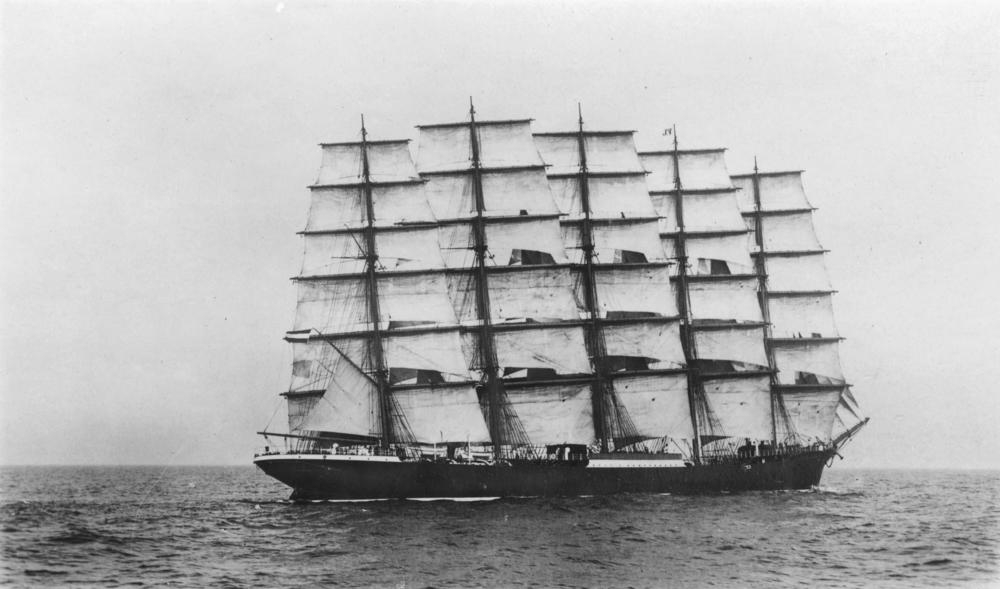
Alessandro Di Benedetto, who is also called the Crazy Italian, has a special world record on his name. He circumnavigated the world in the smallest sailboat: a 21' (6.5 m). It took him 268 days and 19 hours, which is not very fast.
But it's an impressive accomplishment, especially seen the fact that he's been dismasted around Cape Horn. To deal with his dismating, he made a junk rig that got him all the way back to France, finishing his world-record attempt successfully.
Most boats can't go faster than the speed of the wind. But some racing yachts and most multihulls can. The reason is two-fold.
The reason it's possible is that boats generate their own wind, allowing them to 'surf their own wave' so to speak, increasing their speed.
Secondly, keelboats have a displacement hull: they push the water forward, which means they have to deal with resistance, and this resistance increases when the speed increases.
But this isn't a problem with the rise of multihulls. Multihulls use flat beds instead of a keel, which means the hulls are floating on top of the water surface. This allows them to go much faster, since they don't have to deal with water resistance.
Want to know how to calculate the hull speed of any boat ? If you're like me and like to nerd out about these kinds of things, I definitely recommend to go check out my article on the average speed of sailboats (opens in new tab).
During the Anglo-Dutch wars (1652-1674) the British wanted to replace the Dutch as the dominant naval power. The Dutch admiral De Ruyter and Grand Pensionary DeWitt came up with a flag signaling system to outmaneuver the British. It was a success.
To be fair, this is more of fun trivial knowledge, and not so much a sailing fact. Consider it a bonus fact:
Ching Shih (which literally means 'widow of Zheng') was the mightiest pirate that ever lived. She had over 300 junks under her command. The ships were manned by between 20,000 - 40,000 men, women, and children. She fought major naval powers, such as the British Empire, Portuguese, and the Qing dynasty.
She's without doubt the most successful pirate ever. Unlike many others, she wasn't executed, but actually died as a free woman in her own home. Quite the story.
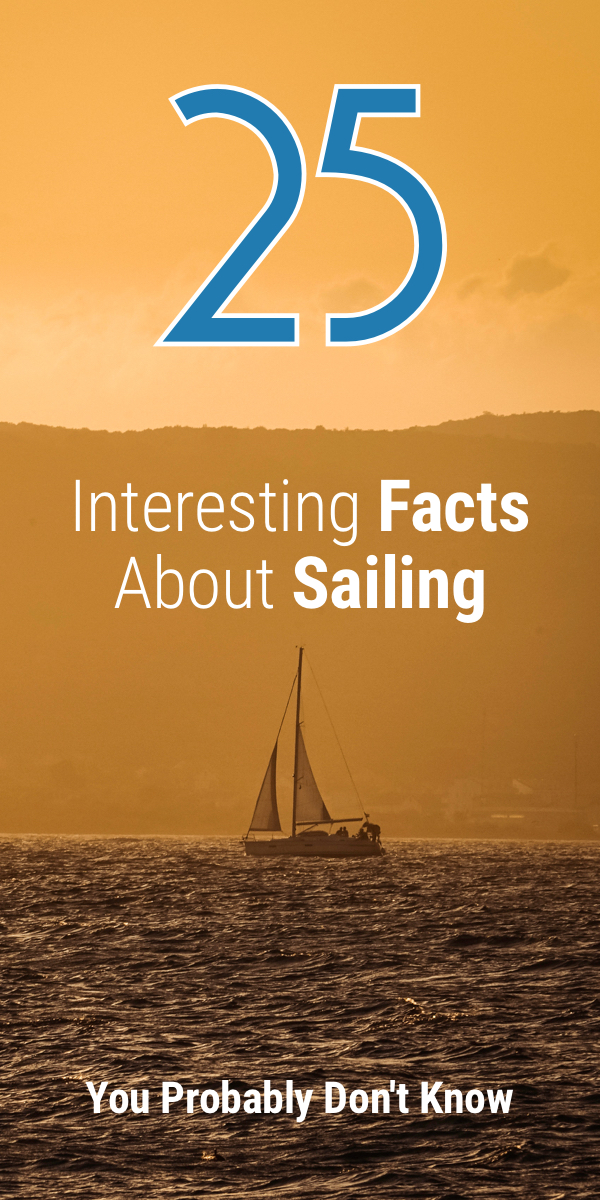
read your 25 facts. excellent, interesting, short to the point, really unknown and enlightning facts that made me curious and search more info. thanks!
Shawn Buckles
Hi Miki, thanks and great to hear you’ve enjoyed the article. You’re welcome!
Wayne Hughes
Hi Miki, Tonight we have our local small sailing club Annual Prizegiving - I am the MC - Sincere Thanks for your research and article as they will give interesting facts to be sprinkled throughout the evening.
Narrabeen Lakes Sailing Club - Sydney, Australia - 115 years old this year
Ray Bradley
Very interesting reading,with some humour thrown in. Thankyou
I JUST WANTED TO SAY I WAS DOING MY HOMEWORK AND I was sooo happy to find out I got good grades thank to this website I give it a 👍🏻
Leave a comment
You may also like, 13 reasons why sailing is better than powerboating.
Want to know why sailing trumps powerboating? In this article I'll give you 13 clear-cut reasons why it's the case - and why I'll never go back.
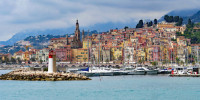
9 Practical Tips & Locations for Sailing the Mediterranean
Own your first boat within a year on any budget.
A sailboat doesn't have to be expensive if you know what you're doing. If you want to learn how to make your sailing dream reality within a year, leave your email and I'll send you free updates . I don't like spam - I will only send helpful content.
Ready to Own Your First Boat?
Just tell us the best email address to send your tips to:

Facts About Sailboats
The sailboat is one of the most popular and enduring types of vessel ever created. Whether you’re an experienced sailor or you’ve never set foot on a boat in your life, there’s something about a sailboat that just inspires awe.
In this article, we’re going to explore 10 amazing facts about sailboats that you may not know. From the tallest sailing ship ever built to the fastest speed ever achieved by a sail-powered vessel, we’re going to cover some truly impressive feats by these nautical wonders.
So whether you’re looking for some new trivia to impress your friends with or you’re just curious about these amazing vessels, read on for our top 10 facts about sailboats!
Top 10 Facts About Sailboats
The ideal wind speed for sailing is between 8-12 knots.
The ideal wind speed for sailing is between 8-12 knots. This is because the boat needs to be able to move through the water, but also because the wind needs to be strong enough to fill the sails. If the wind is too strong, the sails can be damaged, and if the wind is too weak, the boat will not move.
You Can Operate A 100′ Sailboat Alone
You can operate a 100′ sailboat alone, but it’s not recommended. If you must go it alone, be sure to have plenty of experience and be comfortable with the boat and the conditions.
Historical Sailboats Are Often Misrepresented
Historical sailboats are often misrepresented in popular culture. They are often portrayed as sluggish and old-fashioned, when in reality they were cutting-edge technology in their day.
This is a shame, because historical sailboats are fascinating vessels that offer a window into the past.
If you’re interested in learning more about historical sailboats, I highly recommend doing some research. There are a variety of excellent books and articles out there that can provide you with a more accurate picture of these fascinating vessels.
The World-Record Sailing Speed Is 65.45 Knots (75 Mph)
The world-record sailing speed is 65.45 knots (75 mph). This is an incredible feat, and it’s a testament to the power of wind and the skill of the sailor.
To put it in perspective, the world-record speed for a car is about 763 mph. So, the sailing speed record is about 10% of the car speed record. That’s pretty impressive!
You Can Sail For Nearly 22,229 Miles In A Straight Line
This is an incredible feat, and one that is achievable with the right sailboat. With the right equipment and provisions, you can embark on an adventure that will take you across the globe. All you need is a little bit of wind and a lot of determination.
The Most Popular Sail Rig Is Based Off A Moorish Lateen Rig
The most popular sail rig is based off a Moorish Lateen rig. This rig is characterized by its triangular sail, which is attached to a long yardarm.
The yardarm is attached to the mast at its midpoint, and the other end of the yardarm is attached to the boom. The boom is then attached to the mast at the base of the mast.
This type of sail rig is very popular because it is very efficient. The long yardarm provides a lot of leverage, which makes the sail easier to control. The triangular sail also provides a lot of sail area, which makes the rig very powerful.
The Smallest Boat To Sail Around The World Was 21 Feet
The smallest boat to sail around the world was 21 feet. This is an amazing feat, and it proves that size doesn’t matter when it comes to sailing the world.
This boat was crewed by one person, and it sailed for over two years. This just goes to show that if you have the passion and the will, you can achieve anything.
Sailboats Can Sail Faster Than The Speed Of The Wind
Sailboats can sail faster than the speed of the wind. This is because the wind blowing against the sails propels the boat forward.
The sails act like a giant wing, and the wind pushes against them to move the boat. The faster the wind is blowing, the faster the boat can go.
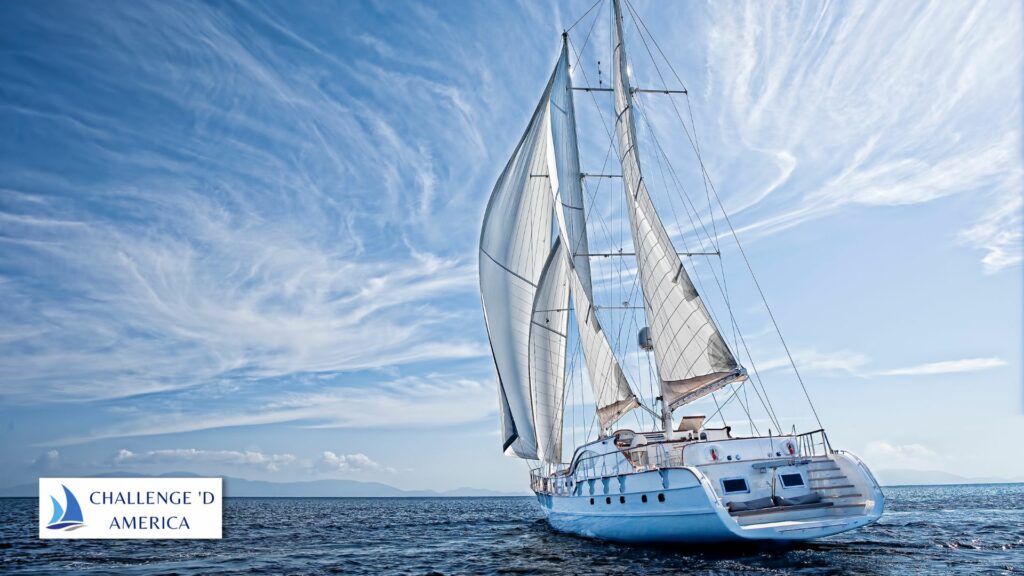
Some people believe that sailboats can only go as fast as the wind. However, this is not true. Sailboats can actually sail much faster than the speed of the wind. This is because the wind blowing against the sails propels the boat forward.
So, next time you’re out on the water, remember that your sailboat can go much faster than the speed of the wind. And if you’re ever in a race, you now know that you have a secret weapon up your sleeve.
The Sailing Flags Originate From The Dutch War Efforts Against The British
During the Dutch War of Independence from the Spanish Empire (1568-1648), the Dutch Republic used a variety of flags to identify their ships. These flags were designed to confuse and mislead the enemy, and they were very effective.
The British, who were the main opponents of the Dutch during this period, were often unable to determine which ships were friend or foe.
One of the most famous of these flags is the red, white, and blue tricolor. This flag was first used by the Dutch Republic in 1572, and it quickly became the most recognized symbol of the Dutch state. The tricolor is still used today as the national flag of the Netherlands.
Another famous flag from this period is the orange-white-blue tricolor. This flag was used by the Dutch Prince of Orange, who was the leader of the Dutch revolt against the Spanish. The flag was later adopted by the Dutch Republic as a symbol of the Orange dynasty.
The orange-white-blue tricolor is also the national flag of the Netherlands today.
The Mightiest Pirate Was A Female Chinese Prostitute
When it comes to sailing, there are a lot of fascinating facts and stories out there. For example, did you know that the mightiest pirate was actually a female Chinese prostitute?
That’s right – according to legend, the most feared pirate on the high seas was a woman named Ching Shih. She was said to be incredibly ruthless, and her fleet of ships was a force to be reckoned with.
Interestingly, Ching Shih eventually retired from piracy and became a businesswoman. She opened a gambling house and brothel in Guangzhou, which was said to be very successful.
So next time you’re out sailing, remember that you could be following in the footsteps of one of the most fearsome pirates in history!
Fun Facts About Sailboats
1. Sailboats have been around for thousands of years and are one of the oldest types of boats in existence.
2. Sailboats were originally used for transportation, but now are mostly used for recreation.
3. Sailboats come in all shapes and sizes, from small dinghies to large yachts.
4. Sailboats are powered by the wind, using sails to catch the wind and propel the boat forward.
5. Sailboats can be sailed solo or with a crew.
6. Sailboats are typically used in calm waters, but can be sailed in all types of weather conditions.
7. Sailboats can be used for racing or cruising.
8. Sailboats require some maintenance, but are otherwise relatively easy to care for.
9. Sailboats can provide a lifetime of enjoyment, whether you sail them yourself or just watch them sail by.
10. Sailboats are a great way to enjoy the outdoors and the beauty of the water.
Historical Facts About Sailboats
1. The first sailboats were used by the Egyptians for transportation along the Nile River.
2. Sailboats were also used by the Phoenicians for trade and transportation.
3. The first recorded use of a sailboat in warfare was by the Carthaginians during the First Punic War.
4. Sailboats were used by the Vikings for exploration and transportation.
5. Christopher Columbus used a sailboat on his voyage to the New World.
6. Sailboats were used by early settlers in the United States for transportation and trade.
7. Sailboats are still used today for recreation and transportation.
Facts About Uses Of Sailboats
Sailboats have a long and rich history, dating back to the early days of human civilization. Today, they are still used for a variety of purposes, from recreation to transportation.
Here are some facts about the uses of sailboats:
1. Sailboats were first used for transportation, and they continue to be used for this purpose today.
2. Sailboats are also popular for recreational purposes, such as sailing, racing, and cruising.
3. Sailboats can be used for a variety of other purposes as well, such as fishing, diving, and even hosting parties.
4. Sailboats come in a variety of sizes and shapes, from small dinghies to large yachts.
5. Sailboats can be powered by wind, motor, or a combination of both.
Whether you’re looking to get away from it all or just enjoy a day on the water, sailboats offer a unique and enjoyable experience. So get out there and explore the world on a sailboat today!
Conclusion On Facts About Sailboats
Sailboats are one of the most popular types of boats for both recreational and competitive sailing.
There are many different types and sizes of sailboats, from small dinghies to large yachts. Sailboats are designed to harness the wind to power them through the water.
Sailing is a popular sport and there are many different competitive classes of sailboats. Sailboats are also popular for recreation, cruising, and racing.
There are many different types of sailboats, each with its own unique design and purpose. Whether you are looking for a boat to race or just to enjoy a day out on the water, there is a sailboat that is perfect for you.
Similar Posts
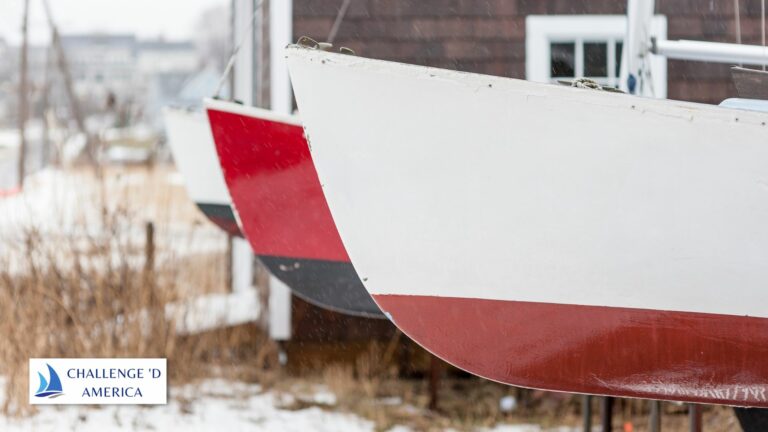
How To Winterize A Sailboat?
As we all know, winter is coming. And for those of us who love sailing, that means it’s time to start thinking about how to winterize our sailboats. There are a few different things you need to do to winterize a sailboat, and in this article, we’ll go over all of them. So whether you’re…

How Do You Properly Store And Maintain A Sailboat During The Off-Season?
As a sailing enthusiast, I know how important it is to properly store and maintain a sailboat during the off-season. It’s essential to preserving the integrity of the vessel and ensuring its longevity. With the right steps, you can enjoy your sailboat for many seasons to come. In this article, I’ll share with you my…
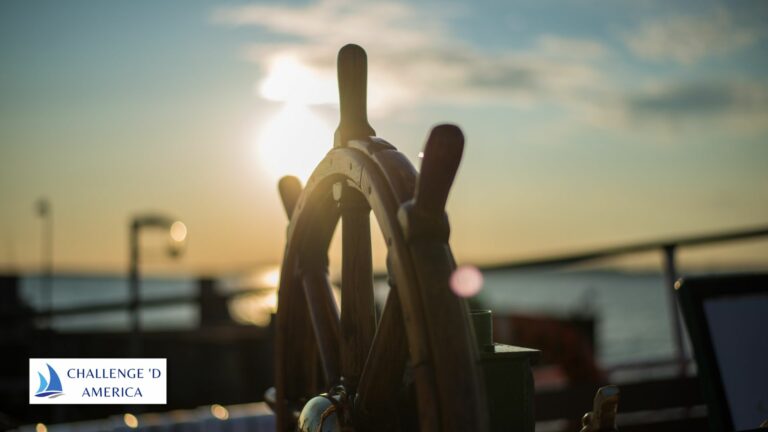
Rudder Types For Sailboats
As a sailor, you know that the type of rudder on your boat can have a big impact on its performance. There are several different types of rudders available for sailboats, each with its own advantages and disadvantages. In this article, we’ll take a look at some of the most popular rudder types and see…
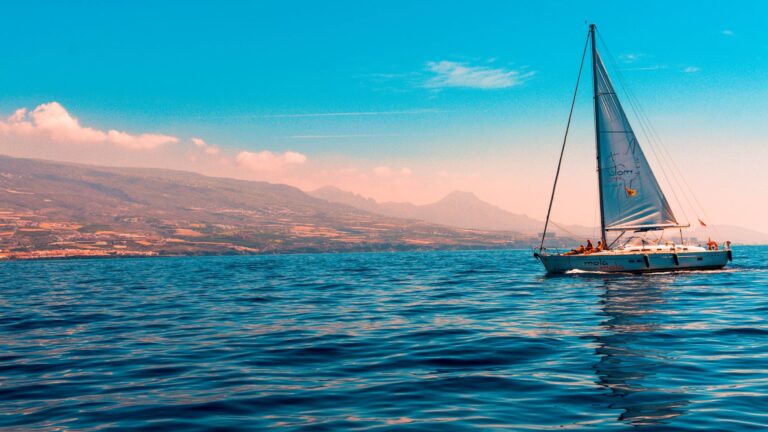
What Is The Minimum Size Sailboat For Ocean?
The Minimum Size Sailboat for an Ocean Crossing Whether you’re a budding sailor or an experienced voyager, choosing the right size sailboat for an ocean crossing is essential to ensure a safe and enjoyable experience. It’s important to understand the different types of boats available and their associated benefits and drawbacks before making your selection,…
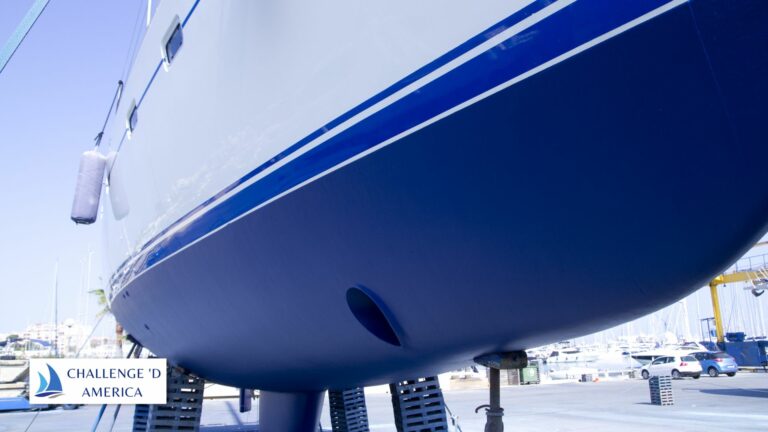
Sailboat Paint / How To Paint A Sailboat?
Are you thinking about repainting your sailboat? If so, you’ll want to read this article by Gary Jobson. In it, he outlines the steps you’ll need to take to ensure a beautiful, long-lasting finish. You’ll learn about the different types of paint available and how to choose the right one for your boat. Gary also…

Boating Equipment Checklist
I’m here to talk to you about the essential items and equipment you need to check before heading out on the water. Whether you’re a seasoned sailor or a beginner, it’s important to make sure you have the right gear and equipment for your boating trip. To help you out, we’ve compiled a comprehensive boating…
Leave a Reply Cancel reply
Your email address will not be published. Required fields are marked *
Save my name, email, and website in this browser for the next time I comment.
111 Facts About Sailboats For The Budding Sailor In You

Fun Facts About Sailboats
Historical facts about sailboats, facts about sailboats racing, facts about uses of sailboats.
A sailboat, as the name suggests, is a boat that is mainly operated with the help of sails and may or may not be motorized.
Depending on the purpose and the region where they are found, sailboats can be designed to meet various requirements. Having a rich historical background and popular association to perhaps one of the most well-known sports, sailboats have more to them than what meets the eye.
Developed in olden times, with a pretty basic design and purpose, to navigate the seas and oceans by manipulating the sails, sailboats today use modern technologies to be developed and operated. Whether it is to engage in competitive racing, to help with maritime trade, or just to take it out and enjoy cruises during the summer, to chill with friends and family with the sun shining bright and the wind flowing through your hair, a sailboat has various fun uses that can be enjoyed by all. We will go through some fun and educational sailboat facts and afterward, also check out our facts about why do boats float and the history of boats .
There is a lot that can be learned about sailboats but we thought we'd start out with some fantastically fun facts:
- The famous phrase 'feeling blue' originated on the ocean on a sailboat. The term originated when one sailboat lost its captain while on a voyage, leading other sailors to sail blue flags to note their mourning.
- This practice to sail blue flags became popular during sea voyages, and later, the phrase feeling blue came to be used in the English language to describe feeling sad.
- It is easier to sail eastward because the calculation of wind and currents is more predictable than when sailing westwards.
- Another phrase invented while sailing was 'loose cannon'. Cannons aboard boats used to be extremely heavy, weighing over 3000 lb (1360.8 kg). If and when one was loose, it ran the risk of severely damaging the ship, perhaps by creating a hole and letting the water in, which would ultimately sink the tall ship. So, just as a loose cannon is dangerous for a ship, similarly, a person who is a loose cannon is also tricky, therefore bringing the phrase into the English language.
- There is an ideal sailing speed. Yes, that is right, like with cars, even sailing boats have superior sailing speeds. In the case of sailboats, this varies based on a lot of factors such as the boat’s capacity, hull design and structure, and more, but as a general standard, 8-12 knots, which roughly equals 8-12 mph (12.9-19.3 kph), is suggested as the ideal sailing speed.
- While most sailors stick to operating a 35 ft (10.7 m) boat alone, a world record has been awarded to Francois Gabart for using a 100 ft (30.5 m) sailboat all on his own. This is not an easy task and requires a lot of training and mental agility.
- Solo sailing is also termed short-handed sailing. The reason behind this name is that when sailing solo, sailors need to rig all of the systems and sheets in their cockpit to easily manipulate other sections while they steer the ship how they want.
- Jessica Watson of Australia was the youngest sailor ever to circumnavigate the Earth. She did this just before her 17th birthday.
- Laura Dekker of the Netherlands broke Jessica’s record at 16 years and 123 days of age when circumnavigating the world solo.
- Spending so much time on the ocean in a boat gave rise to many sailing superstitions and stories. One of the most commonly known superstitions was that whistling during a voyage was terrible luck. Except for the ship’s cook, no one else on the ship’s crew was allowed to whistle as it was believed to invite solid and destructive winds.
- Another popular superstition was that bananas on board were terrible luck. This superstition was prevalent on fishing boats as fishers thought that they would not catch fish on a voyage if there were bananas on board.
- Cats, on the other hand, were a sign of good luck. This belief was so popular that it was even seen in Viking history. Sailors would adopt cats, seeing them as a sign of good luck.
Sailboats were invented around 4000 BC by the Egyptians and Phoenicians. A fundamental design of using a square cloth, tied to a wooden log, attached to a narrowboat was used ever since the creation of both the sail and the boat. They have, however, undergone massive changes in the originating regions and other parts of the world.
- There were no large sailboats or sailing ships until the renaissance period. Before this, while there were a lot of sailboats, and they were growing trendy very quickly, the architects of the time were not able to properly design a correctly functioning large sailboat or sailing ship.
- During the 14th century, Jeanne de Clisson, a French woman belonging to a noble family, was known to use the sailing route through the English channel for 13 years, killing voyagers and causing damage to French ships, as revenge for the murder of her husband. She became the captain of a fleet consisting of black ships with red sailing flags and named it My Revenge.
- Sailing has been an Olympics sport since the 1800s. One of the longest-running Olympic sports, sailing was first introduced to the Olympics in 1896 and has since been included in all Olympic and other major sporting events, including the current world Olympic sports. However, it was not included in the 1904 Summer Games.
- The first person who sailed solo across the world was Joshua Slocomb. He hailed from Nova Scotia and circumnavigated across the world in 1898, making himself the first person to sail solo across the world. He authored a book describing his adventure, which was a bestseller.
- The world’s smallest sailboat was constructed by a Polish sailor named Szymon Kuczynski, who created a sailboat that was barely 20 ft (6.1 m) long. He even took a journey around the world in this boat.
As has already been mentioned, sailboat racing and the use of sailboats in sports is very popular so we thought we'd check out some interesting facts about sailboat racing:
- Sailboats do not move very fast but are highly efficient for any type of sailor. With a maximum speed of four to six knots, equivalent to 4-7 mph (6.4-11.3 kph), they are pretty slow but can continue the journey throughout the day and night, making them very efficient.
- However, this does not apply to all sailboats. Multihull sailboats can achieve higher speeds at sea.
- Sailboat racing is an extreme sport. When done on a vast scale, there is even the risk of drowning, dying, or getting lost at sea. When done on a small scale, perhaps locally, such chances are almost zero.
- Paul Larson of Australia set the fastest sailing speed world record of 65.45 knots or 75 mph (120.7 kph).
- The women’s fastest world record sailing speed is 37.6 knots, achieved by Heidi Ulrich.
- A trendy sailing sport, the Regatta is conducted following the Racing Rules of Sailing.
Sailboats have multiple uses. Most commonly, they are used to travel to far-off places, particularly islands, which are quite a distance from the land and where there is no other way to reach. It provides an opportunity for tourists to visit new places which might not otherwise be accessible.
- Historically, sailboats and ships have been used widely for their ease in conducting trade and commerce. Even today, ships carrying cargo are a primary source of promoting and aiding international trade and business.
- When sailboats were used to carry women from one place to another, they often gave birth on board. In cases where no one aboard the ship claimed a newly born boy, his name would be registered in the ship's log as 'son of a gun'.
- The History Supreme is probably the most expensive sailboat in the world.
Here at Kidadl , we have carefully created lots of interesting family-friendly facts for everyone to enjoy! If you liked our suggestions for 111 Facts about sailboats for the budding sailor in you then why not take a look at Viking longship facts , or Coral Princess ship facts ?
We Want Your Photos!
More for you, national biographer's day.
Bachelor of Science specializing in Computer Science
Christian Mba Bachelor of Science specializing in Computer Science
Christian Mba is an experienced blogger and content writer with over a decade of experience. He holds a Bachelor of Science degree in Computer Science from Nigeria and has a keen interest in Python programming. Along with his writing and blogging expertise, he is also an SEO specialist with more than six years of experience. Chris, as he is commonly known, has a passion for music and enjoys playing the piano.
1) Kidadl is independent and to make our service free to you the reader we are supported by advertising. We hope you love our recommendations for products and services! What we suggest is selected independently by the Kidadl team. If you purchase using the Buy Now button we may earn a small commission. This does not influence our choices. Prices are correct and items are available at the time the article was published but we cannot guarantee that on the time of reading. Please note that Kidadl is a participant in the Amazon Services LLC Associates Program, an affiliate advertising program designed to provide a means for sites to earn advertising fees by advertising and linking to Amazon. We also link to other websites, but are not responsible for their content.
2) At Kidadl, we strive to recommend the very best activities and events. We will always aim to give you accurate information at the date of publication - however, information does change, so it’s important you do your own research, double-check and make the decision that is right for your family. We recognise that not all activities and ideas are appropriate for all children and families or in all circumstances. Our recommended activities are based on age but these are a guide. We recommend that these ideas are used as inspiration, that ideas are undertaken with appropriate adult supervision, and that each adult uses their own discretion and knowledge of their children to consider the safety and suitability. Kidadl cannot accept liability for the execution of these ideas, and parental supervision is advised at all times, as safety is paramount. Anyone using the information provided by Kidadl does so at their own risk and we can not accept liability if things go wrong.
3) Because we are an educational resource, we have quotes and facts about a range of historical and modern figures. We do not endorse the actions of or rhetoric of all the people included in these collections, but we think they are important for growing minds to learn about under the guidance of parents or guardians.
google form TBD
- Español NEW
Sailboat facts for kids
A sailboat , sailing boat or yacht is a boat that has sails . Wind blows against the sails, pushing the boat through the water. The word covers many kinds of boats, from small sailboards to large sailing ships . Usually, a sailboat has two sails: a mainsail and a head sail or jib. When the wind blows from behind, there can be used an extra sail, a spinnaker.
Images for kids
Although sailboat terminology has varied across history, many terms have specific meanings in the context of modern yachting. A great number of sailboat-types may be distinguished by size, hull configuration, keel type, purpose, number and configuration of masts, and sail plan.
Popular monohull designs include:
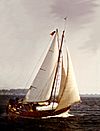
The cutter is similar to a sloop with a single mast and mainsail, but generally carries the mast further aft to allow for a jib and staysail to be attached to the head stay and inner forestay, respectively. Once a common racing configuration, today it gives versatility to cruising boats, especially in allowing a small staysail to be flown from the inner stay in high winds.
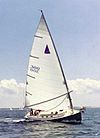
A catboat has a single mast mounted far forward and does not carry a jib. Most modern designs have only one sail, the mainsail; however, the traditional catboat could carry multiple sails from the gaff rig.
A dinghy is a type of small open sailboat commonly used for recreation, sail training, and tending a larger vessel. They are popular in youth sailing programs for their short LOA , simple operation and minimal maintenance. They have three (or fewer) sails : the mainsail , jib , and spinnaker .

Ketches are similar to a sloop, but there is a second shorter mast astern of the mainmast, but forward of the rudder post. The second mast is called the mizzen mast and the sail is called the mizzen sail.

A schooner has a mainmast taller than its foremast , distinguishing it from a ketch or a yawl. A schooner can have more than two masts, with the foremast always lower than the foremost main. Traditional topsail schooners have topmasts allowing triangular topsails sails to be flown above their gaff sails; many modern schooners are Bermuda rigged.
The most common modern sailboat is the sloop, which features one mast and two sails, typically a Bermuda rigged main , and a headsail . This simple configuration is very efficient for sailing into the wind.
A fractional rigged sloop has its forestay attached at a point below the top of the mast, allowing the mainsail to be flattened to improve performance by raking the upper part of the mast aft by tensioning the backstay. A smaller headsail is easier for a short-handed crew to manage.
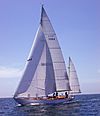
A yawl is similar to a ketch, with a shorter mizzen mast carried astern the rudderpost more for balancing the helm than propulsion.
Traditional sailboats are monohulls, but multi-hull catamarans and trimarans are gaining popularity. Monohull boats generally rely on ballast for stability. This creates two problems; one, it gives the monohull tremendous inertia, making it less maneuverable and reducing its acceleration. Secondly, unless it has been built with buoyant foam or air tanks, if a monohull fills with water, it will sink.
Multihulls rely on the geometry and the broad stance of their multiple hulls for their stability. Some multihulls are designed to be as light-weight as possible. They can be built with foam-filled flotation chambers and some modern trimarans are rated as unsinkable, meaning that, should every crew compartment be completely filled with water, the hull itself has sufficient buoyancy to remain afloat.
All vessels have a keel , it is the backbone of the hull. In traditional construction, it is the structure upon which all else depends.
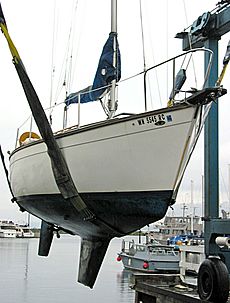
Most modern monohull boats have fin keels, which are heavy and deep, but short in relation to the hull length. More traditional yachts carried a full keel which is generally half or more of the length of the boat. A recent feature is a winged keel, which is short and shallow, but carries a lot of weight in two "wings" which run sideways from the main part of the keel. Even more recent is the concept of canting keels, designed to move the weight at the bottom of a sailboat to the upwind side, allowing the boat to carry more sails.
Multihulls, on the other hand, have minimal need for such ballast, as they depend on the geometry of their design, the wide base of their multiple hulls, for their stability.
On small sailboats, masts may be "stepped" (put in place) with the bottom end in a receptacle that is supported above the keel of the boat or on the deck or other superstructure that allows the mast to be raised at a hinge point until it is erect. Some masts are supported solely at the keel and laterally at the deck and are called "unstayed". Most masts rely in part or entirely (for those stepped on the deck) on standing rigging, supporting them side-to-side and fore-and aft to hold them up. Masts over 25 feet (7.6 m) may require a crane and are typically stepped on the keel through any cabin or other superstructure.

Sailboat on Lake Constance , Germany.

Bermuda rigged sloop at Convict Bay, Bermuda , circa 1879
- This page was last modified on 16 October 2023, at 16:53. Suggest an edit .
- Paddle Board

A Complete Guide to Sailboats: All You Need to Know!
While motorboats are the preferred choice for watersports , they are loud, noisy, and don’t offer you the best experience for a clam boating experience. However, the sailboat provides a serene sailing experience that’s quiet, relaxing, offering you plenty of fun on the water.
Sailboats come in a wide variety of configurations, lengths, and features, giving you passenger capacities from one person to 15-people or more, depending on the size of the model. Learning to sail is a skill all watermen should have in their repertoire; it’s the original form of boating and a highly sought-after skill.
This brief guide to sailboats gives you everything you need to know about choosing the right sailboat for your aquatic adventures.

What is a Sailboat?
A sailboat is a broad term defining many different boats. There are several categories of sailboats with plenty of sail options. The types of sails define your boat, and here are the most popular choices for these watercraft.
- The modern sloop, featuring a single mast and two sails.
- The macaroni or Bermuda rig offers tall triangular-shaped sails.
- A racing sloop for higher speeds and competitive sailing.
- The masthead sloop, with the jib reaching to the end of the masthead.
- The fractional sloop rig features a proportionately larger mainsail and smaller jib.
- The single-sail cat rig.
- The ketch rig features a smaller mast aft, also known as a mizzenmast.
- The yawl is similar in design to a ketch rig.
- The schooner featuring two to four masts positioned further forward in the boat.
While these are the most common sail types, several others are less common with modern sailing techniques. The topsail featuring multi-flying jibs are better suited to long journeys, and many recreational sailors aren’t going to be out on the water for months at a time.
The rule of thumb is that the larger the sail and the more sails you have, the bigger the crew required to operate the boat. However, if you’re looking for a solo rig, there are plenty of smaller options available.
The Laser is an excellent example of a popular single-person sailboat designed for recreational and competitive use. These boats make the ideal starter vessel for someone who’s learning the ropes of sailing.

Different Types of Sailboats
Sailboats rely on the wind to power the vessel through the water. However, there are those days on the lake or ocean where the wind is flat. As a result, most sailboats come with small outboard or trolling motors to power them through the water on windless days.
You have several options for sailboat design, with the most popular options being the following.
The catamaran uses two hulls to power the boat through the water, offering less drag and faster sailing speeds. They are often the choice for professional racing boats, allowing the vessel to cut through rough seas.
These boats also come in luxury models allowing for spending days or weeks out on the water. The most advanced models will also feature hydrofoils that lift the hull out of the water at high speeds, providing more stability, less drag, and higher cruising speeds.
The beach catamaran operates with a sail, while the cruising model relies on an outboard motor for a backup to the sail on calm days.

Cruising Sailboat
The cruising sailboat features a design for covering long distances on the ocean. The cruiser will offer you the benefits of long-term liveaboard conditions, featuring luxury accommodations and amenities like full kitchens, heads, and bedrooms.
As the name implies, the daysailer is suitable for day trips out on the ocean or the lake. These models feature a multi-hull or monohull design, and some come with sleeping accommodations.
Due to the smaller size of these vessels, they are often trailerable, providing easy transport between launch locations. The motorsailer gives you the advantages of the daysailer, with an additional engine for powering the boat on windless days out on the water.
The daysailer will also feature amenities like a kitchen and head, and they often come with sleeping accommodation.
Racing Sailboat
The racing sailboat or yacht offers you a competitive vessel focusing on speed and maneuverability. Many models come with lightweight carbon fiber designs for higher speeds and hull stability when cutting through the water.
Most models also feature hydrofoils that lift the hull from the water, providing stable cruising speeds and fast sailing.
These boats are not suitable for beginners, and they require a competent, experienced team. You get full amenities, but they are more bare-bones, and don’t expect any luxury features because they need to save on weight with the design.
Sailing Dinghy
The sailing dinghy is a small sailboat suitable for one or two people. They are not ideal for open-ocean use as they present a sinking risk in rough water conditions.
However, they are great for learning how to sail, and many models come with a single-person operation for easy sailing. It’s a great boat for building your sailing skills in preparation for a larger model.
Kiteboards and Windsurfers
Kiteboards and windsurfers aren’t technically boats, but they rely on wind power for operation. They are a great choice for a sporty time out on the water and suitable for freshwater and ocean use.

The Fastest Sailing Boats
While they don’t have motors, and can’t reach the same speeds as powerboats, sailing yachts can reach high speeds in favorable wind conditions. If you have the need for speed with your sailing, then try one of the following models for a thrilling experience on the water.
The fastest sailboats include the following models.
- Specialized high-performance boats (up to 65-knots)
- Kiteboards and Windsurfers (50-knots)
- Hydrofoil monohulls (50-knots)
- Hydrofoil multi-hulls (44-knots)
- High-performance multi-hull boats (20-knots)
- Offshore racer monohulls (less than 20-knots)
The hydrofoil technology found in more expensive models lifts the hull from the water as the boat engages its top-end speed. The foil adds a smooth sailing experience that’s unlike any other hull type when engaged.
How Much Does a Sailboat Cost?
Sailboats come in various models, from small single-person models to boats requiring a full crew to operate. The cost of the vessel depends on the design materials (carbon fiber models are the most expensive), the length of the boat, the sail design, accessories and amenities, and the manufacturing brand.
Small to mid-sized boast can cost anything from $10,000 to $80,000, with sports models costing up to $150,000. Luxury models with longer lengths and sports cats can cost you anywhere up to $500,000 or more, depending on the features.

Benefits of Sailboats
The sailboat has plenty of advantages out on the water. Here are some of the top benefits of sailboats.
Quiet Sailing
Sailboats rely on the sail to power the vessel. As a result, you get no motor noise, and you can enjoy the sound of the ocean as you sail along. Some models come with motors to propel the boat if it’s a calm day with low winds.
Live Aboard
Most larger models come with V-berths and living accommodations for spending several days out on the water. The type of accommodations varies from basic in racing models to pure luxury in cruisers. However, the luxury models will add dollars to the price tag, depending on your customizations.

Trailerable
The smaller models of sailing boats are easy to trailer. The Laser is a good example, with easy trailering suitable for a single person to navigate.
Multiple Sizing Options
Sailboats come in designs and lengths to suit any activity out on the water. Whether you want a boat to cruise the lakes by yourself or tackle the oceans with a crew, there is a model to suit your needs.
Disadvantages of Sailboats
The sailboat offers you a fantastic cruising experience out on the water. However, these boats do come with a few drawbacks.
Smaller Motors
Since the boat relies on the sail to do the work, most models don’t come with large backup motors. You can expect low-power outboards or trolling motors to power the vessel when the wind is low.
Large Models Don’t Suit Trailers
The large sailboats over 30-feet don’t suit trailers. The larger keels and foils on these boats mean that they can’t reach shallow waters. As a result, you need a professional towing service to take the boat from the marina to the shipyard for repairs or alterations.

Not Suitable for Watersports
While some sailboats might be okay for diving, they are not suitable for watersports like skiing, tubing, and wakeboarding.
Expensive Customizations
Some of the high-end luxury models come with so many customizations your head will spin. It’s important to set your budget when looking at sailboats, or you could end up spending more than you expect on the customizations and accessories for these boats.
Sail Repairs
If your sail is up in stormy conditions, you run the risk of tearing the material. Sails can be costly to replace or repair, and it may take weeks to find the right sailor to make the repair, keeping your boat out of the water.
Top Sailboat Brands & Models
There are dozens of sailboat brands and hundreds of models available. We chose the following sailboats as the best option for your first boat.
Bavaria C57
The Bavaria C57 is the company’s flagship model, offering you a sleek, streamlined version of the cruiser-line model.

This boat features a design from Maurizio Cossutti. It comes with a smooth hull featuring nanotechnology to help the boat glide through the water effortlessly. The vinyl ester resin construction is durable and lightweight, adding speed to the boat in good wind conditions.
You get twin helms and dual rudders, along with a huge drop-down transom. This model comes with some surprising accessories, including a grill and refrigerator in the boat’s aft for fun on the water.
You have three lounges on the deck, with a large cockpit for the crew and captain.
X-Yachts X4.6
The X-Yachts X4.6 model is a performance cruiser offering you a vacuum-sealed epoxy hull for lightweight strength and durability. The boat comes with the signature galvanized steel grid found on X-Yacht models adding strength and rigidity to the frame for use in rough water conditions.

The boat features a self-tacking jib for easy coming about and total control of the vessel in turns. You get twin helms and an open cockpit design for racing or cruising. This model also includes a dedicated locker for a life raft under the cockpit bench on the vessel’s starboard side.
Beneteau Oceanis 30.1
The Beneteau Oceanis 30.1 is easy to sail, with a setup that suits any sailing style. This boat is a classic, offering purists a fantastic option for their sailboat. You get twin rudders with a fixed spirit, a plumb bow for fine entry, and a backstay-free rig accommodating a square-top design for easy sailing.

This model is a great choice for overnight sailing trips, offering you two full-size cabins kitted with luxury finishes. There are saloon benches that double as a berth, and you get an astounding 6’6″ of headroom below deck in the berth.
You also have the choice of a tiller or steering wheel for a truly authentic sailing experience purists will appreciate. You also have options for a swing keel version allowing for easy sailing along rivers and canals without the threat of hitting submerged rocks or logs or running the vessel aground.
This sailboat is the best choice for beginners. You get an easy-to-manage sail configuration that teaches you the basics of sailing and enough space on the boat for two people.
This model is a great choice for an affordable entry-level sailboat with a fiberglass design for lightweight movement and speed and the option of sailing the boat along with its user-friendly rigging system.
Wrapping Up
Whether you’re a purist, modern sailor, or competitor, you’ll find that there’s a sailboat model to suit your needs and sailing style. These boats offer you the most authentic experience when out on the water, and you don’t have to worry about filling up the gas tank to get home.

John is an experienced journalist and veteran boater. He heads up the content team at BoatingBeast and aims to share his many years experience of the marine world with our readers.
A Complete Guide to Micro Skiffs: All You Need to Know!
A complete guide to narrow boats: all you need to know, a guide to aluminum fishing boats.
Comments are closed.
Type above and press Enter to search. Press Esc to cancel.
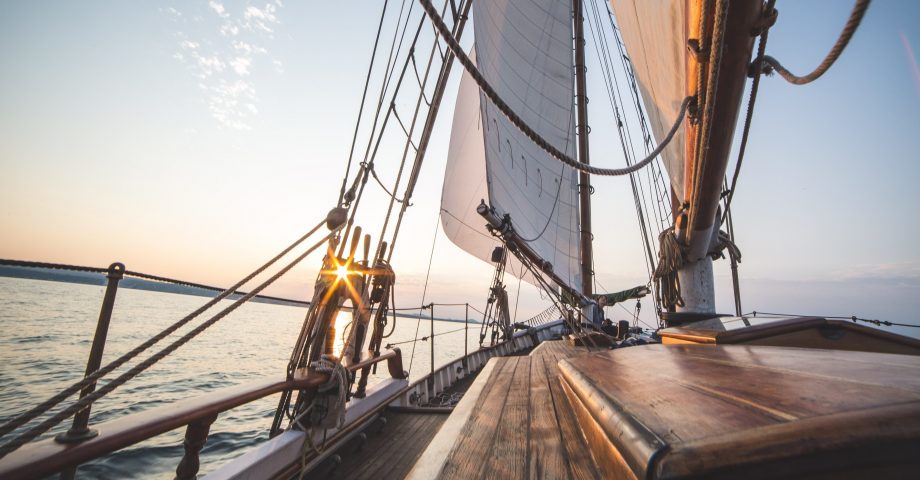
18 Satisfying Facts about Sailing
Ahoy sailor! Feeling the sun on your face, the wind in your hair, enjoying yourselves on the water… What’s not to like about sailing! It’s a very popular sport, and it has had a large influence on modern life.
Are you interested in sailing, cruising, competitive racing, or charter vacations? Worry not! There is a sailboat that’s perfect for you and a lifetime of sailing adventures awaits! Why is it a lifestyle many dream of?
Let’s feel the breeze in the air and sail along with these 18 fun facts about sailing and search out the answer!
1. Semaphore has an interesting history.
During the Anglo-Dutch wars from 1652 to 1674 the Dutch admiral De Ruyter and Grand Pensionary DeWitt came up with a successful flag signalling system that is used to this day for communication with ships and the transmission of messages that sailors can easily understand.
2. The most successful pirate of all time was female.
Ching Shih (which means ‘widow of Zheng’) was the mightiest pirate that ever lived. Her ships were operated by 20,000 – 40,000 men, women, and children. She fought major naval powers, such as the British Empire, the Portuguese, and the Qing dynasty.
3. Sailing alone isn’t unheard of.
In 1898 Joshua Slocum, a Nova-Scotia-born American became the first man to sail around the world by himself. He also wrote a book about his journey named “Sailing alone around the world” which became an international best-seller.
The second attempt was made 69 years later. So it took some time for the world to catch up, with Sir Francis Chichester completing his trip in 1967.

4. Some sailors really go all out!
Just two years later, Sir Robin Knox-Johnston became the first person to sail non-stop and single-handedly around the world. He wrote a best-selling book about his adventure: “A World of My Own”. The first ever non-stop solo round the world voyage.
5. Sailors are getting younger.
Jessica Watson from Australia and Laura Dekker from the Netherlands, both 16 after their voyages, each sailed a boat singlehandedly around the globe.
Another 16-year-old, Abby Sunderland of California, attempted a singlehanded circumnavigation in 2010 but had to be rescued after rough weather in the Indian Ocean .
6. However, it’s not all plain sailing.
The Guinness Book of World Records and The World Sailing Speed Record Council have decided not to recognise attempts for youngest circumnavigator in the future, to discourage kids from making such dangerous record attempts.
7. It’s a great way to see the world.
Sailing can give you access to off-limits tourists’ attractions. From exotic species and authentic villages to peaceful beaches and rich nature. Places like these can feel like a personal heaven for anyone fortunate enough to visit them.
Luckily, as a sailor, you have the opportunities to visit these hidden pearls.
8. Sailing has changed our vernacular.
Many terms and sayings we use every day originate from sailing. This applies to the term “feeling blue” which means that you feel sad or depressed. The saying originated from sailing, because in the past when a ship lost its captain during a voyage, the sailors would sail blue flags, indicating their loss. So if you’re feeling blue, you’re referring to the blue flags that were used to sign that the ship’s crew is in mourning.
9. So have far-flung sailing spots!
Doldrums is the name of an area of the ocean on either side of the equator. This area is known to have unstable and light wind conditions. A sailing ship caught in the Doldrums can be stranded due to lack of wind. Today the term is used to describe someone as being in low spirits, stagnated or depressed.
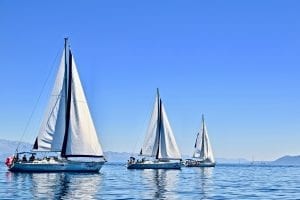
10. How fast should you sail at?
The easiest wind to maneuver small and mid-sized boats is between 8-12 knots, while still being able to reach good speeds. Anything between 5-8 knots is ideal for beginners learning to sail.
11. How long is a straight line?
You can sail in a straight line for nearly 22,229 miles…in a theory by cartographer David Cooke. Critics consider it’s impossible to navigate in a perfectly straight line, but it’s still a cool theory! According to him the Cooke Passage running around the Earth from Port Renfrew to Quebec is a sailing route you can take and finish without ever touching land.
12. Some yachts are MASSIVE.
With a length of 88m, The Maltese Falcon is the biggest sailing yacht in the world. With two 1,800 horsepower Deutz engines, it is deemed to be the most expensive sailboat in the world. It has its gym, an atrium, a VIP cabin, four guest suites with king or queen beds, and plasma screens. It 2009 it was sold for a whopping price of £60 million.
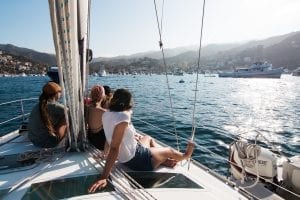
13. Some boats, meanwhile, are seriously built for speed.
In November 2012, the Australian Paul Larsen set the fastest sailing speed of 65.45 knots or over 120 kilometers per hour with the specially-designed Sail rocket 2. He managed to set this record in breezy conditions in the waters of Namibia .
14. Some boats aren’t built for solo travel.
Can you operate a 100-foot sailboat by yourself? World-record holder François Gabart operated the 100-foot Trimaran MACIF by himself. However, it’s not easy and you have to be experienced and mentally tough.
15. Sailing is an modern Olympic mainstay.
Sailing has been a part of the Olympics since 1896.
According to Ben Ainslie’s official website, he is the most successful Olympic sailor of all time.

16. There are a few challengers to the ‘best sailor of all time’ crown.
Marit Bouwmeester is one of the most successful laser radial sailors in the world. She’s a 4-time world champion and 1-time Olympic champion (2011, 2014, 2016, 2017), and came in second in 2010, 2012, 2015. She’s recently won the World Cup in Enoshima, Japan.
Alessandro Di Benedetto, who is also called the Crazy Italian, has a special world record on his name. He circumnavigated the world in the smallest sailboat: a 21′ (6.5 m). It took him 268 days and 19 hours, which is not very fast.
17. World record smashers follow similar techniques.
Most word-record contenders choose to sail eastward, thanks to the stronger and more predictable winds and currents on the southern hemisphere. Just 5 world records are using the westward route, and since 2010 no one set a record by taking a right turn.
18. It’s getting easier to learn how to sail.
Learning to sail may seem complicated or beyond reach for many but you can learn the basics in many local organizations (yacht clubs, community parks, and private schools) that offer affordable courses to those who want to experience life under sail.

FAQs about Sailing
How dangerous is sailing.
Sailing can be very dangerous if you attempt it without any kind of training - it’s said to be more dangerous than skiing, for example.
How many types of sailing boat are there?
There are generally five or six main sailing boat types that differ depending on your mast - sloop and catboat, for example.
Is sailing popular?
Sailing remains popular all over the world, with around four million people in the US sailing at least once a year alone.
Do you know any fun facts about sailing? Share them in the comments below!
Are you fascinated with sailing the high seas? Then you might enjoy these interesting facts about the RNLI …
Leave a Reply
Your email address will not be published. Required fields are marked *
Save my name, email, and website in this browser for the next time I comment.
This page was last modified on December 7, 2023. Suggest an edit
Related 'Sport' Facts

10 Capable Facts about the Gulf of California

10 Glamorous Facts about the Grand National

8 of the Best Treks in India: An Adventurer’s Guide
Share these facts, there are 1000s of interesting and fun facts to learn about our planet..
Explore our world map to discover some fascinating facts for every country…

Latest Facts

36 Ultimate Facts about the 1940s

22 Fierce Facts about the 1950s

54 Ultimate Facts about the 1960s

17 Ultimate Facts about the 1970s

39 Ultimate Facts about the 1980s
- Fact of the Day
- In This Year
- On This Day

- 15 Interesting Facts About Sailing That You Should Know
by Carson Brannan | May 4, 2022 | Sailing | 0 comments
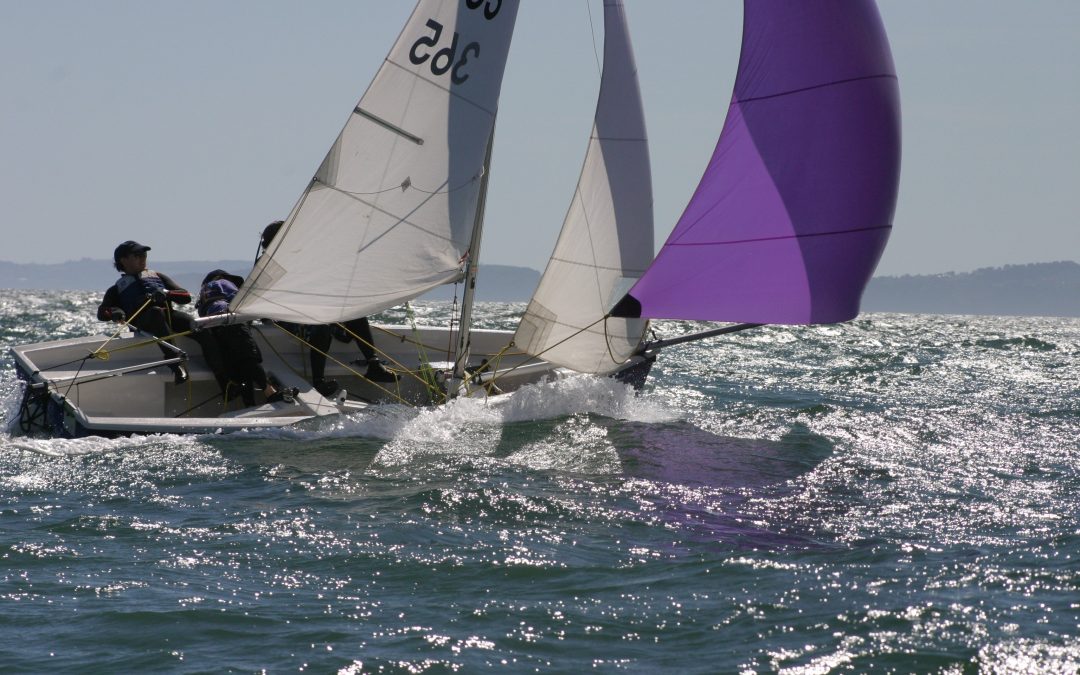
Sailing has been present since historical times, and it has been trendy up until now. The world’s free trade and society have been constructed on the tradition of sailing as it has always had a massive influence in today’s life. If you are interested in sailing, you can read Carson Brannan’s “The Third Option,” which tells how a boat can change people’s lives.
If you’re like most people who are having thoughts of involving themselves in sailing, there may be facts about it that you did not know, so we have compiled a list of fifteen interesting facts on sailing that you must know.
The Word “Trade” Came After the Name “Trade Winds”
When we hear the word “trade,” the first thing that would get in people’s minds are markets, businesses, or commerce. This isn’t the case before because, in the past, trade meant “trail” or “pathway” in the middle English language, making our ancestors come up with the word “trade winds.” Trade winds were described as very reliable wind roads found at the Atlantic.
Sailboats Are Efficient, but They Are Slow
The typical sailboat travels at a speed of 4-6 knots (4-7 mph or 7-11 km/h) with a peak speed of 9 knots (10 mph or 17 km/h). It’s just not possible. That doesn’t suggest that fast boats don’t exist; they can be swift. Multihulls, in particular, have to move a lot less water. They had a top speed of 50 knots (almost 60 mph or 93 km/h). Most sailboats are sluggish because they are small (under 20′), and the hull speed is proportional to the boat’s length. Sailboats with more length are speedier.
Between 8 to 12 Knots Is the Optimal Wind Speed for Sailing
Winds around 8-12 knots are ideal for maneuvering small and mid-sized boats yet attaining decent speeds. Beginners learning to sail should aim for a 5-8 knots wind speed. Anything less than 5 knots is excruciatingly sluggish.
Off-Limits Places for Tourists Can Be Accessed Through Sailing
Several tiny islands are inaccessible to tourists due to the lack of flights or cruises to those locations. Tourists will want to visit these islands because of their rare species, beautiful scenery, original settlements, and other features that make them true hidden jewels. These islands are reachable only by sailing.
Operating a 100-Foot Sailboat Alone Is Allowed
It takes a lot of skill and mental toughness to operate a 100-foot yacht. However, it isn’t impossible. The majority of sailors appear to sail in boats less than 35 feet long. Sailing solo is known as short-handed sailing, and it necessitates the use of short-handed sailing gear.
Typically, this entails a slew of automatic systems and all of the sheets flowing to your cockpit, allowing you to steer while operating the sails. The docking may be the most challenging aspect of sailing alone. Some marinas may even provide you with a dedicated service to assist you with this. If you prefer to sail alone, you should strongly consider using a marina that offers this service.
Sailboats from the Past Are Frequently Misinterpreted
We often think of enormous galleons and first rates when talking about old-school sailboats (such as those from the late Middle Ages). But, shipbuilders could not create huge ships until the Renaissance due to a defect in the hull design.
So the massive floating multi-level buildings with 100 cannons didn’t begin to be built until the Napoleonic era when it was discovered that cross beams could be used to support the hull.
The Word “Feeling Blue” Originated as a Sailing Term
When a ship’s captain is lost while on a journey, the crew will fly blue flags to indicate their loss, so when you say you’re feeling blue, you’re referring to the blue flags that used to indicate a ship’s crew was in sorrow.
The Smallest Boat to Round the Globe Was 21 Feet Long
Alessandro Di Benedetto, widely known as “the Crazy Italian,” holds a unique world record. In the world’s tiniest sailboat, a 21′, he circumnavigated the globe (6.5 m). He took 268 days and 19 hours, which isn’t exactly quick.
However, given the fact that he was dismasted in Cape Horn, it’s a remarkable achievement. To deal with his humiliation, he built a junk rig that got him all the way back to France, where he successfully completed his world-record attempt.
The Youngest Person to Circle the Globe Is 16-Year-Old
Laura Dekker (NED), 16, is the world’s youngest solo circumnavigator, following Jessica Watson (AUS), who completed the feat just before her 17th birthday. Dekker was 16 years and 123 days old at the time. Because they don’t want to encourage 14-year-olds to sail around the world alone, the Guinness Book of World Records does not list the youngest circumnavigation.
Sailing Has Been a Part of the Olympic Games Since 1896
Except for the 1904 Summer Olympics, which were held in Louisiana, sailing has been a component of every contemporary Olympic games. This makes it one of the most long-running Olympic sports. For over 120 years, the International Olympic Committee has considered sailing as a sport. For the most part, it was a gender-mixed sport until 1988, making it one of the few sports where men and women compete openly.
It Is More Difficult to Sail Around the World Westward Than Eastward.
Due to the stronger and more predictable winds and currents eastward on the southern hemisphere, most world-record candidates chose to sail eastward. Only five world records have been established using the westward route, and no one has set a record by turning right since 2010. In comparison, the eastward route has set more than 20 world records.
Sailboats Have the Ability to Sail Faster Than the Wind
Most boats cannot travel faster than the wind. However, some racing yachts and the majority of multihulls can. There are two reasons for this. It’s feasible because boats generate their own wind, which allows them to surf their own wave,’ increasing their speed. Second, keelboats have a displacement hull, which means they have to push the water ahead, which means they must deal with resistance, which increases as the speed increases.
A Female Chinese Prostitute Was the Most Powerful Pirate
Ching Shih (roughly “widow of Zheng”) was the most powerful pirate who ever lived. She was in charge of around 300 junks. Between 20,000 and 40,000 men, women, and children served on the ships.
The British Empire, the Portuguese, and the Qing dynasty were among the key naval powers she faced. Without question, she is the most successful pirate of all time. Unlike many others, she died as a free lady in her own house rather than being executed.
The Dutch War Efforts Against the British Inspired the Sailing Flags
The British intended to displace the Dutch as the dominating naval force during the Anglo-Dutch wars (1652-1674). To outmaneuver the British, Dutch admiral De Ruyter and Grand Pensionary DeWitt devised a flag signaling system. It went off without a hitch.
The Term “Son of a Gun” Actually Refers to Your Location of Birth
Women had to be smuggled on board in the past. Again, since the journey dragged on longer than intended, they had to give birth every now and then. Women gave birth between the cannons on the gun deck when they were at sea. If no one among the passengers or sailors claimed the child, it was recorded in the ship’s log as the “son of a gun.”
As you can see, sailing is genuinely a fantastic sport, and sailboats are a wonderful invention. We hope we have given you sufficient knowledge on the exciting facts about sailing. If you want more information or you want to have the inspiration to involve yourself in sailing, get a copy and read Carson Brannan’s “The Third Option.”
Featured Image: https://www.pexels.com/photo/person-in-blue-and-white-sailboat-on-body-of-water-during-daytime-76978/
Submit a Comment Cancel reply
Your email address will not be published. Required fields are marked *
Save my name, email, and website in this browser for the next time I comment.
Recent Posts
- Knowing The Purpose of Your Gifts and Talents
- The Power of Having a Never Quitting Mindset
- How Can You Help Others to Know God?
- A Soldier Who Became a Preacher
Recent Comments
- Spiritual Transformation
Pin It on Pinterest
- StumbleUpon

15 Surprising Facts About Modern Sailboat Design

February 28, 2024
Key Takeaways
- Modern sailboat design dramatically enhances performance and experience.
- Understanding these design changes adds depth to our appreciation of sailing.
- Innovations in design are influenced by changes in racing regulations.
Discover the surprising facts about modern boat design as we explore the leaps and bounds that modern sailboat design has made.
The surprising facts about modern boat design are the use of advanced materials, computer-aided designs, hydrodynamic hulls, wind tunnel testing, and articulated rudders. The modern boat design also incorporates wing sails, and twin rudders, among other innovative designs.
As a sailing enthusiast, I possess a deep understanding of the intricacies that shape the modern sailing world. My knowledge encompasses the latest advancements in hull design, rigging techniques, materials, and sustainability practices. As such, I’ll reveal surprising facts that shed light on the innovation and engineering excellence driving the evolution of sailboat design in the 21st century.
Table of contents
Surprising Facts About Modern Sailboat Design
Have you ever looked at a modern sailboat and wondered about the innovative marvels that distinguish these vessels from their ancestors? The world of sailing has transformed dramatically, thanks to cutting-edge technology and revolutionary design elements.
Let's dive into the surprising facts that make today's sailboats a tidal wave of innovation.
From materials that sound straight out of a sci-fi novel to rudders that think for themselves, these facts will give you a new perspective on sailboats.
1. Advanced Materials
Modern sailboat design has been revolutionized by the use of advanced materials like carbon fiber and Kevlar, which offer unparalleled strength-to-weight ratios.
These materials are not limited to the hull; they have also transformed masts and rigging, resulting in lighter, faster, and more durable vessels.
Sailboats can now harness the power of these cutting-edge materials to achieve remarkable performance while maintaining structural integrity.
2. Computer-Aided Design (CAD)
The introduction of Computer-Aided Design (CAD) technology has elevated sailboat design to new heights.
Engineers and designers can now meticulously craft and simulate sailboat designs before the first physical piece is ever built.
This precision-driven approach allows for the creation of sailboats tailored for optimum performance, ensuring that every element, from hull shape to sail configuration, is optimized to perfection.
3. Hydrodynamic Hulls
Modern sailboat hulls are meticulously designed with hydrodynamics in mind. These sleek, streamlined shapes minimize drag and maximize speed, marking a significant departure from the bulky hulls of the past.
Sailboats are now engineered to slice through the water with minimal resistance, enhancing their overall performance.
4. Wind Tunnel Testing
Wind tunnel testing, a practice well-known in many industries has also made its way into sailboat design.
Sailboats undergo rigorous wind tunnel testing to perfect sail shapes and rig setups, optimizing aerodynamic efficiency.
This meticulous approach ensures that every knot of speed is squeezed out, making sailboats faster and more competitive.
5. Hydrofoils
Hydrofoils are like the magic carpets of the sea, revolutionizing sailboat speed and performance.
As speed increases, these underwater wings lift the hull above the water's surface, drastically reducing drag. They also enable breakneck speeds that were once considered unattainable for sailboats.
6. Articulated Rudders
Articulated rudders represent a significant advancement in sailboat design , offering sailors a remarkable degree of maneuverability and precise control, particularly at high speeds.
Comparable to a race car driver fine-tuning their steering, skippers can now navigate sailboats with exceptional precision. These rudders respond swiftly to helm adjustments, enhancing safety and optimizing performance in various conditions.
Whether executing tight maneuvers or maintaining a steady course, articulated rudders empower sailors with unparalleled control, making them a game-changer in modern sailboat design.
7. Wing Sails
The adoption of wing sails in sailboat design marks a departure from traditional canvas sails and ushers in a new era of sailboat efficiency and adaptability.
Resembling the wings of an airplane, these sails offer sailboats increased power, precise control, and exceptional adjustability.
Sailors can harness the wind more efficiently, optimizing their sail configurations to suit changing conditions.
Wing sails respond rapidly to shifts in the wind, providing a level of adaptability that was once unimaginable. This innovation has transformed sailboats into highly responsive and versatile vessels, ensuring optimal performance on the open seas.
8. Sustainability Features
Sustainability is at the forefront of modern sailboat design, reflecting the growing commitment to eco-friendly practices within the sailing community.
Sailboats are now equipped with innovative features such as electric propulsion systems, solar panels, and advanced water purification systems.
These sustainable technologies reduce environmental impact, allowing sailors to cruise the open seas while minimizing their carbon footprint.
As sustainability takes precedence, the integration of these eco-friendly features not only aligns with environmental values but also enhances the overall cruising experience, making it more responsible and enjoyable.
9. Self-Tacking Jibs
The introduction of self-tacking jibs has streamlined sailboat maneuvering , particularly for solo sailors or small crews. These ingenious sails automatically adjust to the wind's direction, eliminating the need for manually grinding winches when changing course.
This innovation significantly enhances convenience and usability, making sailing more accessible to a broader range of enthusiasts.
Whether navigating through gusty winds or executing precise tacks, self-tacking jibs simplify the sailing experience, allowing sailors to focus on enjoying the journey without the hassle of constant sail adjustments.
10. Canting Keels
Canting keels represent a pivotal development in sailboat design, offering a solution to the age-old challenge of sailboat stability when heeled over. These keels can be shifted from side to side, counteracting the natural inclination of sailboats to capsize when tilted.
This innovation allows for a more aggressive sail plan, enabling sailboats to achieve higher speeds without compromising safety.
The canting keels' ability to maintain stability while heeled over has revolutionized sailboat racing and performance, pushing the boundaries of what sailboats can achieve on the water.
11. Twin Rudders
Two rudders mean better control, especially when heeling, and improved performance by maintaining steerage even in challenging conditions.
It's like having four-wheel steering in your car—a game-changer for sure.
12. Integrated Navigation Systems
Touchscreen displays, GPS, and autopilot systems are no longer just for luxury cars. They've found their way onto sailboats, providing sailors with all the navigational aids they need at their fingertips.
13. Resin-Infused Hulls
Resin-infused hulls represent a pivotal advancement in sailboat construction, delivering stronger, lighter, and more resilient vessels with a superior finish.
This innovative manufacturing process involves infusing resin into a precisely arranged fiber matrix, resulting in a structurally sound hull that is both lightweight and exceptionally durable.
The benefits are twofold: a faster sailboat due to reduced weight and increased resilience to the elements.
14. Sail-Material Innovations
Modern sailboats continue to push the boundaries of speed and performance, thanks in large part to sail-material innovations.
Sails are now crafted from laminated fabrics and exotic fibers that are not only capable of withstanding the punishment of the high seas but also offer enhanced performance.
These advanced materials provide superior durability and strength, allowing sails to maintain their shape and efficiency even in challenging conditions.
Sailors can confidently navigate rough waters, harnessing the full potential of the wind to achieve remarkable speeds.
These sail-material innovations are at the heart of modern sailboat design, enabling sailors to explore new horizons and set sail like never before.
15. Foil-Assisted Monohulls
Foil-assisted monohulls represent an exhilarating advancement in sailboat design, harnessing the power of underwater wings to provide additional lift.
This innovative feature effectively reduces drag and allows the sailboat to ride higher and quicker in the water.
The result is a thrilling sailing experience that combines speed, stability, and agility. Foil-assisted monohulls are a game-changer for sailors who seek the thrill of high-speed sailing while maintaining control and stability.
This technology has redefined what is possible in monohull sailboats, offering an exhilarating ride for sailors who crave speed and adventure on the open seas.
Impact of Racing Regulations and Rating Systems on Sailboat Design
The world of sailboats is more intricate than it seems, especially when you throw in racing regulations and rating systems.
Regulations and rating systems aren’t just red tape; they are the invisible architects of modern sailboat design. From tweaking hull shapes to adjusting ballasts, these rules stir the pot, leading to innovation in search of that extra knot of speed.
Here’s a simple breakdown highlighting how racing regulations and rating systems have dramatically influenced sailboat design:
Frequently Asked Questions
Here are the FAQs on modern sailboat designs.
Can you list some notable evolutions in sailboat design since their invention?
Absolutely! Over time, sailboats have shed some serious weight and bulk. Think less 'pirate galleons', and more 'sleek sea greyhounds'. The nifty evolution includes trimmed-down overhangs at the bow and stern, giving modern sailboats a longer waterline for a given length overall.
What are a few unexpected benefits of modern sailboat design on the efficiency and speed of sailing?
For starters, contemporary sailboats are shaping up to be the marathon runners of the sea – sleeker, lighter, and roomier. All that extra width isn't just for cocktail parties on deck; it's for stability.
How do modern sailboats incorporate sustainability and eco-friendliness into their designs?
Designers are harnessing materials and technologies that lower the environmental impact like inventive hull coatings to reduce drag and engines that sip rather than gulp fuel.
Jacob Collier
Born into a family of sailing enthusiasts, words like “ballast” and “jibing” were often a part of dinner conversations. These days Jacob sails a Hallberg-Rassy 44, having covered almost 6000 NM. While he’s made several voyages, his favorite one is the trip from California to Hawaii as it was his first fully independent voyage.
by this author
Trending Now

What Does "Sailing By The Lee" Mean?

Best Sailing Duffle Bags: Top Picks For Boat Travel

The Best Sailing Schools And Programs: Reviews & Ratings

Affordable Sailboats You Can Build at Home

Best Small Sailboat Ornaments

Best Small Sailboats With Standing Headroom

Discover the Magic of Hydrofoil Sailboats

Best Bluewater Sailboats Under $50K

Hunter Sailboats: Are They Built for Bluewater Cruising?

How To Buy A Cheap Sailboat

What Is A Furler On A Sailboat?

How To Choose The Right Sailing Instructor

What Is Sail Roach?

Best Blue Water Sailboats Under 40 Feet

What Is A DaySailer Sailboat?

Are Catalina Sailboats Bluewater Boats?

Best Sailing Racing Electronics

How To Sail From California To Tahiti

Best Sailing Destinations In BC

Best Sailing Charter Destinations

Which Sailboats Have Lead Keels?

Best 2 Person Sailboats

What Sailboats Are Made In The USA?

Best Sailing Racing Compasses

Which Sailboats Hold Their Value?

Can You Sail In Maine In October?

Most Reliable Sailboats

Common Issues With Amel Yacht Sailboats

Basics Of Sailboat Racing Explained

What Is The Steering Wheel On A Ship Called?

Everything You Can Pull Behind A Boat

How To Tow A Skier Behind A Boat

Most Popular One-Design Sailboats

How Long Is A Laser Sailboat?

What Sailboats Are Used In The Olympics?

Why Do Sailboats Lean?

Cost To Dock A Sailboat

Cost To Sail Around The World

How Often Do Sailboats Capsize & Sink?

Are Sailboats Bad For The Environment?

Best Marine Epoxy

Best Sailing Destinations Chesapeake Bay

Best Pontoon Boat Brands

Best Marine Refrigerators

Best LED Navigation Lights

Best Marine Air Conditioners

Best Boating Watches For The Avid Sailor

Are Sailboats Cheaper Than Powerboats?

How Much Does A Laser Sailboat Cost?

How Often Do Sailboats Get Struck By Lightning?

How Do Sailboats Float?

Best Marine Water Softeners

Best Sailing Shirts

Best First Aid Kits For Boat Safety

Why Do Catamarans Have Trampolines?

Best Ropes For Mooring Lines

Who Has To Wear A Life Jacket On A Boat?

How Old Do You Have To Be To Wear A Life Jacket On A Boat?

Where To Store Life Jackets On A Boat

Best Winter Pontoon Boat Covers

Bennington Pontoon Winter Cover Review

Best Pontoon Boat Cover Support Systems

How To Paint Pontoon Boat Fencing

What To Bring On Pontoon Boat

What To Wear On A Pontoon Boat

Pontoon Boat Winter Storage Ideas

Best Pontoon Boat Accessories

How Tall Is A Pontoon Boat On A Trailer?

Where To Attach Tow Ropes To Pontoon Boats

Best Trolling Motors For Pontoon Boats

Best Pontoon Boats For The Money

Best Pontoon Winter Storage Blocks

How To Launch A Pontoon Boat By Yourself

Best Pontoon Boats

How Much To Rent A Pontoon Boat? (Cost)

What To Avoid When Buying A Pontoon Boat

Best Grills For Pontoon Boats

How To Store A Pontoon Boat For Winter

SwellPro SplashDrone 4 Review (Is It Worth It?)

Best Anchors For Pontoon Boats

What Size Trolling Motor For 24ft Pontoon Boats?

How Many People Can Fit On A Pontoon Boat?

Best Small Pontoon Boats

How To Start A Pontoon Boat

How Fast Can Pontoon Boats Go?

What Size Motor For A 20ft Pontoon Boat?

Where To Put Numbers On A Pontoon Boat

How To Launch A Pontoon Boat

How Much Do Pontoon Boats Cost?

Best Fishing Pontoon Boats

How Wide Is A Pontoon Boat Trailer?

How To Store A Pontoon Boat Without A Trailer

Best Pontoon Boat Covers

Top 5 Pontoon Boats (Best Brands & Options)

How To Add Flags To Pontoon Boats

Who Makes Crest Pontoon Boats?

What Is Underpinning On A Pontoon Boat?

How To Drive A Pontoon Boat

How To Anchor A Pontoon Boat

How Wide Is A Pontoon Boat?
Get The Best Sailing Content
Top Rated Posts
Lifeofsailing.com is a participant in the Amazon Services LLC Associates Program, an affiliate advertising program designed to provide a means for sites to earn advertising fees by advertising and linking to Amazon. This site also participates in other affiliate programs and is compensated for referring traffic and business to these companies. (866) 342-SAIL
© 2024 Life of Sailing Email: [email protected] Address: 11816 Inwood Rd #3024 Dallas, TX 75244 Disclaimer Privacy Policy

8 most interesting facts about sailing and boats
- October 19, 2020
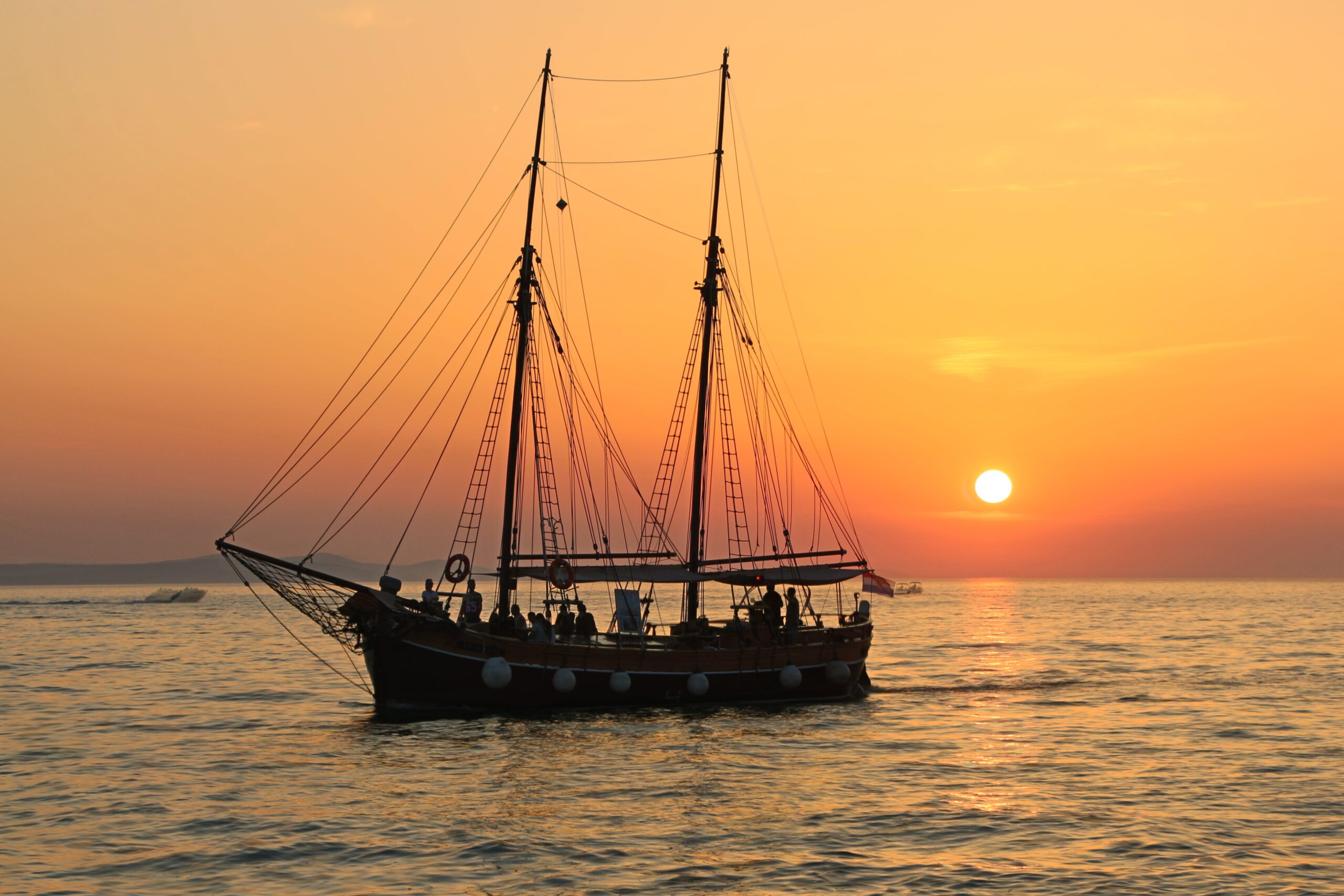
Ahoy there! As boaters, skippers and sailing enthusiast, some of the members of our team started looking up interesting and fun facts about sailing, during one of our trips.
Having some time to kill during one of our trips on the glistening Turkish Blue Coast , we starting telling stories heard from fellow boaters.
In truth, the discussion started over reviewing the key statistics about the recreational boating industry , which we were curious about since we were about to launch our free smart boating app , designed for making us safer together, to provide easier planning and smartly track our performance.
Tired of numbers, we started sharing knowledge and stories we have heard, right before making port.
So, after that, we thought “Hey, why not share our fun moments as a community with our future community members and with the users of our great new app .”
Having decided that, and after a little research, we came up with this:
1. Difference between a boat and a ship
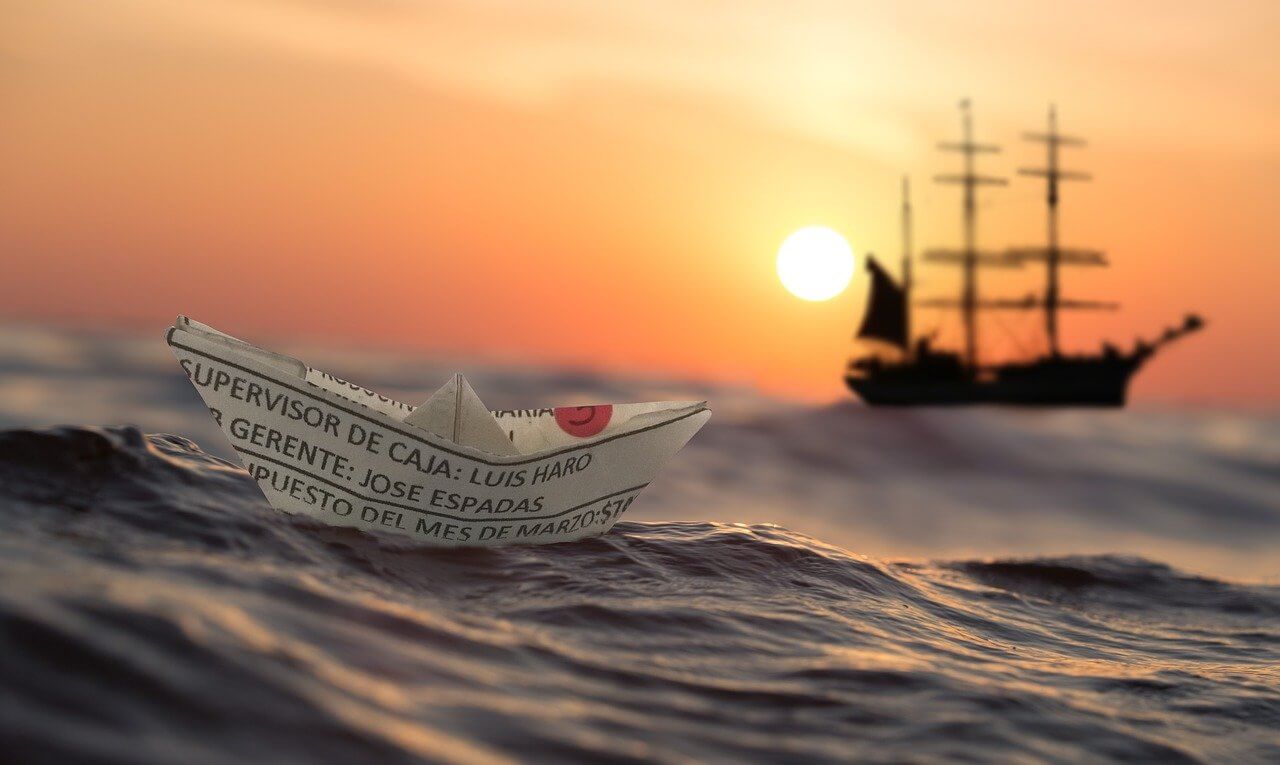
Did you know the most important difference between a Boat and a Ship is actually the weight? It turns out that if a vessel weighs 500 tones or more it’s classified as a ship since this is the weight you need in order to carry a boat. To always know the difference, remember “A ship can carry a boat, but a boat cannot carry a ship.”
From all the specifications that separate the two, we can count areas of operations (ships operated in oceanic areas and high seas; boats operate in smaller or/and restricted water areas), method of propulsion (boats use sails, motor, or human power and ships have dedicated engines for propulsion), technology, crew, cargo capacity, construction and design.
2. To whistle or not to whistle… on a boat
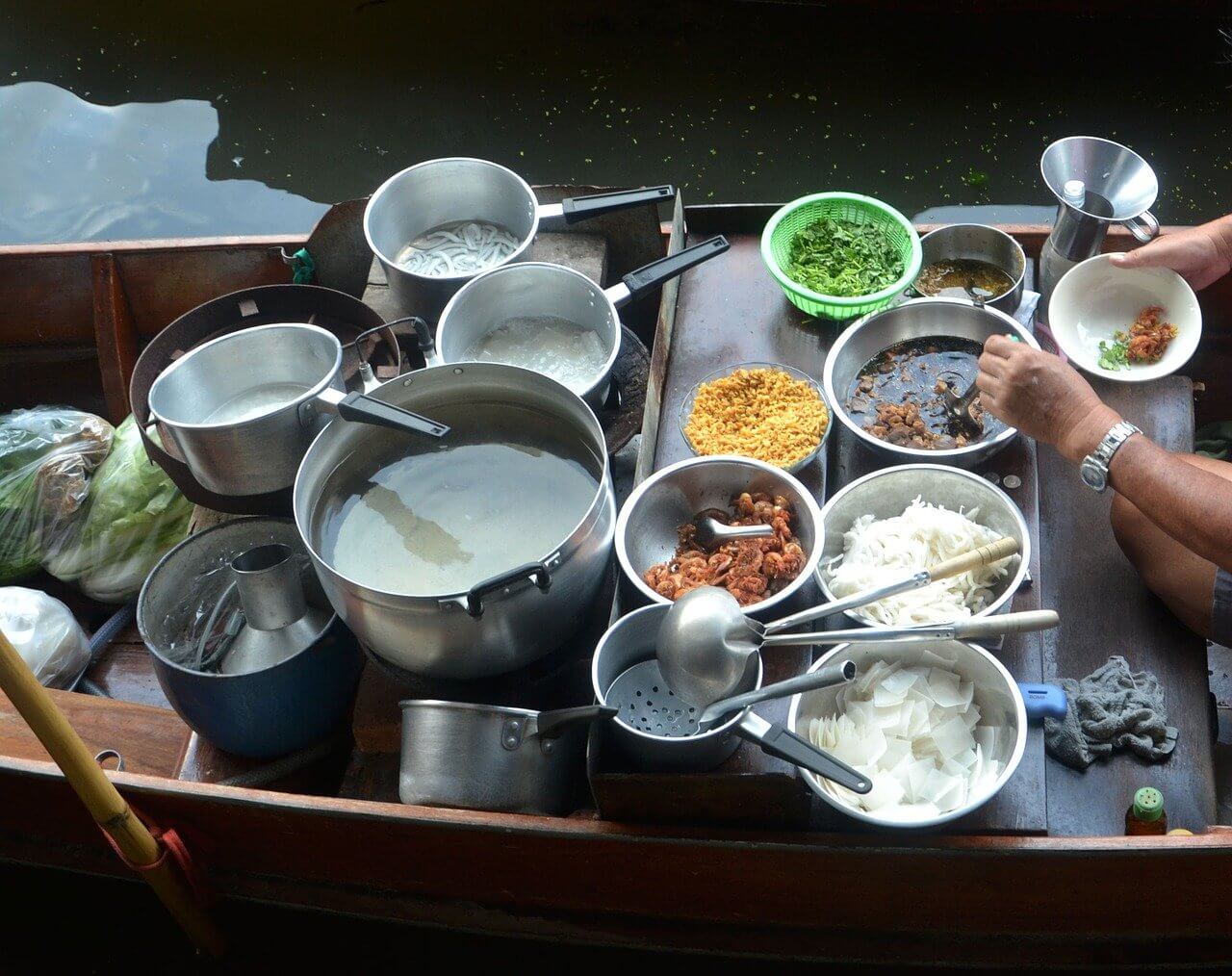
Did you know that cooks on board ships in the old days were the only ones allowed to whistle? Strange, right? But apparently this proved they were not using their mouths to eat the food as long as they whistled. Other crew members would not whistle since superstitiously they would think whistling would summon strong winds.
In contrast with this, having a woman giving birth to a male child on board was a sign of good luck. The children born on the ship used to be called “son of a gun”.
3. Sometimes size does not really matter
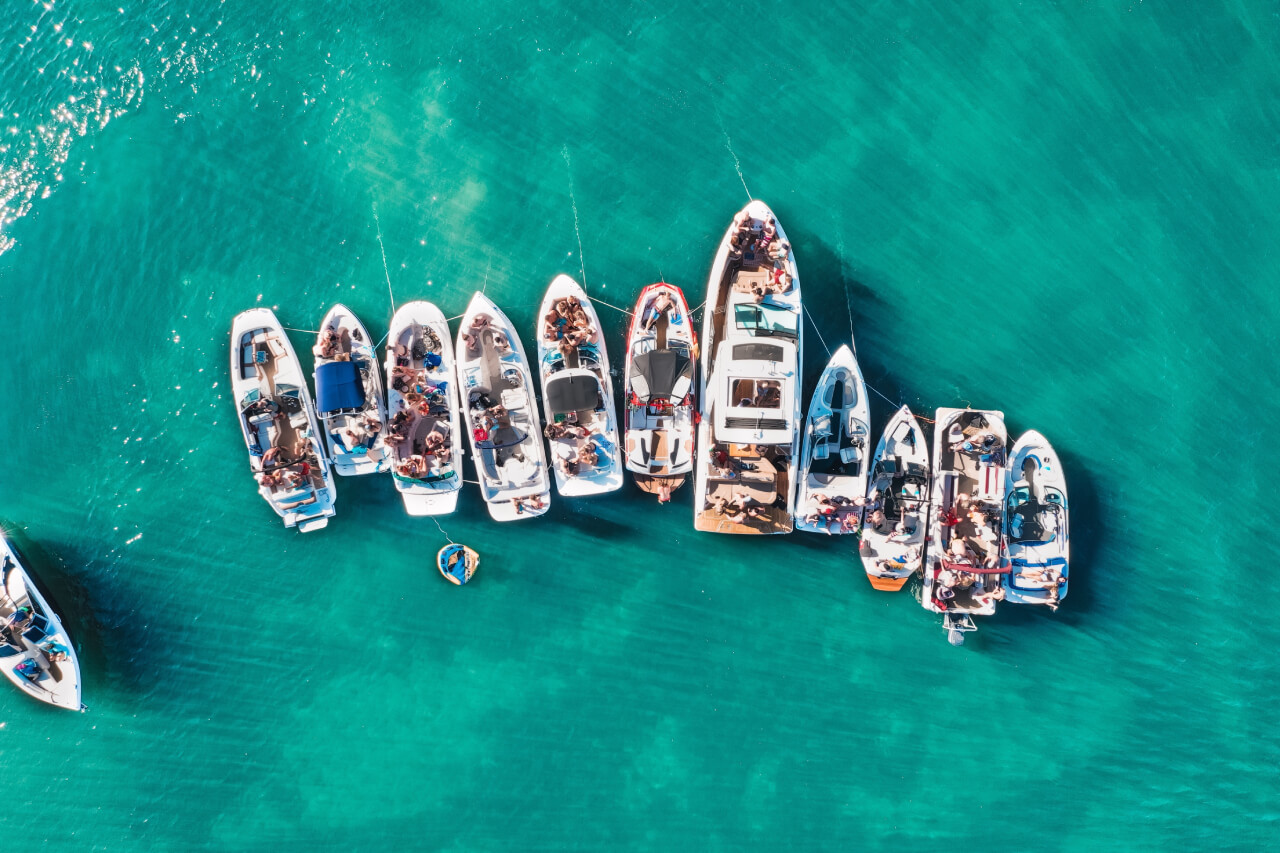
Image source
Did you know that the ship Christopher Columbus used to reach America was actually small? Well, it was small compared to today’s standards. The Santa Maria was no longer than 70 feet, about the size of a modern bus and weighing around 200-600 tons. It carried a crew of 52 members.
The original name of Santa Maria was La Gallega in reference to the place where the ship was built. Christopher Columbus changed the name of the ship to Santa Maria de la Immaculate Concepción.
4. Distance make the heart grow fonder

Did you know that statistics say that boaters and anglers are more satisfied with their marriages and friendships compared with people who don’t participate in these activities?
Also they are more likely to recycle, compost trash, use compact fluorescent lightbulbs, carpool, donate money to environmental organizations, actively trying to reduce their carbon footprint and are more likely to have close relationships with their children. This comes out of a study published some years ago by the Recreational Boating and Fishing Foundation.
5. Treasure on sea
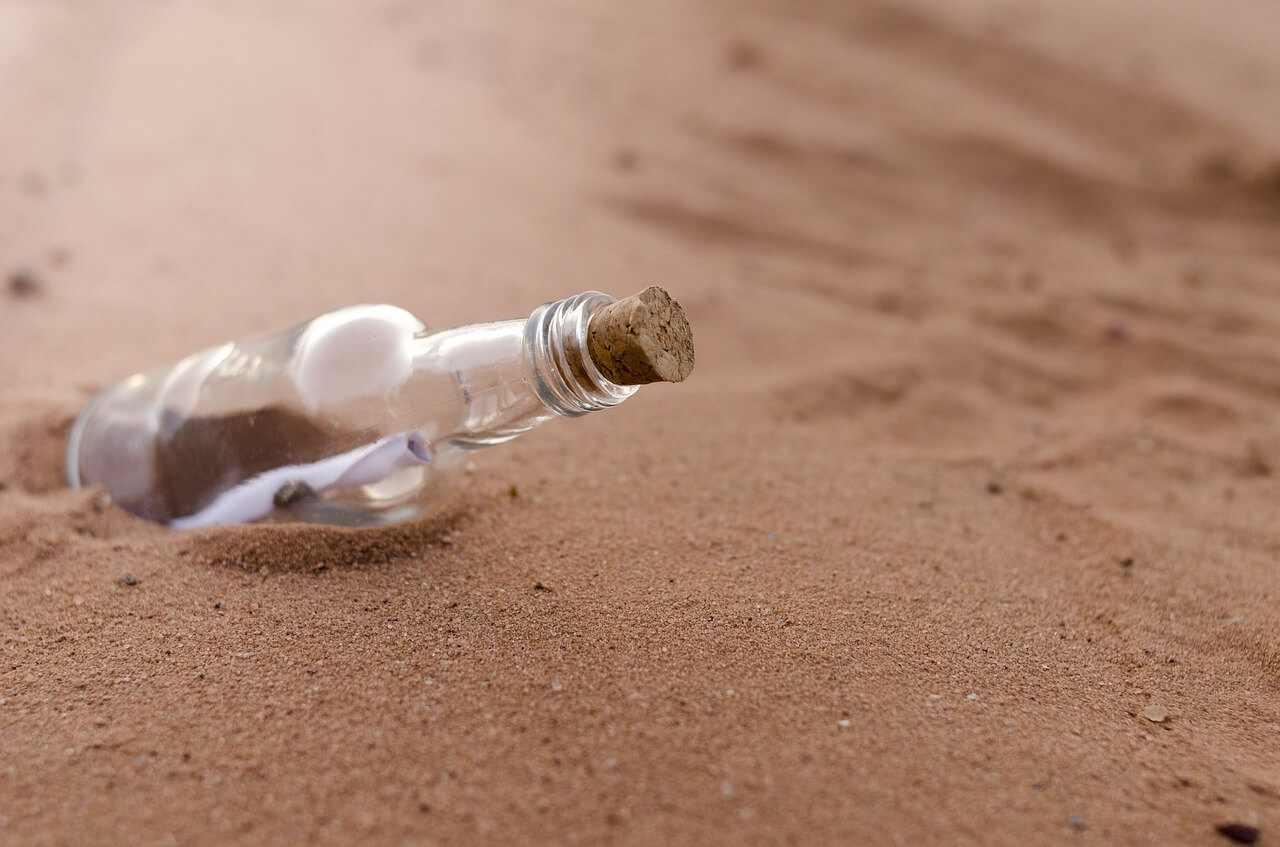
Did you know that Tommy Thompson was a treasure hunter that located a ship that sank in 1857 called the SS Central America and recovered over $1 billion worth of gold from the several tons the ship carried? However, the strange thing is that he never paid back his crew or investors, and hasn’t been seen in years.
They are literally hundreds if not thousands of treasures all around the ocean floor. It is estimated to be over 20 million tons of gold. Do you feel lucky?
“The ocean is the world’s greatest museum,” says marine archaeologist Peter Campbell.
6. Look the other way
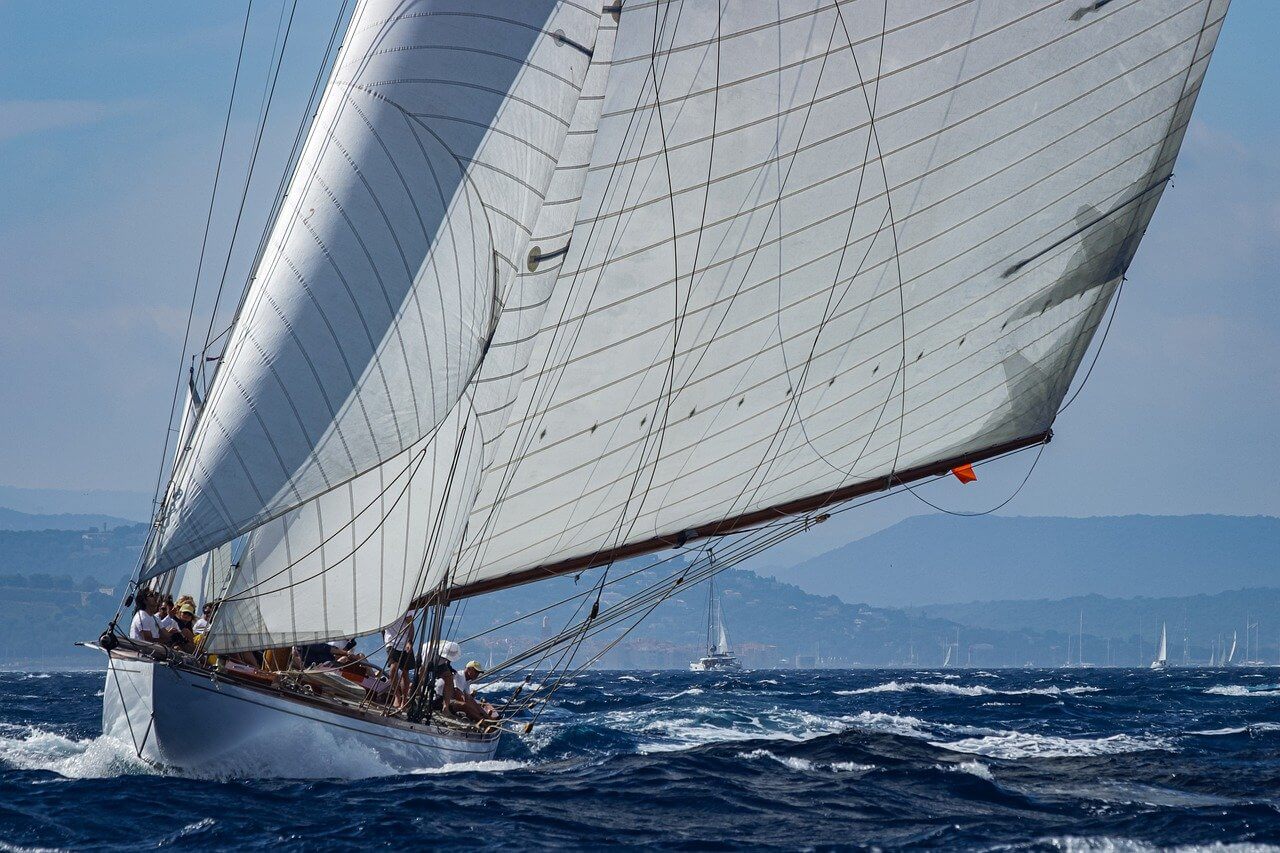
Did you know that in 2004 a party yacht tripped over on Lake Travis when the passengers all moved to one side of the boat as it passed a nude sunbathers beach in Texas?
7. 3 days under water. How is that even possible?
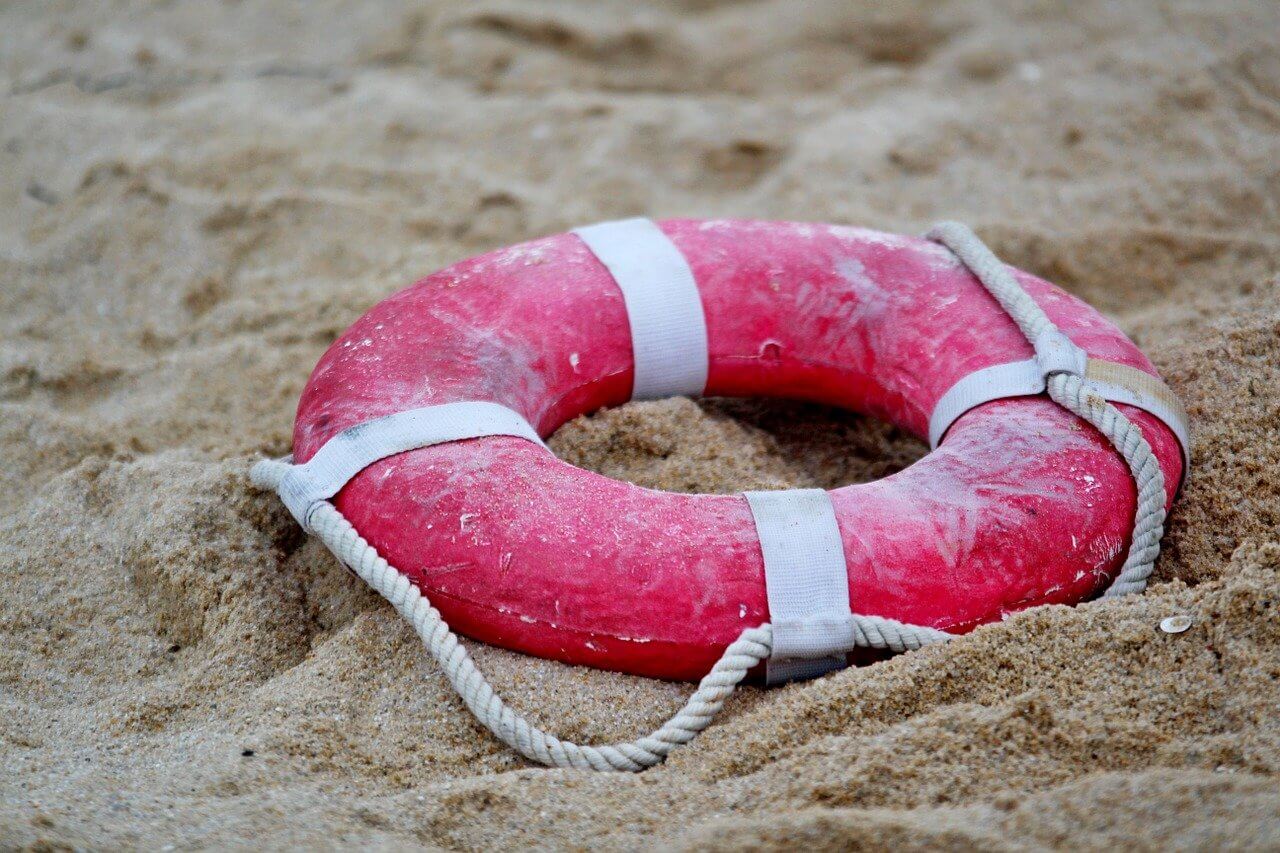
Did you know that there was a man that survived under the sea for three days? You wonder how that was possible?
Well, it seems that in 2013, the chef of a sunken ship survived for 3 days under the ocean after taking refuge in an air pocket of the ship, that by this time had come to rest upside down on the seafloor at a depth of about 100 feet (30 meters).
8. “Quarantine” and its origins
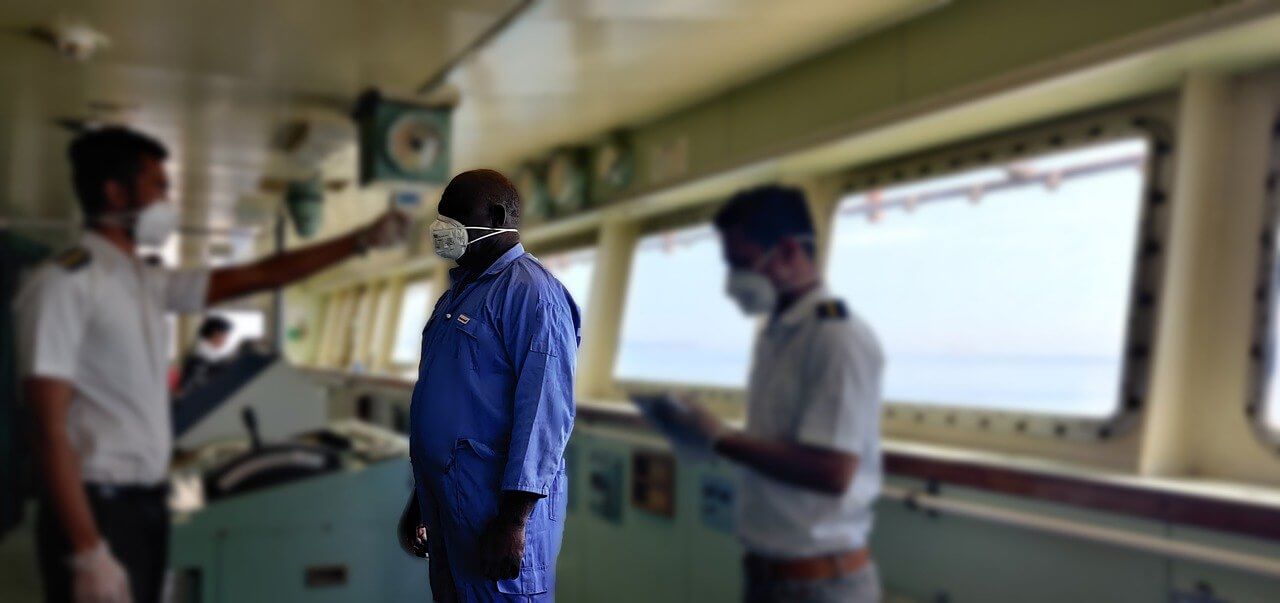
Top Known Primary Boating Accidents. Statistics, Contributing Factors and Solutions
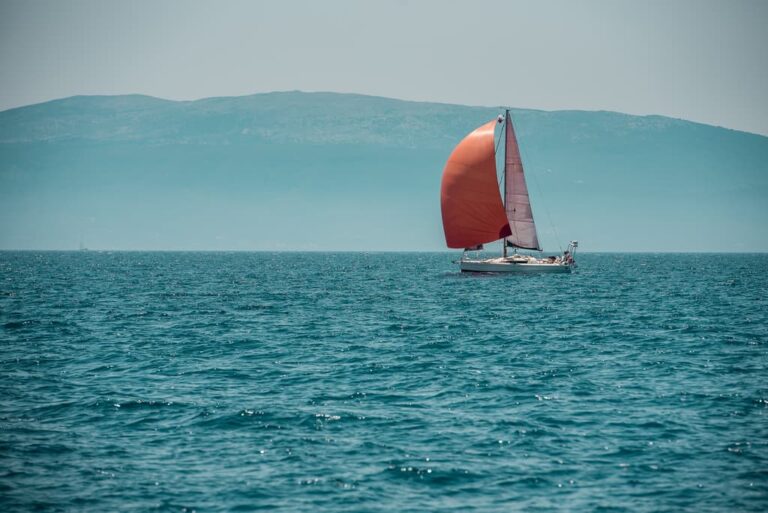
Some facts and numbers
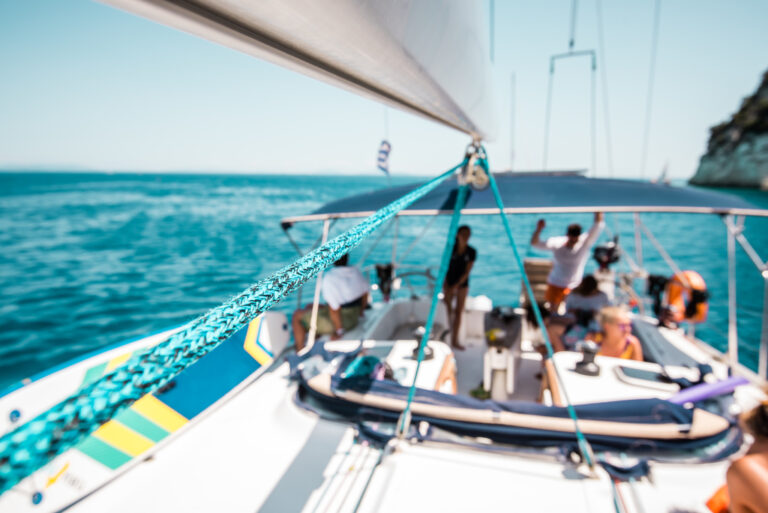
5 things you should know about … crew briefings

Look no further! At our company, we value our customers and their feedback. We want to give you a voice in the development of our product.
By providing feedback on our platform, you’ll receive 50% off for life should you choose to continue using it.
© 2022 IQNautics, BV. All right reserved.

Turn Your Curiosity Into Discovery
Latest facts.

3 TopRated Sites To Boost Your TikTok and Instagram Following

5 Detailed Facts About Medical Cannabis
13 facts about sailing.
Written by Olive Glidden
Modified & Updated: 02 Mar 2024
Reviewed by Sherman Smith
- Boating Facts
- Navigation Facts
- Sailing Facts
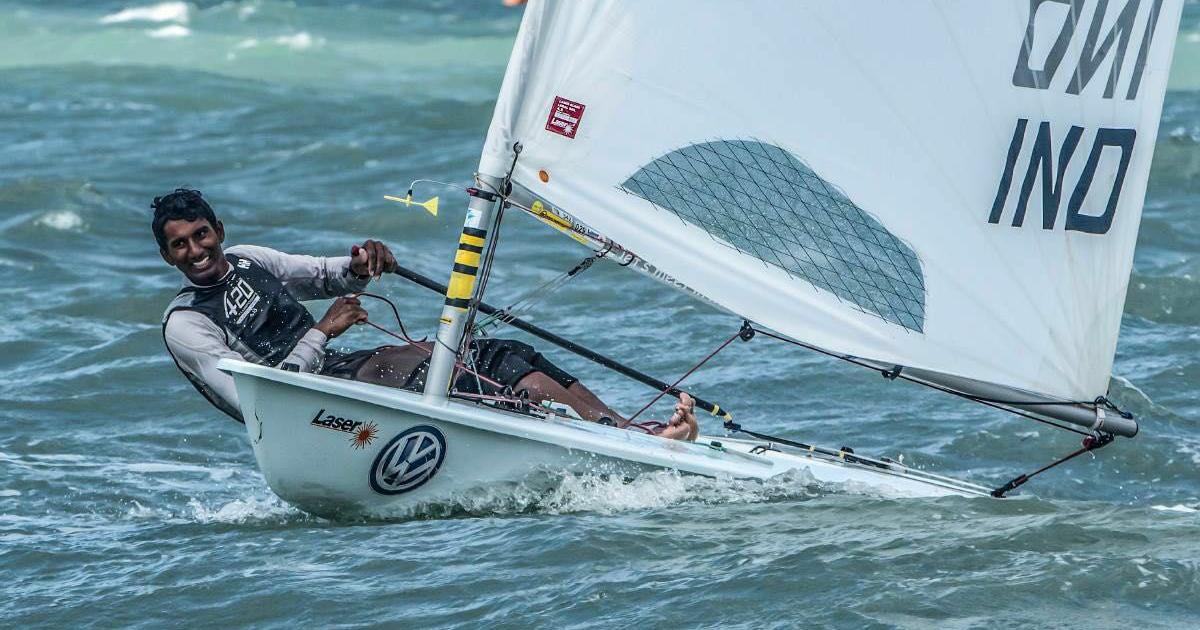
Sailing is a fascinating sport that has captivated the hearts of adventurers and nature lovers for centuries. Whether you are a seasoned sailor or someone who simply admires the majestic beauty of a sailboat gliding across the water, there is no denying the allure of this timeless activity. From navigating the open sea to feeling the wind in your hair, sailing offers a unique experience that is both exhilarating and tranquil. In this article, we will take a deep dive into the world of sailing and explore 13 fascinating facts that will leave you in awe of this incredible sport. So, sit back, relax, and get ready to embark on a journey to discover the secrets of the sea !
Key Takeaways:
- Sailing is an ancient method of transportation that offers adventure, freedom, and a connection to nature. It promotes teamwork, environmental consciousness, and the discovery of hidden gems around the world.
- From learning nautical terms to reaching incredible speeds, sailing is a sport that can be enjoyed by people of all ages. It fosters a sense of exploration, relaxation, and a deep appreciation for the environment.
Sailing is one of the oldest methods of transportation.
For thousands of years, humans have been harnessing the power of the wind to navigate across bodies of water. Sailing dates back to ancient Mesopotamia and has played a crucial role in the exploration and development of civilizations throughout history.
There are different types of sailing vessels.
From sailboats and catamarans to yachts and schooners, there are various types of sailing vessels designed for different purposes. Each one offers a unique sailing experience and challenges.
The fastest sailing boats can reach incredible speeds.
Modern racing sailboats, such as the hydrofoil boats used in the America’s Cup, can reach speeds of up to 50 knots (92.6 kilometers per hour). These high-performance boats are built for optimal speed and maneuverability.
Sailing requires knowledge of navigation and meteorology.
Successful sailing involves understanding navigation techniques, reading nautical charts, and keeping a close eye on weather conditions. Sailing enthusiasts must have a solid grasp of meteorology to ensure a safe and enjoyable voyage.
Sailing is a popular recreational activity.
Many people around the world enjoy sailing as a leisure activity. Whether it’s cruising on calm waters or participating in regattas, sailing offers a unique way to relax, explore, and connect with nature.
Sailors communicate using specific nautical terms.
To effectively communicate while at sea, sailors use a specific set of nautical terms. From port and starboard to bow and stern, understanding these terms is crucial for clear and concise communication on a sailing vessel.

Sailing can be a competitive sport.
Sailing competitions, such as the Olympic Games and the Volvo Ocean Race , attract skilled sailors from around the world. These events showcase the athleticism and teamwork required to excel in the sport of sailing.
There are different types of sailing knots.
Sailors rely on a variety of knots for different purposes, such as securing lines and adjusting sails. Common sailing knots include the bowline, clove hitch, and figure-eight knot.
Sailing fosters a sense of adventure and freedom.
The feeling of gliding through the water, propelled by the wind, creates a sense of freedom and adventure that is difficult to match. Sailing allows individuals to disconnect from the pressures of everyday life and embrace the serenity of the open sea.
The skill of sailing can be learned at any age.
Whether you’re a child or an adult, it’s never too late to learn how to sail. Many sailing schools offer lessons and certifications to help beginners acquire the necessary skills and knowledge.
Sailing can lead you to discover hidden gems.
Exploring the world by sailboat allows you to visit remote islands, secluded coves, and undiscovered coastal towns. Sailing offers a unique opportunity to discover hidden gems and experience places that are often inaccessible by other means of transportation.
Sailing requires teamwork and communication.
On a sailing vessel, teamwork and communication are paramount. Each crew member plays a vital role in ensuring the safe and efficient operation of the boat , from hoisting sails to navigating through challenging waters.
Sailing promotes environmental consciousness.
Many sailors have a deep appreciation for the environment and actively work towards preserving it. Sailing promotes sustainability, as it relies on the wind for propulsion, minimizing the use of fossil fuels and reducing the carbon footprint.
So, the next time you set sail, remember these 13 fascinating facts about sailing. Whether you’re navigating the open ocean or enjoying a peaceful sunset cruise, sailing offers a world of excitement, adventure, and discovery.
Sailing is a fascinating sport that offers a unique experience filled with adventure, skill, and a deep connection to nature. Whether you’re a seasoned sailor or just starting out, there is always something new to learn and discover. From the history of sailing to the various types of boats and techniques, the world of sailing is vast and diverse. So, get out on the water, feel the wind in your sails, and embrace the exhilaration of sailing!
1. What is sailing?
Sailing is the art of using wind to propel a vessel across the water. It involves controlling the sails and adjusting the boat’s direction to harness the power of the wind.
2. What types of boats are used in sailing?
There are various types of boats used in sailing, including dinghies, keelboats, catamarans, and yachts. Each type has its unique characteristics and purposes.
3. Do I need prior experience to go sailing?
No, you don’t need prior experience to go sailing. There are courses and lessons available for beginners that can teach you the basics of sailing and help you get started.
4. Is sailing a safe sport?
With proper training, equipment, and knowledge of safety procedures, sailing is considered a safe sport. However, it is essential to be aware of weather conditions and take necessary precautions while on the water.
5. Can I sail alone?
Yes, sailing alone is possible, but it requires more experience and expertise. It is recommended to sail with a crew, especially for beginners, for added safety and support.
6. What are some popular sailing destinations?
Popular sailing destinations include the Mediterranean Sea, Caribbean Islands, French Riviera, and the Whitsunday Islands in Australia. These places offer beautiful coastal views and excellent sailing conditions.
7. Are there any competitions in sailing?
Yes, sailing competitions take place worldwide, ranging from local regattas to prestigious events like the America’s Cup and the Olympic Games. These competitions showcase the skills and talents of sailors from around the globe.
8. How can I get involved in sailing?
To get involved in sailing, you can join a sailing club, take lessons, or participate in sailing events in your area. It’s a great way to meet fellow sailing enthusiasts and expand your knowledge and skills.
Was this page helpful?
Our commitment to delivering trustworthy and engaging content is at the heart of what we do. Each fact on our site is contributed by real users like you, bringing a wealth of diverse insights and information. To ensure the highest standards of accuracy and reliability, our dedicated editors meticulously review each submission. This process guarantees that the facts we share are not only fascinating but also credible. Trust in our commitment to quality and authenticity as you explore and learn with us.
Share this Fact:
Your source for the latest news on yachts, boats and more. Read through our articles to find out how to compare boats and find the right fit for you!
10 interesting fun facts about boats that you did not know
Aug 05, 2020
less than a min

Boats are very interesting vessels. Here are some fun facts about boats that you might not have heard about.
- Good luck and back luck omens are different on a boat than on dry land. For instance, whistling on a boat is expected to bring upon strong winds and is therefore considered bad luck. Bananas on a boat are also seen as bad luck especially on fishing boats. It is thought that fish do not bite on a hook if there are bananas close by. Finding a cat on a boat on the other hand is considered good luck, even if it is a black cat. Cats eat rats and keep the boat clean and safe.
- The youngest person to sail around the world is Laura Dekker. She is a 14-year old that went off to sail around the world in 2012 and finished her trip 518 days later when she was 16.
- A party yacht has tripped over once as all the passengers moved to one side to have a better look at a nudist beach in Texas.
- A 2004 study has confirmed that joining a cruise ship after retirement is cheaper than retiring to a retirement home.
- The difference between a boat and a ship lies in its weight. If a vessel is over 500 tones then it is called a ship. A ship can also carry a boat.
- The first ship to reach America only had 40 people on board, including Christopher Columbus. It was the size of a bus and it did not exceed 70 feet.
- According to evidence found by several archeologists, boats have been used over 900.000 years ago.
- Americans own about 18 million boats today. Some of them are used for recreational purposes while others are commercial boats.
- Boats have a life expectancy. After that, they are not deemed safe or stable anymore. Usually, cargo ships that sail in the oceans can have a lifespan of 20 to 30 years. Sailboats are meant to be used for 30-40 years even if they are made of softer materials such as plywood or fiberglass.
- Vasa is a Swedish warship that is known for sinking in 1628 and being recovered in 1961. After spending centuries in the water, this boat was still completely intact and in good shape. It is actually the only vessel left from the 17th century. This boat now lies in the Vasa Museum of Stockholm which was built as a tribute to this ship. It is now one of Sweden’s most popular attractions. It receives almost 30 million tourists.
Explore TheBoatAPP to learn more interesting information about boats and their features. Discover how to maintain, manage, and preserve a boat through the complete database of TheBoatAPP. Become a boat master in no time!
You might like these too

Electric and Hybrid Boats – The Future of Sailing lg ...
Aug 23, 2022
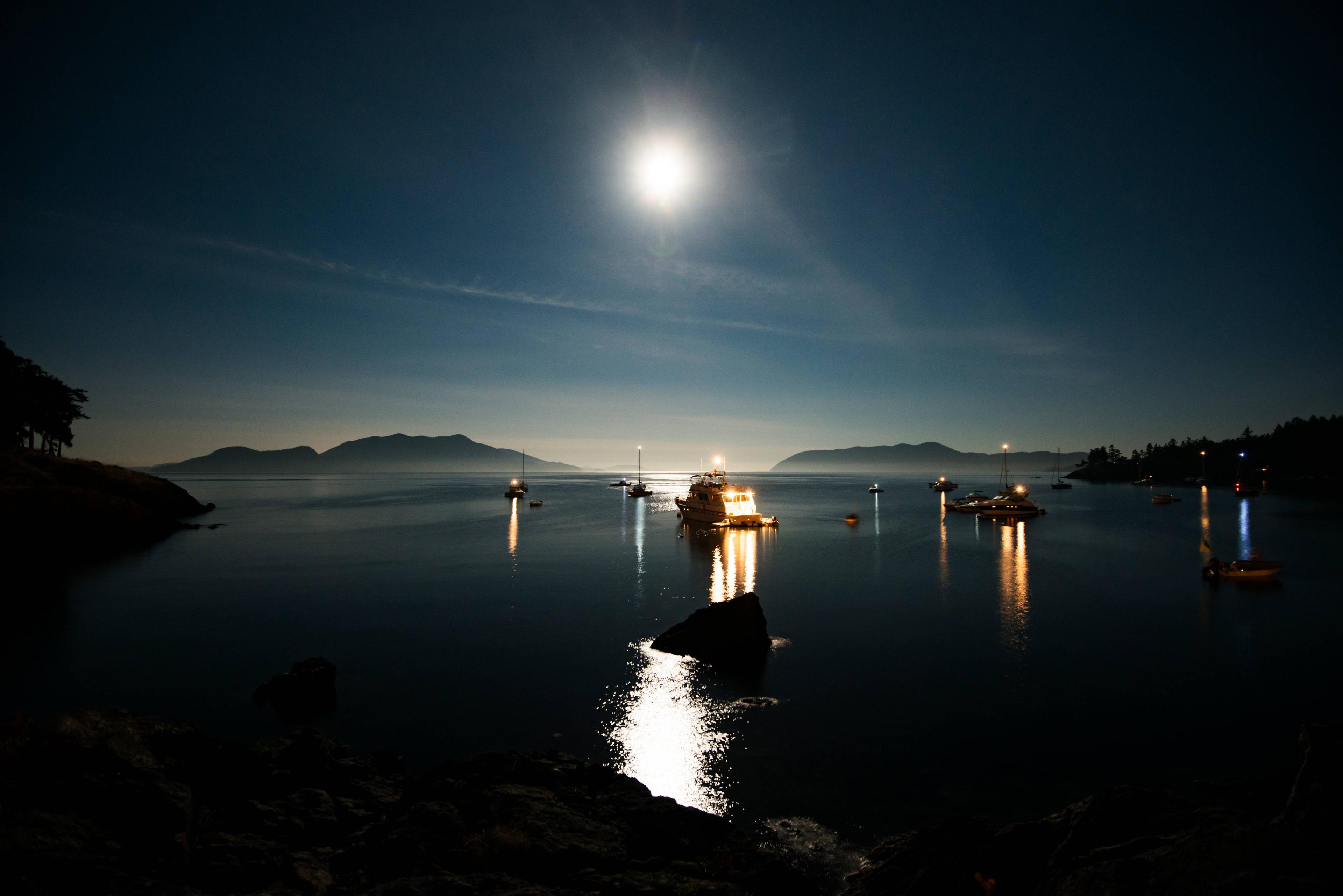
Boat navigation light types and functions lg ...

How Long does it Take to Sail Around the World lg ...
Oct 04, 2021
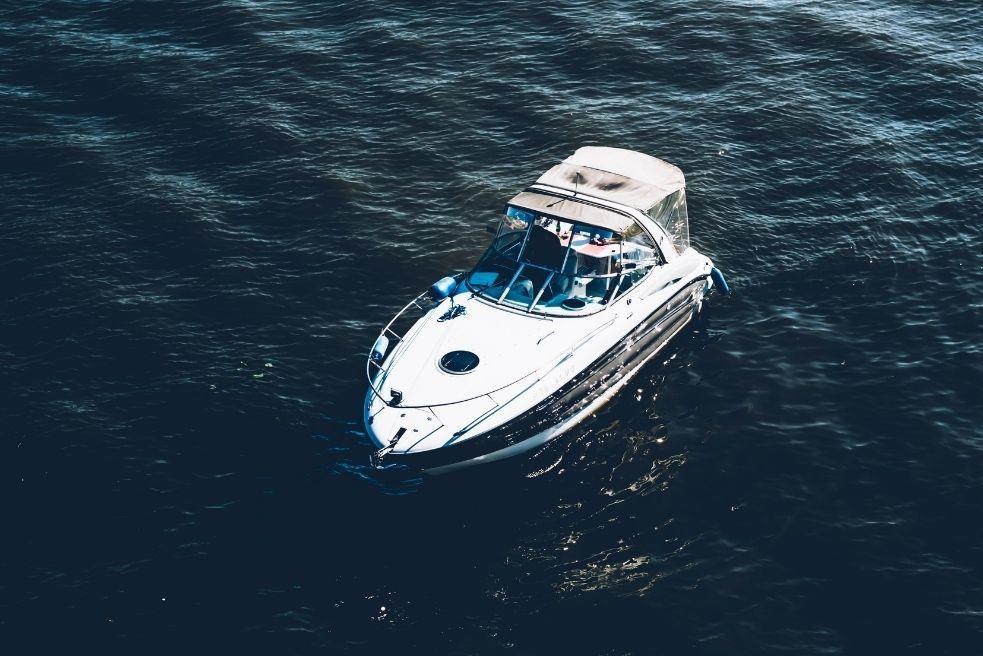
What are some Fun Things to Bring on a Boat lg ...
Oct 01, 2021
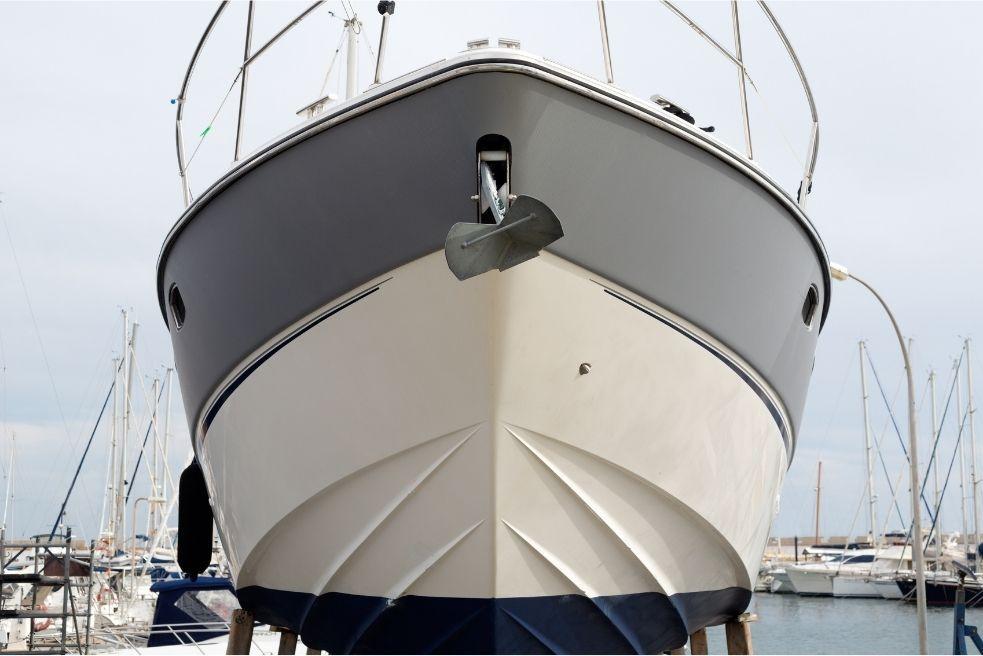
The Proper Term for the Forward End of a Boat lg ...
Sep 30, 2021
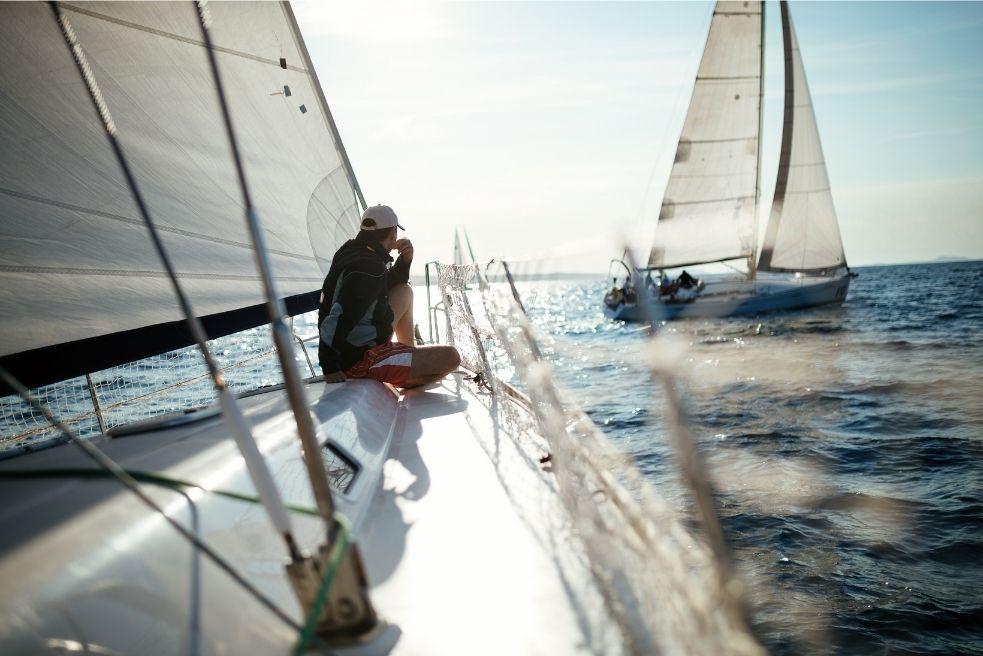
Regular Boat Maintenance Tasks You Should Always Do lg ...
Sep 17, 2021

The Evolution of Sail Boats: Discovering the Inventor and Origins
Alex Morgan
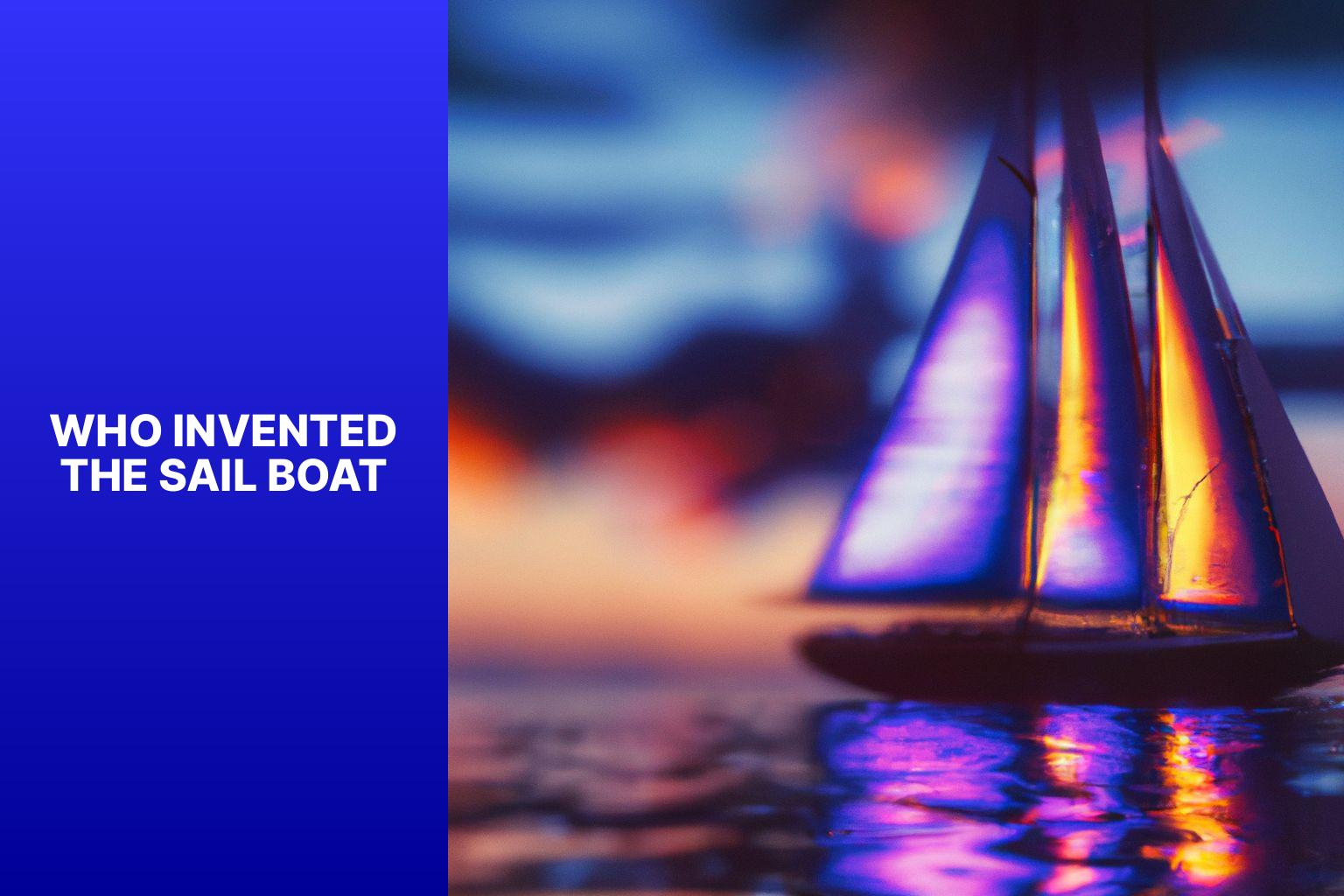
The sailboat, an incredible mode of transportation propelled by the wind, has a rich history that dates back thousands of years. The development of sailboats can be traced through various civilizations and time periods. Let’s explore the history and evolution of sailboats, from their early developments to the modern designs we see today.
Early Developments:
The concept of using sails to harness wind power for navigation has been present since ancient times. Early civilizations such as the Phoenicians, Egyptians, and Mesopotamians made significant contributions to the development of sailing techniques. These early sailboats used simple square sails and were primarily used for river and coastal navigation.
Ancient Egypt and Mesopotamia:
Ancient Egyptians and Mesopotamians were among the first civilizations to use sailboats for trade and transportation. The Nile River in Egypt and the Tigris and Euphrates Rivers in Mesopotamia provided the perfect environments for early sailing vessels to flourish.
Chinese Sailing Innovations:
In ancient China, sailors made remarkable advancements in sailing technology. They developed innovations such as the sternpost rudder, multiple masts, and watertight compartments, which greatly improved the efficiency and stability of sailboats.
Exploration and Trade:
During the Age of Exploration, sailors from different nations set sail on epic voyages, discovering new lands and establishing trade routes. Portuguese navigators, Dutch shipbuilders, and explorers from various countries played a vital role in advancing sailboat design and construction during this era.
Famous Sailboat Inventors:
Throughout history, several notable civilizations and cultures contributed to the invention and evolution of sailboats. Ancient Egyptians were known for their advanced shipbuilding techniques, while the Phoenicians were renowned for their maritime skills and expertise. Chinese inventors also made significant contributions, with their advancements in shipbuilding and navigation techniques. Portuguese navigators, such as Vasco da Gama, made groundbreaking voyages that shaped the future of sailboat travel. The Dutch, with their expertise in shipbuilding, created innovative designs that greatly improved sailing capabilities.
The Evolution of Sailboats:
Sailboats have evolved tremendously over time. From the early square-rigged sails to the introduction of lateen sails, technological advancements improved the efficiency and maneuverability of sailboats. The development of clipper ships in the 19th century led to faster and more efficient long-distance voyages. Today, modern sailboats feature advanced materials, rigging systems, and navigation technologies, making them versatile and capable of various sailing conditions.
As we explore the history and evolution of sailboats, we gain a greater appreciation for the ingenuity and skill of ancient civilizations and the continuous advancements that have shaped the sailboats we know today.
Key takeaway:
- Sail boats have a rich history: The development of sail boats can be traced back to ancient civilizations such as Egypt, Mesopotamia, and China. Exploration and trade played a major role in the advancement of sail boat technology.
- Famous inventors and contributors: Ancient Egyptians, Phoenicians, Chinese inventors, Portuguese navigators, and Dutch shipbuilders all made significant contributions to the invention and evolution of sail boats.
- The evolution of sail boats: From square rigged sails to lateen sails, clipper ships, and modern sail boats, the design and capabilities of sail boats have evolved over time to meet the needs of navigation and exploration.
History of Sail Boats
Take a journey through the captivating history of sailboats as we explore their origins and advancements. From ancient Egypt and Mesopotamia to Chinese sailing innovations, and the era of exploration and trade, each sub-section bears witness to the remarkable development of these majestic vessels. Unveiling early developments and sharing intriguing facts, this section unravels the fascinating tale behind the sailboat’s invention, inviting you to immerse yourself in the rich maritime past.
Early Developments
Early developments in sail boats can be traced back to ancient civilizations such as Egypt , Mesopotamia , and China . These civilizations were pioneers in sail boat construction, making advancements in sail boat technology using wind power and simple square sails on wooden masts for transportation, fishing, and trade. The Egyptians, with their knowledge of wind and water currents, created efficient sail boats that played a crucial role in trade and exploration as they navigated the Nile River and the Mediterranean Sea. The Phoenicians further enhanced sail boat development by introducing multiple masts and triangular lateen sails, improving maneuverability and speed for exploring new territories and expanding trade networks. Meanwhile, ancient Chinese inventors brought innovations such as the stern rudder and watertight compartments to sail boat technology, revolutionizing sail boat design and influencing future maritime technology. These early developments laid the foundation for the evolution of sailing vessels, shaping naval exploration, trade, and transportation. Studying the innovations of ancient civilizations helps us understand the origins of sail boats and their significant impact on human history.
Ancient Egypt and Mesopotamia
Ancient Egypt and Mesopotamia used sail boats for transportation, exploration, and trade. The Egyptians were skilled sailors who utilized wind power to navigate the Nile River and the Red Sea. They could travel longer distances and carry larger quantities of goods.
In Mesopotamia, sail boats were also prevalent. The Sumerians , in particular, were known for their advancements in boat-building techniques. They constructed sail boats with a keel and multiple masts for stability and efficient sailing. These boats were used for transportation and trade along the Tigris and Euphrates Rivers .
The sail boats of Ancient Egypt and Mesopotamia were made from reeds, wood, or papyrus. They used square-rigged sails attached to the mast to harness the wind’s power. These early developments in sail boat technology paved the way for future sailing innovations and exploration.
The advancements made by the ancient Egyptians and Mesopotamians in sail boat design and navigation laid the foundation for seafaring civilizations and expanded trade networks in the ancient world. Their sailing innovations continue to influence modern sail boat designs and maritime traditions.
Chinese Sailing Innovations
The Chinese were pioneers in sailing innovations, introducing various advancements that greatly improved the functionality and safety of sailboats. One of these innovations was the development of stern mounted rudder systems , which replaced the traditional side-mounted steering oars. By incorporating this innovation, Chinese sailors were able to enhance maneuverability and control of their vessels.
Another significant contribution made by the Chinese was the implementation of watertight bulkheads in their sailboats. These compartments divided the hull into separate sections, effectively reducing the risk of sinking in the event of hull damage. The watertight bulkheads not only increased the safety of the sailors but also ensured that the boat remained afloat during voyages, enhancing overall safety at sea.
The Chinese were early adopters of multi-masted ships , utilizing multiple sails and masts to increase the speed and stability of their sailboats. This innovation improved sail handling and overall performance, allowing Chinese sailors to navigate more efficiently through various wind conditions.
Among their impressive advancements, Chinese inventors also developed the magnetic compass . This invention revolutionized navigation at sea, as it provided sailors with an accurate means of determining their direction. With the magnetic compass, Chinese sailors were able to explore new maritime routes and engage in more reliable trade, contributing to the expansion of their maritime empire.
Exploration and Trade
Sail boats played a crucial role in the connection of regions and the facilitation of exploration and trade. They allowed explorers to venture into uncharted waters, expanding their knowledge and discovering new trade routes. The transportation of valuable goods like spices, silk, and precious metals by sail boats contributed to the flourishing of trade. Sail boats aided merchants in establishing trade networks, which resulted in prosperous port cities and trading empires.
Exploration and trade not only influenced economic prosperity, but also led to cultural exchanges that diffused ideas, technologies, and artistic styles. The efficiency and maneuverability of sail boats greatly improved long-distance trade, thereby boosting economic prosperity. During the Age of Exploration , sail boats played a vital role in facilitating exploration by connecting explorers with distant civilizations.
Trade via sail boats faced challenges such as storms, piracy, and unfamiliar waters. Navigational skills and cartographic advancements were crucial in aiding explorers and traders to accurately map their routes. Ultimately, the exploration and trade during this period laid the foundation for the globalization and interconnected world that we live in today. Sail boats revolutionized exploration and trade by connecting people, cultures, and economies globally.
Famous Sail Boat Inventors
From the ancient Egyptians to Dutch shipbuilders, this section delves into the fascinating world of famous sailboat inventors. Discover the innovative contributions of these historical figures as we explore the ingenuity behind their sailboat designs. With each sub-section highlighting a different group of inventors, be prepared to travel through time and across cultures to uncover the remarkable individuals who shaped the evolution of sailboats. Hold on tight as we set sail on this captivating journey of innovation and discovery .
Ancient Egyptians
The Ancient Egyptians played a significant role in sailboat history. They had a deep understanding of sailing and made important contributions to sailboat design and innovation.
The Ancient Egyptians made remarkable contributions to sailboat design and navigation. Their expertise in shipbuilding, use of square rigged sails, and development of papyrus boats greatly influenced the evolution of sailboats throughout history. The legacy of the Ancient Egyptians continues to inspire and inform modern sailboat design and technology.
Phoenicians
The Phoenicians were skilled sailors and shipbuilders who made significant advancements in sail boats. Here are some key points about the Phoenicians and their contributions:
– The Phoenicians established colonies and trading routes in the Mediterranean Sea .
– They built sturdy galleys with multiple rows of oars for propulsion.
– Phoenician ships were constructed using advanced woodworking techniques, enhancing their strength and durability .
– They developed square sails, allowing their ships to sail against the wind by tacking at an angle.
– Steering oars provided greater maneuverability and control.
– Their seafaring skills and knowledge expanded trade networks and cultural influences across the Mediterranean .
Fact: Phoenician ships played a crucial role in spreading their civilization and facilitating the exchange of goods and ideas between civilizations. They were integral to maritime history.
Chinese Inventors
Chinese inventors have made significant contributions to sailboat development. Chinese inventors like Su Song have played a crucial role in advancing sailboats and impacting maritime history. Su Song , an ancient Chinese inventor, improved the sailing compass, aiding accurate navigation. Chinese inventor Zhu Yu revolutionized shipbuilding with watertight compartments, promoting stability and preventing flooding. Another Chinese inventor, Shen Kuo , enhanced sailboat maneuverability with stern-mounted rudders. These inventions by Chinese inventors have enabled exploration and trade.
In addition to sailboats, Chinese inventors like Su Song made strides in other scientific and technological fields during the Song Dynasty, constructing the “Cosmic Engine” clock tower that provided information on celestial observations, weather patterns, and tidal movements. Chinese inventors have played a significant role in shaping the advancements in various areas of innovation.
Portuguese Navigators
The Portuguese navigators played a significant role in the history of sail boats. They were renowned for their exploration and seafaring skills. Portuguese navigators , like Ferdinand Magellan and Vasco da Gama , embarked on daring voyages to find new trade routes. They used sail boats as their primary mode of transportation. Their navigational expertise and advanced shipbuilding techniques allowed them to navigate vast oceans and reach distant lands. Portuguese navigators opened up new trade routes to Asia, Africa, and the Americas. Their contributions to sail boat development revolutionized maritime exploration and trade.
When learning about sail boat history, it’s important to recognize the pivotal role of Portuguese navigators . Their bravery, navigational skills, and shipbuilding techniques paved the way for exploring and colonizing new territories. The voyages of Ferdinand Magellan and Vasco da Gama have left a lasting impact in history. The accomplishments of these Portuguese navigators continue to inspire sailors and explorers across generations.
Dutch Shipbuilders
Dutch shipbuilders played a significant role in the evolution of sail boats. They were innovative and skilled , known for developing the fluyt , a type of sailing vessel commonly used for trade in the 17th century.
These Dutch shipbuilders were experts in constructing efficient, seaworthy, and cost-effective ships. They pioneered new building methods and designs that improved the speed and maneuverability of sail boats. Their expertise allowed them to build ships that could carry larger cargo loads , resulting in increased trade and economic growth.
The influence of Dutch shipbuilders extended beyond their country. Other maritime nations adopted their shipbuilding techniques, further advancing the industry. Dutch ships were sought after and considered some of the world’s finest at the time.
The craftsmanship and innovations of Dutch shipbuilders were crucial in shaping the history of sail boats. Their contributions paved the way for future advancements in shipbuilding technology, making sailing more efficient and accessible for exploration, trade, and transportation .
The Evolution of Sail Boats
As sailboats gracefully navigate across the open waters, it’s fascinating to explore the evolution of these majestic vessels. In this section, we’ll embark on a journey through time and delve into the rich history of sailboats. From the iconic square rigged sails to the innovation of lateen sails, we’ll unearth the stories behind these ingenious designs. We’ll uncover the allure of clipper ships and the advancements that have brought us modern sailboats. Get ready to set sail on a captivating exploration of the evolution of sailboats!
Square Rigged Sails
Passing on the task
Lateen Sails
The lateen sails were an important innovation in sailboat technology. Here are some key points about lateen sails:
– Origin: Developed in ancient Egypt and Mesopotamia, the lateen sails were first used in the Mediterranean.
– Design: Lateen sails are triangular and attach to a long yard or boom. They are rigged at an angle to the mast for better maneuverability and efficiency.
– Advantages: Lateen sails allow sailors to sail closer to the wind and harness wind power more effectively. This enhances maneuverability in narrow waterways and areas with unpredictable winds.
– Wide Usage: Various civilizations, including the Arabs, Persians, Byzantines, and later European sailors during the Age of Exploration, widely adopted lateen sails.
– Trade and Exploration: Lateen sails greatly facilitated trade and exploration, enabling sailors to travel longer distances and reach new destinations.
– Continued Influence: The impact of lateen sails can still be seen in modern sailboat designs, particularly in small recreational boats and traditional dhow sailing vessels in the Middle East.
The development and widespread use of lateen sails had a significant impact on sailboat technology and the history of navigation.
Clipper Ships
Clipper ships were renowned in the 19th century for their sleek and fast sailboats, making them the perfect choice for long-distance trade and transportation. These ships were characterized by three distinct features.
First and foremost, clipper ships boasted narrow and sharp hulls that allowed them to effortlessly slice through the water, resulting in remarkable speed. The hulls were expertly constructed using durable materials such as iron , offering increased resistance against potential damage.
Another noteworthy aspect of clipper ships was their abundance of sails. Equipped with multiple masts, these ships utilized square-rigged sails on the lower masts and fore-and-aft sails on the upper masts, including the iconic “clipper” or “racing” sails. This innovative sail configuration further amplified the ships’ speed and maneuverability by effectively harnessing wind from various angles.
Clipper ships were designed with a relatively smaller cargo capacity . This intentional limitation allowed them to prioritize their primary function of swiftly and securely transporting high-value merchandise like tea, spices, and luxury goods. By carrying lighter loads, these ships maintained their outstanding speed and performance, making them exceptionally well-suited for trade routes with stringent schedules.
Modern Sail Boats
Modern sailboats have advanced in design, technology, and performance. Key features and innovations that characterize modern sailboats include:
1. High-tech materials: Modern sailboats use lightweight and durable materials like carbon fiber and composites, enhancing performance and speed.
2. Sail designs: Advanced computer modeling and design techniques have led to efficient and versatile sails. Sail shapes and sizes can be optimized for different wind conditions, improving speed and maneuverability.
3. Efficient hull designs: Modern sailboats have sleek and streamlined hull designs that minimize drag and resistance, enabling them to glide through the water more efficiently.
4. Hydraulic and electric systems: Many modern sailboats have hydraulic and electric systems that make handling sails and other equipment easier and more efficient. This allows for precise control and adjustment of various sail functions.
5. Advanced navigation and communication systems: GPS, chartplotters, and radar systems have revolutionized navigation on modern sailboats. These systems provide accurate positioning, weather information, and route planning, enhancing safety and efficiency.
6. Integrated safety features: Modern sailboats often come equipped with safety features like man-overboard systems, emergency beacons, and liferafts, ensuring the well-being of crew members during emergencies.
When choosing a modern sailboat, consider factors such as the intended use (racing, cruising, or both), size, and desired performance characteristics. It’s important to find a sailboat that suits your specific needs and preferences.
Some Facts About Who Invented The Sail Boat:
- ✅ The first model of a ship under sail appeared in ancient Mesopotamia between 5500 and 5000 BCE. (Source: Boating Genie)
- ✅ The concept of using a sail likely started as a coincidence when someone held a piece of animal skin up to the wind and noticed it made their raft move faster. (Source: Boating Genie)
- ✅ The boat’s stability became a challenge, which was overcome with the invention of the keel, a flat blade that balanced the boat and prevented capsizing. (Source: Boating Genie)
- ✅ The development of watertight hulls allowed for the construction of larger sailing ships capable of carrying more loads. (Source: Boating Genie)
- ✅ Sailing has played a crucial role in the development of civilization, providing greater mobility for trade, food search, transport, and warfare. (Source: Boating Genie)
Frequently Asked Questions
1. who invented the sailboat and when.
Sailing boats have a long history that dates back to ancient times, but the first sailboat as we know it today appeared in ancient Mesopotamia between 5500 and 5000 BCE.
2. What materials were used to make the sails of early sailboats?
The Egyptians, one of the earliest sailing civilizations, used woven straw, linen, or hemp coated with tar to make the sails of their boats.
3. What was the role of the Water Club of Cork in the development of sailing?
The Water Club of Cork, founded in Ireland in 1720, was the first nautical club. It played a significant role in promoting and advancing sailing, marking the beginning of amateur sailing.
4. How did Chinese junk ships contribute to the history of sailing boats?
Chinese junk ships were highly advanced in terms of size, speed, strength, and maneuverability. They developed important sailing technologies such as mounted steering and the use of triangular sails, which allowed for advanced sailing maneuvers and eliminated the reliance on seasonal winds.
5. Who were the ancient mesopotamians and what was their contribution to sailing?
The ancient Mesopotamians were one of the early civilizations that used sailing boats. They played a crucial role in the evolution of civilization by developing the concept of sailing and building the first model of a ship under sail.
6. Can I experience sailing firsthand by booking a sailing day trip?
Yes, you can book a sailing day trip to experience sailing and enjoy the beauty of being on the water. Many sailing tour companies offer various options for individuals to explore sailing.
About the author
Leave a Reply Cancel reply
Your email address will not be published. Required fields are marked *
Save my name, email, and website in this browser for the next time I comment.
Latest posts

The history of sailing – from ancient times to modern adventures
History of Sailing Sailing is a time-honored tradition that has evolved over millennia, from its humble beginnings as a means of transportation to a beloved modern-day recreational activity. The history of sailing is a fascinating journey that spans cultures and centuries, rich in innovation and adventure. In this article, we’ll explore the remarkable evolution of…

Sailing Solo: Adventures and Challenges of Single-Handed Sailing
Solo Sailing Sailing has always been a pursuit of freedom, adventure, and self-discovery. While sailing with a crew is a fantastic experience, there’s a unique allure to sailing solo – just you, the wind, and the open sea. Single-handed sailing, as it’s often called, is a journey of self-reliance, resilience, and the ultimate test of…

Sustainable Sailing: Eco-Friendly Practices on the boat
Eco Friendly Sailing Sailing is an exhilarating and timeless way to explore the beauty of the open water, but it’s important to remember that our oceans and environment need our protection. Sustainable sailing, which involves eco-friendly practices and mindful decision-making, allows sailors to enjoy their adventures while minimizing their impact on the environment. In this…
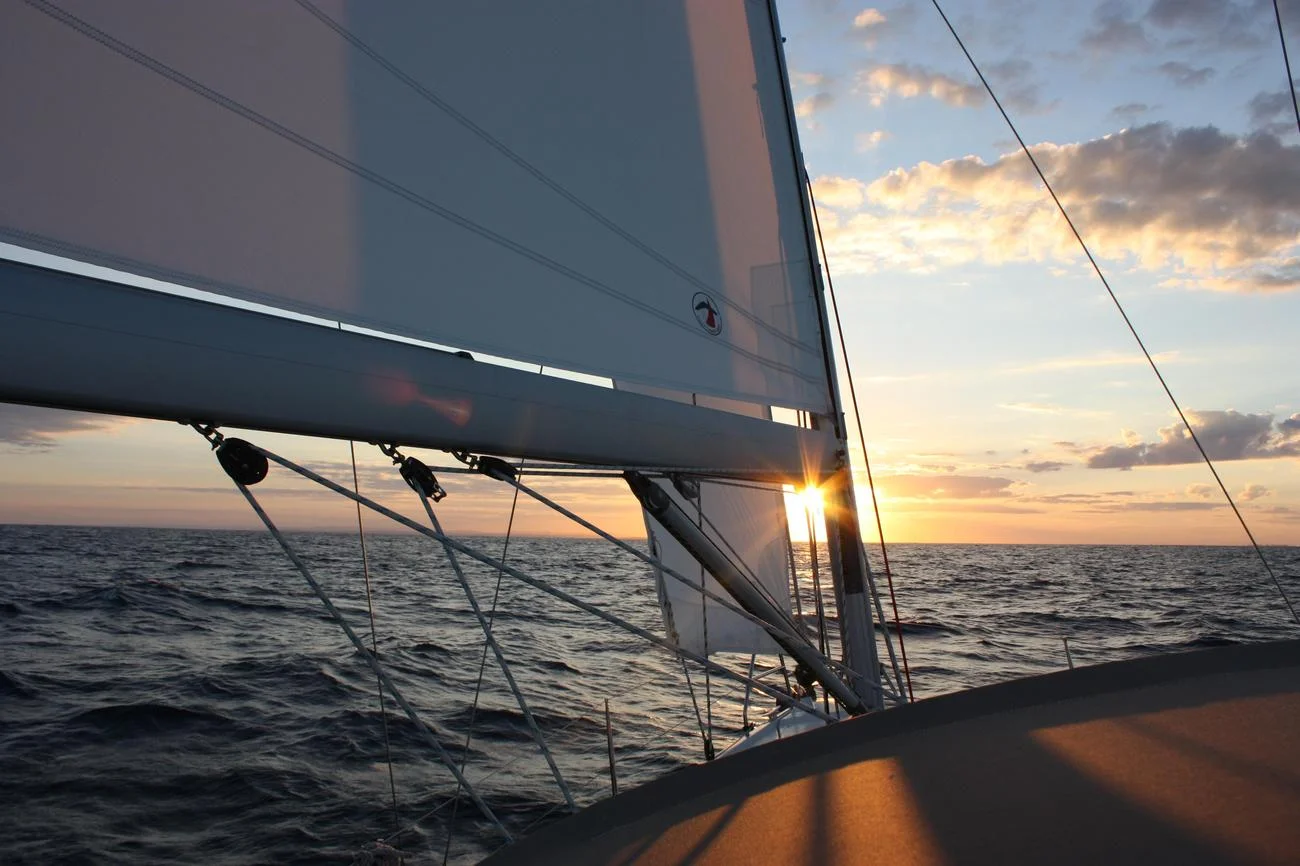
Discover Fascinating Facts About Sailboats From a Seasoned Enthusiast
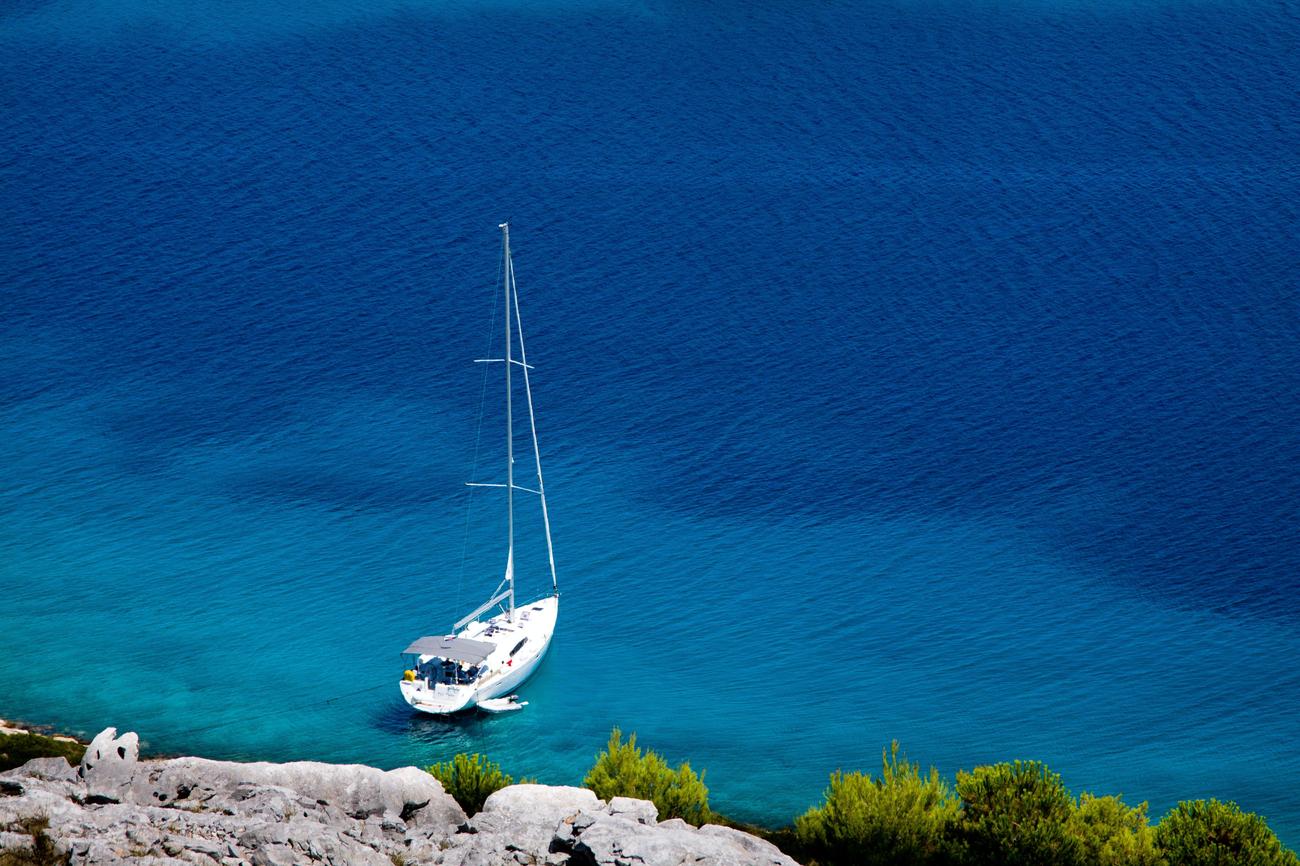
Sailing requires a unique blend of knowledge, skill, and a deep understanding of navigation and meteorology. It’s a world where adventure and freedom intertwine, captivating the hearts of those who dare to embrace the open waters. If you have ever found yourself gazing out at the ocean, wondering about the mysteries of sailboats and their remarkable abilities, then you are in for a treat. In this article, we will journey through the vast ocean of knowledge, guided by a seasoned maritime enthusiast with a wealth of experience in sailing. So fasten your life jacket and prepare to set sail as we unravel fascinating facts, mesmerizing stories, and dive into the captivating world of sailboats.
Table of Contents
Fascinating Facts About Sailboats
Ahoy, fellow sailing enthusiasts! As a seasoned sailor with a passion for all things maritime, I’m here to dive into the mesmerizing world of sailboats and uncover some intriguing facts. So, hoist the mainsail and let’s set sail on this exciting journey together!
1. Speed and Grace:
Did you know that the average sailboat cruises at a modest speed of 4-6 knots, with a top speed of 9 knots? Picture yourself gliding smoothly through the water, harnessing the power of the winds to propel you forward. It’s a truly magical feeling, as if the boat is dancing upon the ocean’s surface. But wait, there’s more! Multihulls, with their catamaran or trimaran design, can achieve impressive speeds of up to 50 knots! How? By displacing less water and harnessing gusts with finesse. Brace yourself for a thrilling ride!
“Sailboats gracefully navigate the waters, combining the forces of wind and water to achieve impressive speeds.”
2. The Trade Routes of Wind:
Now, let’s explore the origins of the term “trade winds.” Did you know that it refers to the wind roads discovered by early sailors during their voyages? These ancient mariners followed well-established paths, guided by reliable winds that sustained their journeys. These trade winds, blowing across the ocean’s surface, facilitated the exploration and expansion of cultures and commerce. Let the winds lead you to new adventures!
3. Unlocking Hidden Gems:
One of the most remarkable aspects of sailing is the freedom it affords in exploring off-limits islands and hidden coves. Some islands are inaccessible by other means, making them havens for unique flora, fauna, and captivating cultures. Picture yourself dropping anchor near a secluded paradise, dotting the endless blue expanse of the ocean. From the vibrant marine life below to the authentic villages ashore, sailboats unlock a world of discovery that few get to experience. So, set sail and uncover the hidden treasures!
4. Lessons from History:
As we delve into the intricate history of sailboats, we come across fascinating design flaws in historical vessels. Take the majestic galleons, for example. These magnificent ships, famous for their role in historical naval battles, were limited in size due to their design flaws. With the keel extending below the waterline, these formidable vessels struggled to maintain stability and safely navigate shallow waters. Thankfully, modern sailboat design has overcome these limitations, allowing us to explore the seas comfortably and safely aboard larger boats. Embrace the lessons from history and advance towards new horizons!
5. The Art of Sailing:
To truly understand sailboats, it’s essential to grasp the art of sailing itself. One key aspect is harnessing the ideal wind speed for maximum maneuverability and speed. Typically, sailboats thrive in wind speeds between 8-12 knots. This sweet spot allows sailors to trim their sails efficiently and sail close to the wind, making impressive headway while skillfully maneuvering through the sea. With the wind as your loyal companion, master the art of sailing and embrace the exhilarating freedom it offers!
“Navigating with finesse, sailboats harness the winds to glide through the water, blending grace with speed.”
With these captivating facts about sailboats, it’s clear that these vessels are not just a means of transportation but gateways to unforgettable experiences. Whether it’s feeling the wind in your hair as you speed across the ocean or discovering hidden gems in remote locations, sailboats offer endless possibilities for adventure. So, chart your course, raise your sails, and let the enchantment of the sea guide you towards the horizon!
Fair winds and following seas!
Facts About Sailboats
If you’re a fan of thrilling races and the adrenaline rush they bring, then you’ll love learning about racing sailboats. Pushing the limits of speed, racing sailboats are designed for unmatched performance on the water. Whether it’s the fierce competition or the breathtaking maneuvers, the world of racing sailboats is truly exhilarating. Discover the excitement of racing sailboats and dive into the captivating world of high-speed sailing. Click here to explore more about racing sailboats: racing sailboats .
But wait, how fast do sailboats go? Have you ever wondered how these magnificent vessels can reach such impressive speeds? Uncover the secrets of sailboat speed and prepare to be amazed. Sailboats can surprise even the most seasoned sailors with their speed capabilities. If you’re curious about how fast sailboats can actually go, click here to find out: how fast do sailboats go .
Now, let’s tackle a question that has puzzled many sailing enthusiasts—how do sailboats sail into the wind? It seems counterintuitive, but sailboats have a remarkable ability to maneuver against the wind. Discover the fascinating techniques and principles that allow sailboats to defy the wind’s direction. To unravel the mystery of sailing into the wind, click here: how do sailboats sail into the wind .
While sailboats offer an exciting and adventurous lifestyle, one might wonder how much it costs to own one of these marvels. The world of sailboat ownership presents a wide range of options, each with its own price tag. From affordable options to luxurious yachts, sailboats come in various sizes and designs to suit different budgets. If you’re curious about the cost of owning a sailboat, click here to find out more: how much do sailboats cost .
Embark on a journey of discovery and explore the captivating world of sailboats. From racing speeds that will leave you breathless to the secrets of sailing against the wind, there’s a wealth of knowledge waiting for you. Click on the links above and delve into the fascinating realm of sailboats. Get ready to be captivated by the beauty, thrill, and wonder of sailing.
Sailing requires knowledge of navigation and meteorology.
Successful sailing is not just about catching the wind and letting it carry you across the water. It involves understanding the art of navigation and having a keen awareness of meteorology. As a seasoned enthusiast, I can attest that these two skills are essential for a safe and enjoyable sailing experience. So, let’s dive into the fascinating world of sailboats and explore why knowledge of navigation and meteorology is crucial.
Navigation Techniques and Nautical Charts
Navigating a sailboat is more than pointing it in the right direction. It requires a solid grasp of navigation techniques and the ability to read nautical charts. Consider nautical charts as the sailor’s roadmap, depicting the waterways, coastlines, and important landmarks. By understanding these charts, sailors can plot their course, avoid obstacles, and safely reach their desired destinations.
“Navigating a sailboat is like embarking on an exciting journey, armed with a map that reveals the secrets of the sea.”
Weather, Safety, and Informed Decisions
While the wind is a sailboat’s driving force, understanding weather conditions is crucial for safety and efficiency. With a solid grasp of meteorology, sailors can make informed decisions about when to set sail, which routes to take, and when to seek shelter in adverse conditions. By keeping a close eye on weather patterns, wind speeds, and changing atmospheric conditions, sailors can adapt their plans accordingly, ensuring a smooth and enjoyable voyage.
“Weather knowledge grants sailors the power to predict, adapt, and navigate the ever-changing dance between wind and waves.”
Clear Communication and Course Diagrams
Clear communication is vital when sailing, especially when working as a team or navigating unfamiliar waters. Sailors rely on simple and easy-to-understand course diagrams to convey their intentions and coordinate their actions. By using universally recognized symbols and diagrams, sailors can ensure effective communication on the water.
“In the world of sailing, a picture is worth a thousand words. Clear course diagrams enable sailors to speak a common language across seas.”
Sailing Principles for All
It’s important to note that the basic principles and skills for sailboats are applicable to both small RC boats and full-sized sailboats. Whether you’re controlling a miniature vessel in a pond or commanding a grand sailboat on the open ocean, understanding navigation and meteorology remains fundamental. This knowledge opens up a world of possibilities for sailors of all scales.
“Embarking on the seas, whether with a small RC boat or a majestic sailboat, requires the same fundamental understanding of navigation and meteorology.”
Popular Sailboat Types
The world of sailboat designs is as diverse as the winds that propel them. Popular types of sailboats include the sloop, cutter, ketch, and schooner. Each design brings its own unique characteristics and features that appeal to different sailing preferences and conditions. Exploring these sailboat types can open up new horizons for enthusiasts seeking the perfect vessel for their adventures.
“Just like the winds that fill their sails, sailboat types carry the essence of sailing traditions and innovation on different waves.”
In conclusion, sailing is a remarkable pursuit that requires an understanding of navigation and meteorology. From plotting courses using nautical charts to making informed decisions based on weather patterns, these skills ensure sailors’ safety and enhance their ability to navigate the open water. So, next time you set sail, remember that you are not just harnessing the wind but also the power of knowledge that lies in the art of navigation and meteorology.
“In the realm of sailing, navigation and meteorology are the guiding stars that lead sailors towards new horizons and memorable adventures.”
Sailing Fosters a Sense of Adventure and Freedom
Ah, the open sea, with its vast expanse of water stretching as far as the eye can see. There’s something truly magical about setting sail on a sailboat and experiencing the sense of adventure and freedom that comes with it. As a seasoned maritime enthusiast, I can attest to the fact that sailing is not just a hobby or a sport – it’s a way of life that instills a deep sense of adventure and freedom in all who partake in it. So let’s delve into the fascinating facts about sailboats that make them the ultimate vessels for exploring the great unknown.
The Ultimate Escape from Everyday Pressures
In today’s fast-paced world, it’s becoming increasingly difficult to find moments of peace and solitude. But when you step onto a sailboat and set sail, all those everyday pressures simply melt away. There’s a certain tranquility that comes with being on a boat, surrounded by the gentle lapping of waves and the soothing sound of the wind rustling through the sails. It’s the perfect escape from the hustle and bustle of modern life, allowing you to disconnect and find solace in the simplicity of the sea.
“Sailing is the ultimate escape from the everyday pressures of life, offering a tranquil haven amidst the calming embrace of the sea.”
A Sense of Freedom and Speed
One of the most exhilarating aspects of sailing is the sense of freedom and speed it provides. While it’s true that sailboats may not be the fastest vessels on the water, their efficiency and ability to harness the power of the wind make them incredibly agile. As the sails catch the breeze and the boat begins to glide through the water, you can’t help but feel a surge of adrenaline as you harness the elements and embrace the full potential of your sailboat. It’s a unique feeling of freedom and speed that is unmatched by any other form of transportation.
“Sailboats may not have the speed of a motorboat, but their ability to gracefully glide through the water creates a sense of freedom and speed that is truly unparalleled.”
Exploring the Unexplored
Sailboats have the incredible ability to take you to places that are off-limits to tourists and inaccessible by any other means. With their shallow drafts and ability to navigate through narrow channels and hidden coves, sailboats unlock a world of hidden treasures and secret hideaways. Whether it’s discovering secluded islands, exploring untouched beaches, or anchoring in a picturesque bay, sailboats offer a sense of adventure and exploration that is simply unmatched.
“Sailboats open up a world of unexplored wonders, allowing you to discover hidden islands, secluded beaches, and secret anchorages that are off-limits to tourists.”
The Youngest to Circumnavigate
The world of sailing is no stranger to astonishing achievements, and one of the most remarkable is the fact that the youngest person to ever circumnavigate the globe in a sailboat was just 16 years old. This incredible feat showcases both the courage and the sense of adventure that sailing instills in individuals at a young age. It serves as a testament to the remarkable opportunities for personal growth and exploration that sailing provides, regardless of age or experience.
“The youngest person to ever circumnavigate the globe in a sailboat was a mere 16 years old, proving that sailing fosters a sense of adventure and unlocks the potential for extraordinary achievements.”
Feeling Blue to Feeling Alive
Did you ever wonder where the phrase “feeling blue” comes from? Well, it turns out it originated on a sailboat. In the days of yore, sailors used to refer to their unhappiness as “feeling blue” because the color blue was associated with feeling unwell or downcast. But when you’re out on the open sea, surrounded by the vast expanse of blue water, you quickly realize that sailing has the power to transform those feelings of melancholy into a sense of aliveness and excitement.
“From feeling blue to feeling alive, sailing has the power to turn sadness into exhilaration and transform your outlook on life.”
Sailboat Racing: An Adrenaline-Fueled Sport
If you’re looking for an adrenaline rush and a healthy dose of competition, sailboat racing is where it’s at. Sailboat racing is a popular sport that brings together sailors from around the world in a thrilling display of skill and strategy. From the intensity of tactical maneuvers to the adrenaline-fueled rush of crossing the finish line, sailboat racing offers a unique blend of adventure, competition, and camaraderie. It’s an exhilarating experience that highlights the true essence of sailing as a sport and a way of life.
“Sailboat racing combines the thrill of competition with the skill and precision of sailing, creating an adrenaline-fueled sport that embodies the sense of adventure and freedom that sailing represents.”
The Joy of Solo Sailing
Contrary to popular belief, you don’t need a crew to operate a sailboat. In fact, it’s entirely possible to sail a 100-foot sailboat all by yourself. While it may require a certain level of skill and experience, solo sailing offers a unique sense of accomplishment and independence. It’s an opportunity to truly connect with the boat, the sea, and the wind in a way that is deeply personal and profoundly rewarding.
“Solo sailing is a testament to the freedom and self-reliance that sailing fosters, allowing you to forge a bond with your boat and the elements like no other.”
Exploring the World on Your Own Terms
When it comes to sailing, the world is your oyster. Sailboats provide unparalleled access to destinations that are otherwise inaccessible to tourists. From remote islands to secluded coves, sailboats open up a world of possibilities, allowing you to navigate your own course and explore the world on your own terms. It’s a sense of empowerment and freedom that is hard to replicate in any other form of travel.
“Sailboats grant you the freedom to chart your own course, explore hidden corners of the world, and experience the thrill of uncharted territories on your own terms.”
As a seasoned enthusiast and avid sailor, I can vouch for the fact that sailing truly fosters a sense of adventure and freedom like no other activity. It’s a transformative experience that allows you to disconnect from everyday pressures, embrace the thrill of speed and freedom, and explore the uncharted corners of the world. So if you’re looking for an adventure that will ignite your sense of exploration and leave you with a lifelong passion, look no further than the world of sailboats.
So set sail, feel the wind in your hair, and let the sea guide you on a journey of discovery, adventure, and pure unadulterated freedom. Bon voyage, fellow sailors!
Sailboats: An Adventure on the High Seas
[youtube v=”pW67jy39ETw”]
Introduction
Sailboats, with their majestic sails billowing in the wind, have always captured the imagination of adventurers and dreamers alike. In this article, we delve into the world of sailboats and explore the thrill, freedom, and endless possibilities they offer. Join us as we embark on an exhilarating journey, powered by nothing but wind and a sense of adventure.
Discovering the Magic of Sailboats
Sailboats, powered solely by the wind, offer a unique way to explore the vastness of the sea. As the wind fills the sails, it propels the boat across the water, creating a sense of freedom and speed that is unparalleled. Whether cruising at an average speed of 4-6 knots or achieving top speeds of up to 50 knots in the case of multihulls, sailboats provide an exhilarating experience for all who venture aboard.
“Sailboats provide a sense of freedom and speed that is unmatched by any other form of transportation.”
Unlocking Hidden Treasures
Beyond the thrill of speed and adventure, sailboats offer the opportunity to explore uncharted territories. These magnificent vessels can reach off-limits islands and hidden coves, granting access to pristine and secluded places that are often inaccessible to tourists. Sailboats truly open up the world, allowing intrepid sailors to uncover the beauty and secrets of unexplored destinations.
“Sailboats allow for exploration of unexplored places that are off-limits to tourists.”
Sailing: A Journey of Achievement
Sailing is not just about the wind and the waves; it is a transformative experience that can inspire greatness. Take, for example, the record-breaking achievements of young sailors who have circumnavigated the globe at astonishingly young ages. Their determination and courage serve as a testament to the extraordinary feats that can be accomplished with a sailboat as a vessel of dreams.
“Sailing instills a sense of adventure and unlocks the potential for extraordinary achievements.”
A Symphony of Competition and Camaraderie
Sailboat racing combines adventure, competition, and the camaraderie of fellow sailors. It is an adrenaline-fueled sport that demands skill, strategy, and a deep connection with the sea. In these exhilarating races, sailors strive to outmaneuver their opponents, harnessing the power of the wind to propel them to victory. The thrill of the race and the bonds formed on the open water create a unique and unforgettable experience.
“Sailboat racing combines adventure, competition, and camaraderie to create an adrenaline-fueled sport.”
The Serenity of Solo Sailing
For those seeking solitude and self-discovery, solo sailing offers an unparalleled sense of accomplishment and independence. Navigating the vast ocean alone, with only the boat and the elements for companionship, creates a deep connection to the sea and oneself. Solo sailors forge an unbreakable bond with their sailboat, relying on their skills and instincts to conquer the challenges that the open water presents.
“Solo sailing offers a sense of accomplishment and independence, forging a deep bond with the boat and the elements.”
Freedom to Explore the Unknown
Sailboats grant adventurers the freedom to explore the world on their terms. With the wind as their guide, sailors venture into uncharted territories, charting their own course and embracing the thrill of the unknown. Whether it’s a leisurely coastal voyage or an epic ocean crossing, sailboats provide the means to experience the exhilaration of venturing into unexplored waters.
“Sailboats grant freedom to explore the world on one’s own terms and experience the thrill of uncharted territories.”
Sailboats offer much more than a means of transportation; they are gateways to adventure, self-discovery, and exploration. From the tranquil haven they provide to the remarkable achievements they inspire, sailboats have a way of turning the ordinary into the extraordinary. So, whether you dream of racing across the ocean or leisurely sailing along the coast, embrace the power of the wind and set sail on your own unforgettable journey with a sailboat as your companion.
“The power of knowledge in navigation and meteorology is essential for a safe and enjoyable sailing experience.”
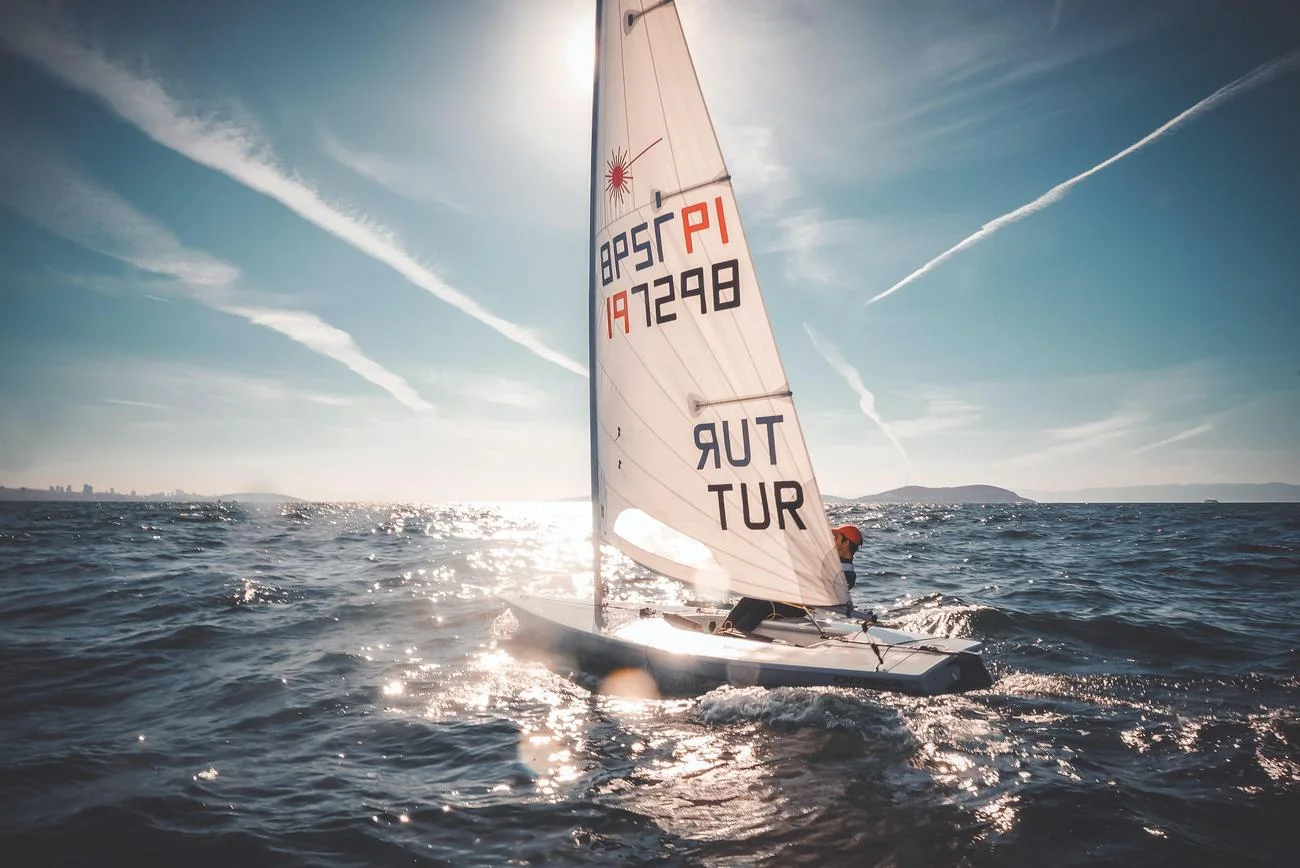
Q: What knowledge is required for sailing?
A: Sailing requires knowledge of navigation and meteorology.
Q: What does sailing offer in terms of experience?
A: Sailing fosters a sense of adventure and freedom.
Q: What is the average cruising speed of a sailboat?
A: The average sailboat cruises at about 4-6 knots and has a top speed of 9 knots.
Q: What are the popular types of sailboats?
A: Popular types of sailboats include sloop, cutter, ketch, and schooner.
Q: How young can someone sail around the world alone?
A: Girls as young as 16 years old have sailed around the world alone.
“`json
Recent Posts
- A Culinary Journey Through Time: Exploring the History of Lentils - March 19, 2024
- Who Were The First Electricians: Unraveling the Origins of a Brilliant Profession - March 19, 2024
- The History of Electricians: Shaping Societal Progress Through Electrical Innovations - March 19, 2024
Related Posts:
- Mastering the Art of Racing Sailboats: A Thrilling…
- Demystifying the Art: How Sailboats Sail into the Wind
- Unraveling Sailboat Speed: How Fast Do Sailboats Go?
- Discovering Forgotten Maritime History Facts:…
- How Much Do Sailboats Cost: Essential Insights on Prices
- Unveiling the Treasures of Maritime History:…

A Culinary Journey Through Time: Exploring the History of Lentils

Who Were The First Electricians: Unraveling the Origins of a Brilliant Profession

The History of Electricians: Shaping Societal Progress Through Electrical Innovations

Delving into the History of Lent: A Journey Through Religious Observances and Cultural Traditions

– A Short Note On History Of Mathematics: A Journey Through The Ages

A Short History of Mathematics: Tracing the Evolution of Mathematical Thought

A Short History of Mathematicians

A Short History of Mathematics

Short Biography Of Mathematicians: Unsung Heroes of the Mathematical Realm
Privacy Policy
You are using an outdated browser. Please upgrade your browser to improve your experience.

- Annapolis: 410.263.8234
- Cape Cod: 508.524.9121
- Booking Information
- Buy Cape Cod Tickets Now
Schooner 101: What do YOU know about the Schooner?
January 18, 2019
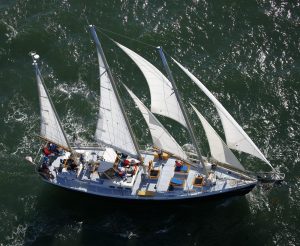
What better way to learn about schooners and sailing than to set sail aboard The Liberté in 2019?
While you may know that The Liberté is a schooner , do you know which qualities distinguish a schooner from other vessels sailing on the water? What better way to learn about schooners and sailing than to set sail aboard The Liberté in 2019? Before you set sail on this exciting adventure in the new year, consider these fun facts about the rich history and recognizable characteristics of a schooner!
Size and Qualities of the Schooner
A schooner is a sailboat built with a minimum of two masts. With this, the foremast is typically slightly shorter than the first or main mast. While a schooner may sometimes have more than two masts, most schooners contain only two. The size of the schooner enables it to sail upwind with ease, making for an enjoyable and efficient sail.
History of the Schooner
With striking similarities to many 17th-century Dutch ship designs, origins of the schooner are believed to be around New England during the early colonial period of the United States. Built for speed and efficiency in coastal sailing, the design of the schooner then led to the development of the famous Clipper ship design. With its origins in the Chesapeake Bay , the Clipper ship design grew in popularity as the descendant of the schooner.
Schooners and Pirates
Throughout its early history, the schooner was even known to be the preferred vessel of pirates! Because of their speed and efficiency, schooners were recognized as pirate ships sailing around the Caribbean, often holding more than 60 men at a time. In true pirate ship fashion, many schooners also contained nearly ten guns, with swivel guns included as well.
Schooners and the Adventure of Sailing
In addition to being an exciting piece of history, a schooner also offers a fun, first-time sailing experience! Not only is sailing a great way to get outside and enjoy the day, but it is also a special experience that can be shared with your friends and family aboard The Liberté . Plan your adventure in either Cape Cod or Annapolis for 2019, and experience the magic of a schooner this year!
Enjoy a Sail with Your Family Aboard The Liberté !
The Liberté provides private charters in Cape Cod and Annapolis as well as public sailings in Cape Cod. Celebrating aboard the magnificent Liberté is a great way to create cherished memories that are sure to last a lifetime. If you want to charter The Liberté for your next corporate event or wedding reception, contact The Liberté today! Call us today and we will be sure to respond within 24 hours. Be sure to also check us out on Facebook , Google + , and Twitter .
Categories: Uncategorized | Tags: sail , schooner , and The Liberte This entry was posted on Friday, January 18th, 2019 at 10:59 am. Both comments and pings are currently closed.
Get In Touch Now
- © 2024 The Liberté
- All Rights Reserved
- Website Design & Marketing provided by Adventure Web Interactive
Přejít k obsahu | Přejít k hlavnímu menu | Přejít k vyhledávání

- 11 facts about ships and boats that might surprise you
- < Fun facts
By Jana Brnáková February 7, 2020
By Jana Brnáková | February 7, 2020
Last update: March 26, 2021
Some are perhaps just old folks’ tales but the stories of most will definitely surprise you. There’s no denying that the vast waters of the world guard more than just one secret…
#1 my revenge.
A 14th-century French noblewoman became a privateer (a private person or a ship engaging in naval warfare) to avenge her late husband’s death.
When her husband was executed for treason by the French king, Jeanne de Clisson , also known as de Belleville or the Lioness of Brittany , patrolled the English Channel to target French ships, often killing their crew. She continued her pirate endeavors for 13 years, leaving only a few people to bear witness to her killings.
She became part of the Black Fleet and outfitted three ships which were painted black with red sails. The flagship was named My Revenge.
#2 Good luck vs bad luck superstitions

Spending weeks or months on a ship, stories and superstitions are an inherent part of the life of a sailor.
To name just a few, whistling is considered bad luck as it can bring about strong winds. In fact, the only person allowed to whistle on a ship is the cook as it means he is not eating the food.
Bananas might turn a boat’s luck ill, too. Especially when it comes to fishing boats as it is believed that if bananas are aboard, the fish won’t bite and there might be even mechanical mishaps. As soon as the hidden bananas are discovered and removed, the boat’s luck turns around.
On the other hand, cats bring good luck. British and Irish sailors would often adopt a black cat, which might sound counterintuitive as in some cultures a black cat is considered an evil omen. However, there is some logic to it as cats hunt down and get rid of rodents, who usually live on ships and might chew on ropes or eat food. This practice was even adopted by Vikings in Northern Germany between the 8th and 11th centuries.
#3 Not enough semaphore flags
#TrafalgarDay HMS Victory signals: England expects that every man will do his duty. https://t.co/QDfNHUUuqx pic.twitter.com/gwLXXtGUeG — Royal Navy (@RoyalNavy) October 21, 2018
At the beginning of the Battle of Trafalgar during the Napoleonic Wars, Admiral Lord Nelson made a now-famous call to arms to all his men, through semaphore flags.
The whole message read “ England expects that every man will do his duty” although the last word “duty” was not the original which Nelson himself wanted. Initially, he had written down “do his best”, but because of a lack of flags, they had to use “duty” instead.
Need to use the toilet on a ship? Ask for the heads instead. The name comes from the times when regular sailors went to the ship’s front — also called head or a bow — to relieve themselves. The toilets would be regularly washed out by the normal wave action.
Only the captain enjoyed his own private facility near his quarters.

The measurement that ships (and planes ) use for navigation is the nautical mile. One nautical mile per hour is called a “knot”.
The origin of the word “knot” comes from the olden days when the speed on the ships would be measured by throwing into the sea a log attached to a rope with evenly spaced knots. As the ship moved relative to the log, the number of knots during a certain period of time would be counted to measure the speed of the vessel.
The device used to measure boat speed to this day is still called the “log” even though it has nothing to do with an actual log these days.
#6 Lyubov Orlova on the loose
Sea world stories have always been full of abandoned spooky ships — perhaps not dissimilar to Lyubov Orlova who has been on the loose since 2013.
The Russian ship was commissioned during the times of Yugoslavia and used mainly for expeditions to Antarctica. A few years ago, it broke loose from a tugboat during a storm and has been drifting across the North Atlantic ever since. Some people believe the ship is taken over by cannibalistic rats… but be it either way, the dark and quiet vessel roaming around in the international waters has been labeled as dangerous by some.
#7 “Cold enough to freeze the balls off a brass monkey”

The phrase, “cold enough to freeze the balls off a brass monkey” comes from the times of old warships.
The “balls” refer to cannonballs that were made of iron. They were kept on a square brass tray called a “monkey”. In very cold weather, the brass would contract in size, so a square pyramid of cannonballs that was made on it would literally fall off. The reason they were kept on brass was the fact that iron rusts very fast, and it wouldn’t be a good idea to have your cannonballs rusting into the thing they were lying on.
#8 Quarantine
The noun quarantine comes from Italian quaranta giorni or forty days. It comes from the Venetian policy of quarantining ships from plague-stricken places for 40 days, ensuring no one infected is on board.
From the 17th century onwards, the term was extended to “any period of forced isolation”.
#9 Swedish Vasa
View this post on Instagram A post shared by Vasamuseet / The Vasa Museum (@vasamuseet) on Oct 18, 2020 at 4:16am PDT
She was salvaged of most of her valuables and left in what is now a busy lane just outside of Stockholm harbor until the late 1950s. Since 1988 it has been placed in the Vasa museum in Stockholm .
#10 The tale of Hugh Williams
We might never find out whether the tale of unsinkable Hugh Williams is true or not at all.
In 1664, a ship sank in the Menai Strait just off the coast of Wales . But one of the 81 passengers survived: Hugh Williams. More than a hundred years later, in 1785, another ship sank in the Menai Strait and, again, from the 60 passengers aboard, only one survived — Hugh Williams. To add more mystery to the tale, the year 1820 marked the third instance of sinking in the Strait, with the only survivor being Hugh Williams.
#11 Youngest person to sail around the world
The 14-year-old Laura Dekker set out in 2012 to sail solo around the world. 518 days later, she arrived in Simpson Bay, Sint Maarten in a 12.4-meter two-masted ketch called Guppy. At the age of 16, she became the youngest person in the world to solo circumnavigate the world.
Did you enjoy reading this article? Next you can try White Shark Café and other surprising facts about world’s oceans or browse Kiwi.com Stories for more articles.
Popular routes on Kiwi.com
- Cheap flights from Dubai to London
- Cheap flights from Vilnius to Tenerife
- Cheap flights from Nairobi to Eldoret
- Cheap flights from Tenerife to Vilnius
- Cheap flights from London to Prague
- Cheap flights from Barcelona to Tenerife
- Cheap flights from London to Athens
- Cheap flights from Cairo to Dubai
- Cheap flights from Berlin to Istanbul
- Cheap flights from Istanbul to Baku
- Cheap flights from London to Warsaw
- Cheap flights from London to Lisbon

Dublin on a budget: 10 ways to save money when you visit
Travel on a budget to the capital of Ireland and discover money-saving tips, hidden gems, local knowledge and great deals on food, drink, sightseeing and more

Visit Portugal: see the best of everything this spring
Kiwi.com brings you the best of Portugal: top city breaks, stunning scenery, wonderful walks, beautiful beaches, springtime celebrations, lovely weather, and much more

5 destinations to visit when you’re young and broke
Where are some of the best places to travel to if you’re young and on a budget? We’ve looked at some Gen Z travel habits and picked five of the cheapest and most inspiring destinations in Europe and Asia

Singapore on a budget: 10 ways to save money as a tourist
From street food to hidden attractions, insider secrets and affordable adventures, master the art of budget travel in Singapore with our money-saving tips

Save money on flights and the unexpected with Kiwi.com and AXA travel insurance
If you can have a flight for less, you buy it – that’s a no-brainer! And if, for the money you saved, you can get travel insurance that might well save you from future unexpected costs, you’ll consider adding it to your booking. Especially when it covers not just medical expenses and assistance, but also baggage, liability, flight delays, and even cancellations

World Travel Hackers: Students save over €7,000 on an Asian backpacking trip
Get top travel money tips, find out how to get the most out of long layovers, and learn how two of our World Travel Hackers spent less than €2,000 each on a four-week adventure in Asia

Jana Brnáková

Los Angeles on a budget: 10 ways to save money when you visit

Take the stress out of travel: World Travel Hackers on insurance from Kiwi.com and AXA travel insurance

Bank holiday dates and destinations for 2024 (UK)
10 Facts about Boats
Find Facts about Boats in the following post below. Have you ever ridden a boat before? It must be an interesting activity to do with your family and friends during the summer season. You can enjoy the warm sunny beach while enjoying a cup of tea from the deck. It will be interesting to travel with boats for you can enjoy the amazing beach. Here are other interesting facts about boats for you:
Facts about Boats 1: the small boats
The small boats are often used by the people in the protected coastal areas, lakes, river or small inlands.
Facts about Boats 2: what is a boat?
Have you ever seen a boat before? It is a mean of transportation used to travel on the water. It is made to float on the water.

Facts about Boats 3: the naval term
If you check out the definition of boat based on the naval term, it can be defined as a vessel which can be carried by another vessel.
Facts about Boats 4: the different types of boats
Boats are available in different styles, shapes, designs, and sizes. The boat is constructed based on the purposes. The materials used in the boats are based on the budget and quality.

Facts about Boats 5: the traditional type of boat
Facts about boats 6: the pleasure boats.
There are several boats created for pleasure activities. Those include the sailboats, ski boats and pontoon boats.
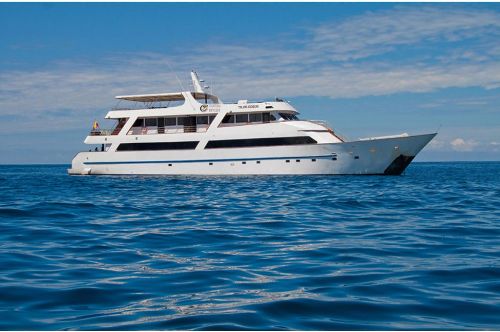
Facts about Boats 7: the house boats
If you like to enjoy the water for some time, you can live on the house boats. It can be long term housing or just for vacationing.
Facts about Boats 8: the life boats
The life boats are made for rescuing people. You can see the life boats in very big vessels. Find out bicycle facts here.

Facts about Boats
Facts about Boats 9: the power
The power to move the boat can be powered by human or machine. The kayaks, canoes, and gondolas are some examples of human powered boats
Facts about Boats 10: the non human powered boats
The sails are used to power the sailboat. The engine is used to power the motorboats. If you want to ride the motorboats, you can use the ski boats. It only takes one or two skiers. Actually the people can also relay the boat propulsion on the water jet, air fans, or even wind power. Get facts about air balloons here.

Traditional Boat
Do you like reading facts about boats ?
Related For 10 Facts about Boats
10 Facts about Costa Concordia
Facts about Costa Concordia elaborate the detail information about cruise ship. The Fincantieri’s Sestri Ponente yards built this Concordia

10 Facts about Dubai Airport
Facts about Dubai Airport will remind the people with the main airport located in Dubai, United Arab Emirates. Based

10 Facts about Airships
Check out another mean of transportation in Facts about Airships. An airship has its own power which can be

10 Facts about Corvettes
Facts about Corvettes inform you about a small warship. In traditional definition, it is often called as the smallest

Press ESC to close

30 Interesting Facts About Ships and Boats
Here are 30 Interesting Facts About Ships and Boats.
1-5 Facts About Ships and Boats

1. A Frenchwoman, Jeanne de Clisson, became a pirate in the 1300’s to revenge her husband’s death who was beheaded. She sold her lands to buy 3 ships. They were painted black with red sails. She hunted French ships, caught nobles, whom she personally beheaded with an axe. – Source
2. In 1812, an American ship rescued a British crew stranded on an island. While the Americans went out to search for food for the extra crew, the British took over the ship and left the Americans stranded on the island. – Source
3. A man who survived the fire and sinking of a ship in 1871, left him emotionally scarred. About 41 years later, he finally was able to overcome his fears and nightmares, deciding to sail again, only to die in the sinking of a new ship, the Titanic. – Source
4. In 1861 a slave took over a confederate ship and delivered it to the Union. He later was given the ship to command during the Civil War. After the war, he bought the house he was a slave in, and became a US congressman. – Source
6-10 Facts About Ships and Boats

6. Despite never having received naval training or participating in naval combat prior to the war, and constantly being outnumbered and out-supplied, Admiral Yi Sun Shin defeated 333 Japanese ships with only 13 Korean ships at the Battle of Myeongnyang. – Source
7. While shooting Pirates XXX on a ship in Florida, the ship owner was told the movie was a “Disney film for families.” – Source
8. A treasure hunter named Tommy Thompson located a ship that sank in 1857 called the SS Central America. The ship carried several tons of gold, and in 1987, he recovered over $1 billion worth of gold from it. He never paid back his crew or investors, and hasn’t been seen in years. – Source
9. The real crew on the Captain Phillips’ ship say that he is a fraud, he endangered them, the film is a lie, and they sued for “willful, wanton and conscious disregard for their safety.” – Source
10. There is an old abandoned Russian cruise ship roaming international waters since 2013. – Source
11-15 Facts About Ships and Boats

11. A ship named Baychimo abandoned off the coast of Alaska in 1931 was spotted, still adrift in the Arctic, in 1969. – Source
12. Swedish warship Vasa sank in 1628 and was recovered from the ocean in 1961 almost completely intact. This is the only remaining intact ship from the 1600’s. This ship is housed in The Vasa Museum in Stockholm Sweden, a museum built around the ship. – Source
13. Chunosuke Matsuyama, a Japanese Seamen, sent a message in a bottle in 1784 that his ship had wrecked. It washed up in 1935 in the village where he was born. – Source
14. A ferry sank in the Baltic Sea in 1994. The ship and 852 passengers are still at the bottom of the sea, and it is illegal to dive to it. – Source
15. After France refused to deliver five missile boats Israel bought from them, Israel executed a heist to steal the boats and piloted them back to Israel. – Source
16-20 Facts About Ships and Boats

16. In 2004, a party yacht tipped over when the passengers all moved to one side of the boat as it passed a nude beach in Texas. – Source
17. In 2005, a tour bus driver for the Dave Matthews Band released the bus’ septic tank over a grate above the Chicago River. A boat full of sightseers was below at the time, and its passengers were covered with 800 lbs of human waste. – Source
18. Archimedes developed an anti-ship weapon called the Claw of Archimedes. It lifted a ship by the prow then dropped it, often causing the vessel to capsize or at least severely damaging it. – Source
19. During WW2, a Dutch warship was disguised as a tropical island to escape detection by the Japanese. It was the only ship of its class to survive. – Source
20. An intact steamboat from 1856 was excavated in 1988 under 45 feet of dirt in a farmer’s field. Thousands of artifacts were excavated and preserved so well that some of the food was still edible. – Source
21-25 Facts About Ships and Boats

21. In 2004, a study was published showing that retiring to a cruise ship was often as cost effective as retiring to a retirement home and was more effective in providing quality of life. – Source
22. In 2012, an Air Canada flight took a detour to find a stranded Australian yacht. The passengers of the Boeing 777 found the yacht only 25 minutes after the distress beacon was activated. – Source
23. Edgar Allen Poe wrote a novel in 1838 about a shipwreck where the survivors ate one of their own, Richard Parker. About 46 years later, a yacht called the Mignonette sank, leaving 4 survivors. They too ate one of the survivors, a cabin boy named Richard Parker. – Source
24. One of the mightiest pirates that ever lived was a Chinese female prostitute named Ching Shih. She controlled 1,800 ships and 80,000 sailors. – Source
25. When researchers from Texas State University, studying the 17th century pirate Captain Morgan ran out of funds while attempting to retrieve artifacts from his sunken ships off the coast of Panama, none other than the Captain Morgan rum company granted them money to continue their work. – Source
26-30 Facts About Ships and Boats

26. Whenever a pirate stopped a merchant ship, it was not uncommon for a handful of merchant crewmen to join the pirates. – Source
27. Over a period of 200 years, 3 ships perished at the same location of the coast of Wales, on the same day (December 5th) and all three had only one survivor. The 3 survivors all had the same name: Hugh Williams. – Source
28. In 2013, the chef of a sunken ship survived for 3 days under the ocean after taking refuge in an air pocket of the ship.- Source
29. Quarantine comes from the Latin word for 40, which was the number of a days a ship had to wait to dock because of the plague. – Source
30. During the Battle off Samar, a single American destroyer charged forward against a huge Japanese force. The ship did so much damage to the Japanese that when she sank, a passing Japanese ship saluted the sinking vessel. – Source
Categorized in:
Last Update: November 9, 2021
Related Articles

What Bartenders Know: Mastering the Alchemy of Drinks

How to Find the Right Supplements for Your Needs: A Guide

DIY Cabinet Magic: Advice for Building Your Own Storage Solutions

10 Mind-Boggling Facts About the World’s Most
Leave a reply cancel reply.

IMAGES
VIDEO
COMMENTS
No, it's actually the other way around. 1. Sailboats are slow (but efficient) The average sailboat cruises at about 4-6 knots, (4-7 mph or 7-11 km/h) and has a top speed of 9 knots (10 mph or 17 km/h). It's just not that fast. That isn't to say there aren't any quick boats: they can be incredibly fast.
A sailboat works by harnessing the power of the wind with its sails. As the wind fills the sails, it creates lift, propelling the boat forward. By adjusting the angle of the sails and manipulating the rudder, sailors can control the direction and speed of the boat. 3. What are the essential parts of a sailboat?
Top 10 Facts About Sailboats The Ideal Wind Speed For Sailing Is Between 8-12 Knots. The ideal wind speed for sailing is between 8-12 knots. This is because the boat needs to be able to move through the water, but also because the wind needs to be strong enough to fill the sails. If the wind is too strong, the sails can be damaged, and if the ...
Sailboats do not move very fast but are highly efficient for any type of sailor. With a maximum speed of four to six knots, equivalent to 4-7 mph (6.4-11.3 kph), they are pretty slow but can continue the journey throughout the day and night, making them very efficient. However, this does not apply to all sailboats.
A sailboat, sailing boat or yacht is a boat that has sails. Wind blows against the sails, pushing the boat through the water. The word covers many kinds of boats, from small sailboards to large sailing ships.Usually, a sailboat has two sails: a mainsail and a head sail or jib. When the wind blows from behind, there can be used an extra sail, a spinnaker.
10. The world-record sailing speed is 65.45 knots or 121km/h. Last but not least, we will end this blog with one of the exciting facts about sailing - the world-record sailing speed. As of November 2012, the fastest sailing speed on record is 65.45 knots or over 120 kilometers per hour!
The boat comes with the signature galvanized steel grid found on X-Yacht models adding strength and rigidity to the frame for use in rough water conditions. X-Yachts X4.6. The boat features a self-tacking jib for easy coming about and total control of the vessel in turns. You get twin helms and an open cockpit design for racing or cruising.
The most common kind of sailboat is the sloop, as it's simple to operate and versatile. Other common sailboat types include the schooner, cutter, cat, ketch, schooner, catamaran, and trimaran. Other sailboat variations include pocket cruisers, motorsailers, displacement, and shoal-draft vessels. The information found in this article is sourced ...
13. Some boats, meanwhile, are seriously built for speed. In November 2012, the Australian Paul Larsen set the fastest sailing speed of 65.45 knots or over 120 kilometers per hour with the specially-designed Sail rocket 2. He managed to set this record in breezy conditions in the waters of Namibia. 14. Some boats aren't built for solo travel.
The typical sailboat travels at a speed of 4-6 knots (4-7 mph or 7-11 km/h) with a peak speed of 9 knots (10 mph or 17 km/h). It's just not possible. That doesn't suggest that fast boats don't exist; they can be swift. Multihulls, in particular, have to move a lot less water. They had a top speed of 50 knots (almost 60 mph or 93 km/h).
The surprising facts about modern boat design are the use of advanced materials, computer-aided designs, hydrodynamic hulls, wind tunnel testing, and articulated rudders. The modern boat design also incorporates wing sails, and twin rudders, among other innovative designs. As a sailing enthusiast, I possess a deep understanding of the ...
Sailboats have been in use for centuries, and are still a popular way to travel the seas and explore the world. Here are some important facts about sailboats: 1. The first sailboats were developed in ancient Egypt and Greece, around 4,000 years ago. They were used for fishing, trade, and transportation. 2.
8. "Quarantine" and its origins. Did you know that the word "Quarantine" is strongly related to boating? The word itself comes from Latin and it meaning is "forty days". This was the number of a days a ship had to wait to dock because of the plague. So, these are just s couple of the fun things we did talk about that during our trip.
The fastest sailing boats can reach incredible speeds. Modern racing sailboats, such as the hydrofoil boats used in the America's Cup, can reach speeds of up to 50 knots (92.6 kilometers per hour). These high-performance boats are built for optimal speed and maneuverability.
less than a min. Boats are very interesting vessels. Here are some fun facts about boats that you might not have heard about. Good luck and back luck omens are different on a boat than on dry land. For instance, whistling on a boat is expected to bring upon strong winds and is therefore considered bad luck. Bananas on a boat are also seen as ...
Sail boats have a rich history: The development of sail boats can be traced back to ancient civilizations such as Egypt, Mesopotamia, and China. Exploration and trade played a major role in the advancement of sail boat technology. Famous inventors and contributors: Ancient Egyptians, Phoenicians, Chinese inventors, Portuguese navigators, and ...
Fascinating Facts About Sailboats. Ahoy, fellow sailing enthusiasts! As a seasoned sailor with a passion for all things maritime, I'm here to dive into the mesmerizing world of sailboats and uncover some intriguing facts. So, hoist the mainsail and let's set sail on this exciting journey together! 1. Speed and Grace:
A schooner is a sailboat built with a minimum of two masts. With this, the foremast is typically slightly shorter than the first or main mast. While a schooner may sometimes have more than two masts, most schooners contain only two. The size of the schooner enables it to sail upwind with ease, making for an enjoyable and efficient sail.
The sailboat is a form of transportation, a type of recreation ranging from simple craft to the most elaborate racing yacht, and even a form of housing. A huge yacht with custom fittings and a crew is a symbol of wealth. A one-person boat with a tiny sail represents freedom.
Here are 10 interesting facts about sailing: The oldest known representation of a ship under sail dates back to 5500 BC in ancient Egypt . The world's largest sailing yacht is the Azzam, measuring 590 feet in length.
In fact, the only person allowed to whistle on a ship is the cook as it means he is not eating the food. Bananas might turn a boat's luck ill, too. Especially when it comes to fishing boats as it is believed that if bananas are aboard, the fish won't bite and there might be even mechanical mishaps. As soon as the hidden bananas are ...
Facts about Boats 9: the power. The power to move the boat can be powered by human or machine. The kayaks, canoes, and gondolas are some examples of human powered boats. Facts about Boats 10: the non human powered boats. The sails are used to power the sailboat. The engine is used to power the motorboats.
16-20 Facts About Ships and Boats. 16. In 2004, a party yacht tipped over when the passengers all moved to one side of the boat as it passed a nude beach in Texas. - Source. 17. In 2005, a tour bus driver for the Dave Matthews Band released the bus' septic tank over a grate above the Chicago River.